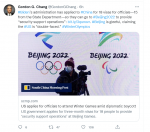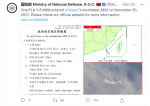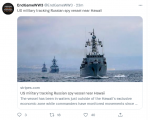You are using an out of date browser. It may not display this or other websites correctly.
You should upgrade or use an alternative browser.
You should upgrade or use an alternative browser.
ALERT The Winds of War Blow in Korea and The Far East
- Thread starter northern watch
- Start date
northern watch
TB Fanatic
PLEASE tell me that Trump had been working on MUCH of the activities in your post, HC. These are the sorts of things that can't really wait to be done when the other side has moved.
A lot of things change or can be changed in a year.....
jward
passin' thru
NK NEWS
@nknewsorg
7m
South Korea's Ministry of National Defense released its 2022 operation plan last week. The annual assessment called for maintaining intelligence sharing with the U.S. and boosting North Korea monitoring operations in response to new weapons technologies.
View: https://twitter.com/nknewsorg/status/1475451516077105157?s=20
jward
passin' thru

Indo-Pacific News - Watching the CCP-China Threat
@IndoPac_Info
1m
New #Chinese regulation outlining penalties for illegal fishing activities in their waters If foreigners are found fishing in #China claimed EEZ or continental shelf, the China Coast Guard can expel them, seize their catch & fishing equipment & fine them up to 400,000 RMB.
View: https://twitter.com/IndoPac_Info/status/1475685551105662976?s=20
Jaybird
Veteran Member
They just keep pushing. Need to start sinking Chinese fishing vessels wherever they are found intruding which is everywhere.
Indo-Pacific News - Watching the CCP-China Threat
@IndoPac_Info
1m
New #Chinese regulation outlining penalties for illegal fishing activities in their waters If foreigners are found fishing in #China claimed EEZ or continental shelf, the China Coast Guard can expel them, seize their catch & fishing equipment & fine them up to 400,000 RMB.
View: https://twitter.com/IndoPac_Info/status/1475685551105662976?s=20
jward
passin' thru
H I Sutton
@CovertShores
2h
BREAKING: Possible Fire Aboard Chinese Navy (PLAN) Warship, Qingdao, China .-> http://hisutton.com/OSINT-Fire-Chinese-Warship.html
Qingdao is were one of #China's aircraft carriers is based. The warship appears destroyer sized or bigger. This pier is often used by destroyers and replenishment ships
View: https://twitter.com/CovertShores/status/1475845506693840902?s=20
@CovertShores
2h
BREAKING: Possible Fire Aboard Chinese Navy (PLAN) Warship, Qingdao, China .-> http://hisutton.com/OSINT-Fire-Chinese-Warship.html
Qingdao is were one of #China's aircraft carriers is based. The warship appears destroyer sized or bigger. This pier is often used by destroyers and replenishment ships
View: https://twitter.com/CovertShores/status/1475845506693840902?s=20
jward
passin' thru
Japan Wants To Arm Its Submarines With Long-Range Cruise Missiles: Report
The missiles would offer land-attack and anti-ship capabilities and would be expected to serve as a deterrent to China and North Korea.
By Thomas Newdick December 30, 2021
Recent reports indicate that Japan is considering introducing a new long-range cruise missile capability to its existing submarine fleet, or future submarines, with a weapon that would have a range of over 620 miles and would be fielded from the latter half of the 2020s. The indigenous missile would provide the Japan Maritime Self-Defense Force, or JMSDF, with a new standoff capability to attack both enemy surface warships and land targets and is clearly seen as a potential counter to offset growing threats from China and North Korea.
A report in Japan’s Yomiuri Shimbun newspaper cites several unnamed government officials who confirm that Tokyo is looking at the possibility of equipping current and/or future JMSDF submarines with long-range cruise missiles. These would be derived from the Type 12 subsonic anti-ship missile that’s already in service with the Japan Ground Self-Defense Force, or JGSDF, and which has a range of around 124 miles in its current form. At this stage, both vertical launch system (VLS) and torpedo-tube-launched options are being examined for the new missile. As it stands, the JMSDF does not have any submarine-based VLS in service. There is also currently no confirmation of the size of magazine capacity being considered for the missile-armed submarines.
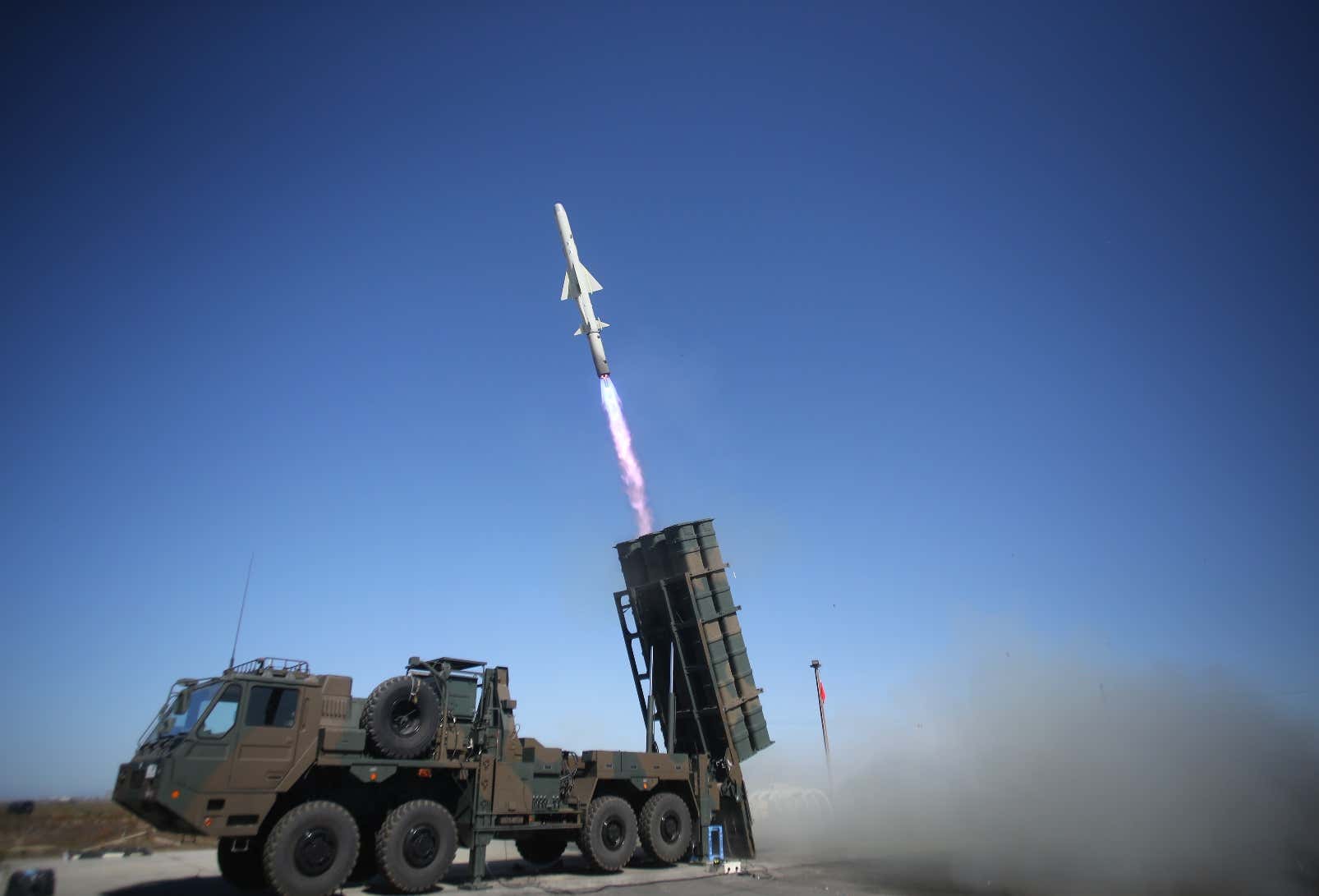
JGSDF
Test-firing of a Japan Ground Self-Defense Forces Type 12 anti-ship missile.
The Yomiuri Shimbun report stresses the potential for JMSDF submarines armed with the new cruise missiles to attack ground targets, in particular “enemy missile launch bases for the purpose of self-defense.” However, an accompanying graphic shows a submerged submarine using the same weapon to target a hostile surface combatant, as well. Indeed, the article suggests that the anti-ship version of the missile would actually be introduced first, “to counterattack enemy ships from outside the missile range of the opponent,” before the same weapon is further adapted for “attacking enemy bases in the future.” Ultimately, it would seem likely that a single missile would be furnished for both anti-ship and land-attack roles, as is the case with the Tomahawk Block IV, or the Norwegian-designed Joint Stike Missile (JSM), which Japan has procured for its F-35 stealth jets.
The emphasis on “self-defense” reflects the need for the Japanese military to at least frame capabilities such as these within the context of the country’s constitution, which rules out offensive action. However, the reality around this provision is fast degrading, with significant recent developments including acceptance of fixed-wing-capable aircraft carriers.
A precise timeline for the development of the new long-range cruise missile has not been revealed, although planned service entry toward the end of this decade seems ambitious, especially considering the VLS containers would have to be retrofitted to existing boats, space permitting, or otherwise installed in still-to-be-launched submarines. It is worth noting that South Korea is currently understood to be working on building Dosan Ahn Changho class submarines with progressively increased VLS cells, starting with six and working up to 10, which will accommodate cruise missiles or ballistic missiles. This kind of step-by-step approach might be an option for Japan, too, as would opting for torpedo tube-launched missiles on older boats and VLS in new-construction hulls.
The JMSDF’s submarines are already equipped with Harpoon anti-ship missiles that are launched from standard torpedo tubes, but they have a much shorter range than is anticipated for the new weapon and no land-attack capability. The latest UGM-84L Harpoon Block II in JMSDF service can reach targets out to around 80 miles.
The report states that Prime Minister Fumio Kishida aims to include the “capacity to attack enemy bases” in the country’s next National Security Strategy, which is due to be published late next year, and which will set out Tokyo’s medium to long-term guidelines for defense and foreign policies. Submarine-launched missiles would be one way of achieving that goal. With the JMSDF operating a fleet of 22 conventionally powered submarines, and with at least two more to be added in the future, there are potentially plenty of hulls that could be adapted. However, an air-launched or ship-based land-attack cruise missile would also seem to fit this requirement.
On the other hand, work is already underway to extend the range of the truck-launched Type 12 anti-ship missile as well as to adapt it for potential air launch by Japan Air Self-Defense Force, or JASDF, F-15J fighter jets, as part of an upgrade for these aircraft.
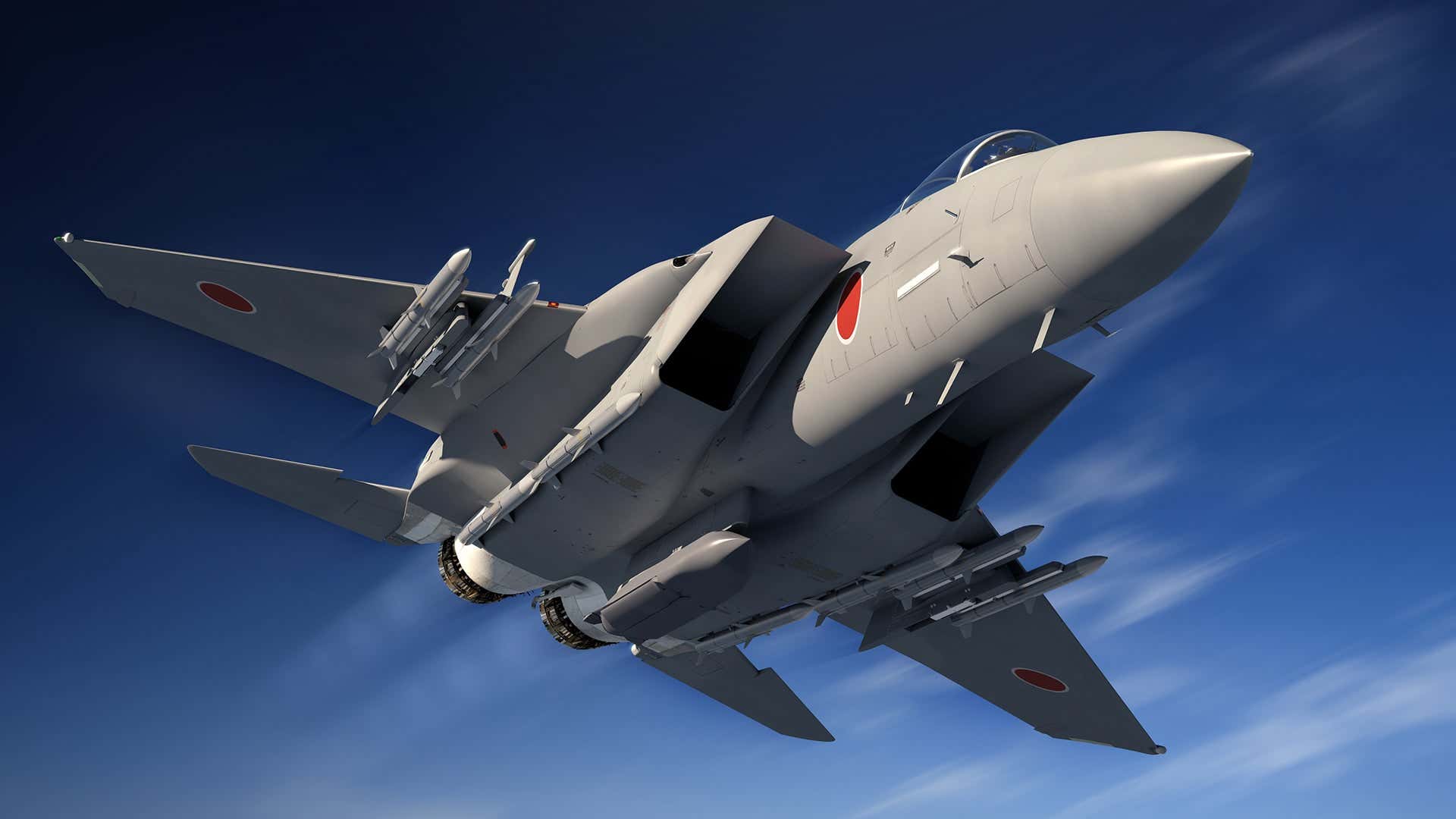
BOEING
An artist’s impression of an upgraded Japanese F-15J carrying an AGM-158 Joint Air-to-Surface Standoff Missile (JASSM) on its centerline. This is one option for a long-range missile that could be added as part of the F-15J upgrade.
Initial work on an extended-range Type 12 began back in the 2018 fiscal year, but, in December last year, it was reported that Tokyo had decided to embark on a related redesign of the missile, adding larger flying surfaces and a powerplant optimized for high-altitude flight, as well as additional fuel. That would increase the range from the current 124 miles to 560 miles, and, later, up to 930 miles. Even with the initial range extension, the new weapon would be in broadly the same category that’s required for the new cruise missile. Importantly, the revised Type 12 would also be capable of hitting ground targets and is also planned to incorporate radar cross-section reduction measures, making it harder to detect. At the time, there was no mention that this extended-range Type 12 was envisaged for submarine launch as well.
However, work on these revisions to the Type 12 was expected to be carried out between fiscal years 2019 and 2023, which would also fit with the timescale required for the submarine-launched cruise missile.
The Type 12 ground-launched anti-ship missile:
A dual-role long-range cruise missile would be of considerable value to the JMSDF as it contends with a rapidly growing fleet of Chinese surface warships. Activity by People’s Liberation Army Navy (PLAN) warships in the waters around Japan and in the South China Sea and the East China Sea — the latter home to a long-running dispute over ownership of an uninhabited island chain — has increased in recent years and now includes aircraft carrier battle groups.
At the same time, the land-attack configuration of the new weapon would allow Japan to strike against critical ground targets, such as the proliferating ballistic missile capabilities in both China and North Korea. The latter country has, on multiple occasions, launched ballistic missiles capable of reaching Japan into waters off that country. Other critical military and leadership infrastructure, as well as airbases and air-defense sites, would be likely targets for the JSMDF’s long-range cruise missiles in times of conflict.
Should either China or North Korea attempt to attack Japan, a submarine-based land-attack cruise missile capability provides a much more survivable means of delivering a counterstrike, even if considerable numbers of aircraft and surface vessels have already been hit in the enemy’s first strike. The effectiveness would be enhanced by not only the relatively large size of the JMSDF’s submarine fleet, but also the fact that it operates some of the most advanced conventionally powered boats in service anywhere in the world, and among the quietest, including a propulsion arrangement based around lithium-ion batteries in the newest boats.
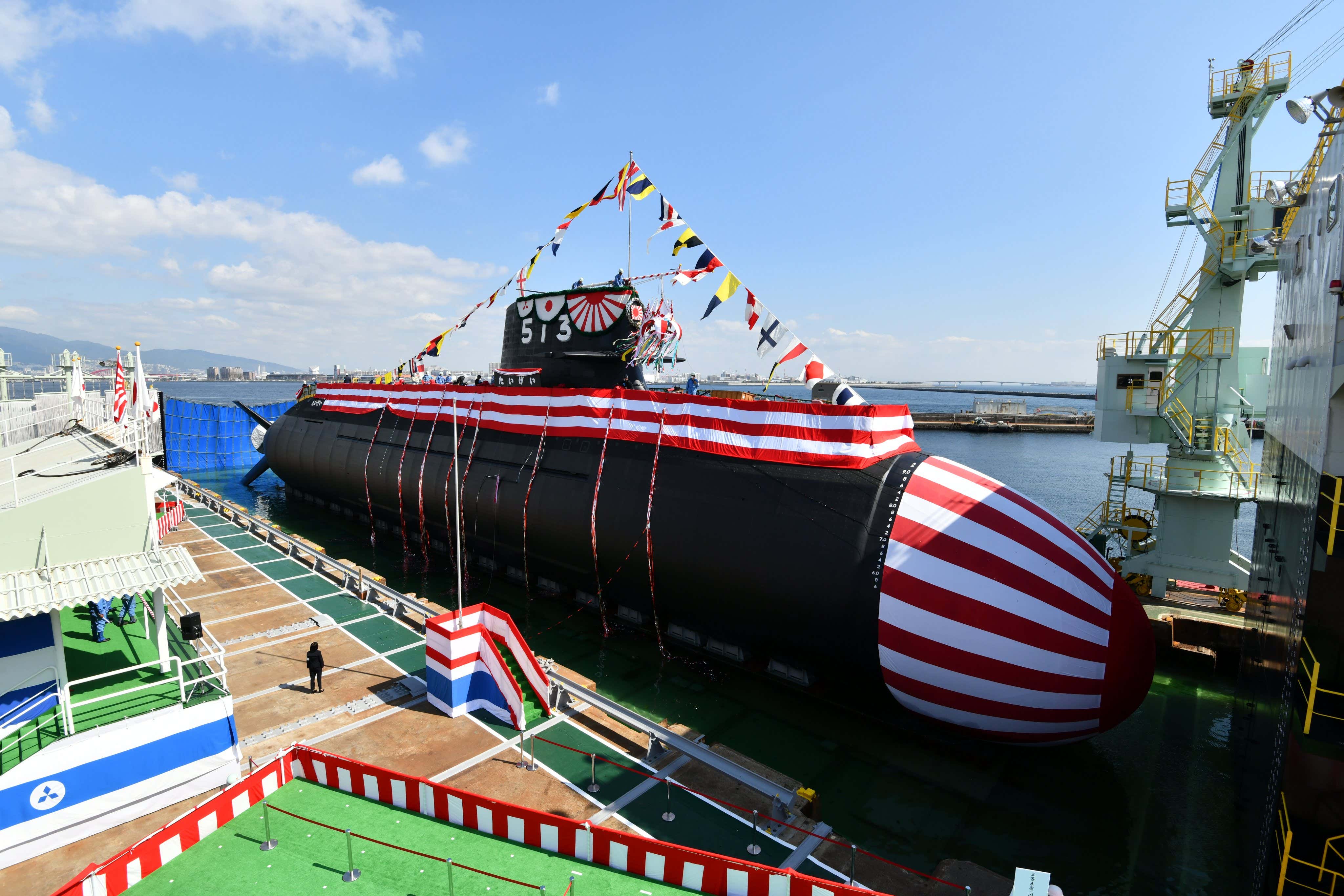
Japanese Ministry of Defense
Japan’s most advanced submarine, the Taigei is launched in October 2020 in the city of Kobe.
However, with the modifications to the Type 12 in mind, it seems work on producing a long-range cruise missile may already be fairly well advanced. There are also unconfirmed reports that the lead boat in the Taigei class may be planned for use as a trials submarine, to assess the viability of VLS or tube-launched cruise missiles. Reportedly, a hull section matching the dimensions of the Taigei class has been noted at the Mitsubishi Heavy Industries dockyard in Kobe with an enlarged upper part that may relate to tests of a VLS installation.
Japan has also looked in the past at an off-the-shelf purchase of Tomahawk cruise missiles from the United States, which we reported on back in 2017. The plan was to use these missiles as standoff retaliatory strike weapons against North Korean missile launchers and launch facilities. While this parallels at least part of the mission expected of the long-range cruise missile, Japan’s Tomahawk plans envisaged acquiring a surface-warship-launched version of the missile, rather than a sub-launched one. Although there has been no serious move since then to buy Tomahawks, the Block IV version of the missile appears to meet Japanese requirements perfectly.
As well as adding an all-new land-attack mission to the submarine fleet, introducing a weapon of this type with the ability to strike well beyond Japan’s territorial boundaries would again signal the continued shift away from the traditional purely ‘defensive’ nature of its military. The same missile could also very likely be easily adapted for launch from VLS cells onboard JMSDF surface warships, too. Whatever form the future long-range cruise missile takes, it’s now clear that the country’s strategic posture is increasingly calling for these kinds of long-range strike capabilities as part of the submarine force and the wider armed forces.
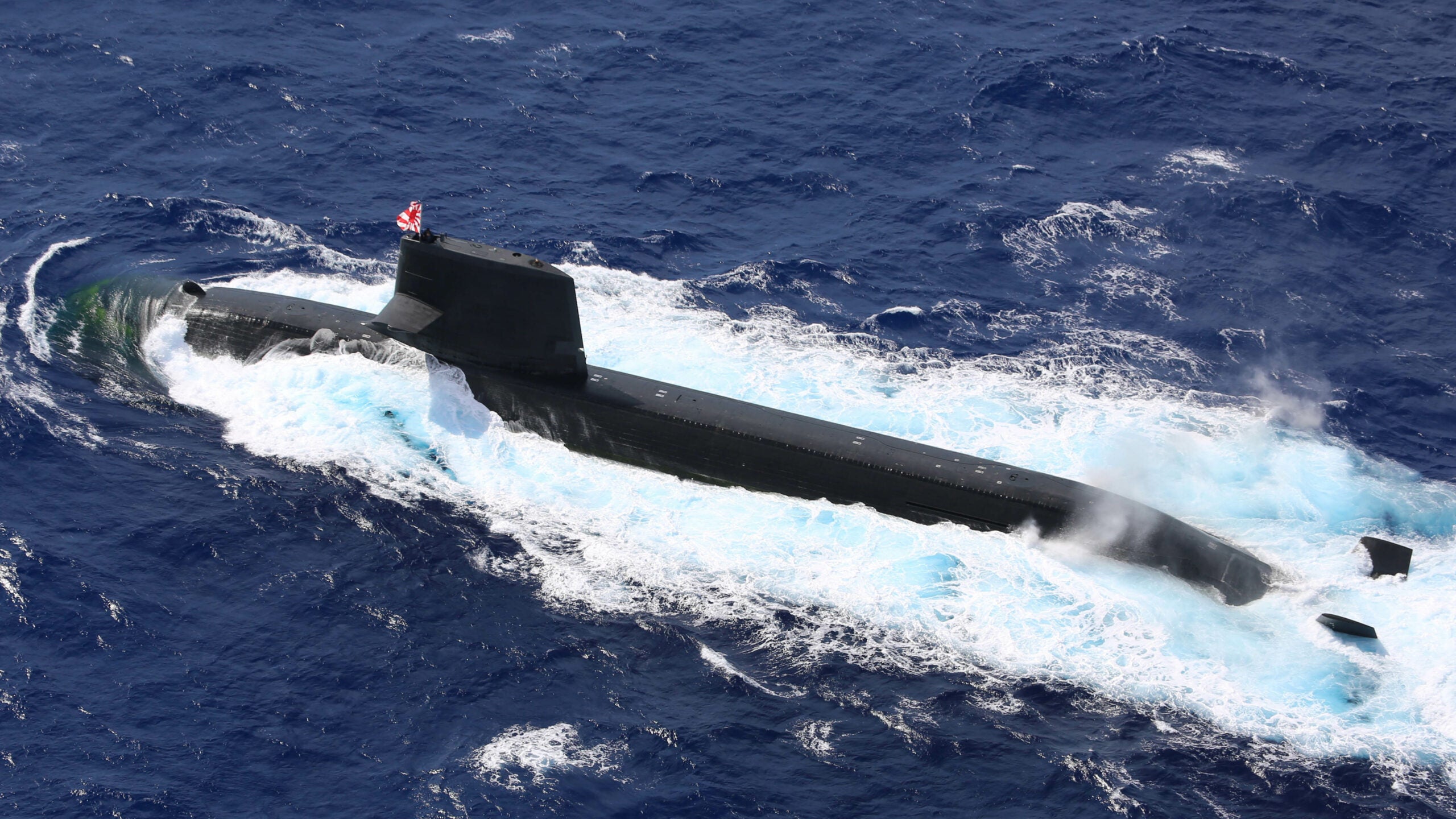
 www.thedrive.com
www.thedrive.com
The missiles would offer land-attack and anti-ship capabilities and would be expected to serve as a deterrent to China and North Korea.
By Thomas Newdick December 30, 2021
Recent reports indicate that Japan is considering introducing a new long-range cruise missile capability to its existing submarine fleet, or future submarines, with a weapon that would have a range of over 620 miles and would be fielded from the latter half of the 2020s. The indigenous missile would provide the Japan Maritime Self-Defense Force, or JMSDF, with a new standoff capability to attack both enemy surface warships and land targets and is clearly seen as a potential counter to offset growing threats from China and North Korea.
A report in Japan’s Yomiuri Shimbun newspaper cites several unnamed government officials who confirm that Tokyo is looking at the possibility of equipping current and/or future JMSDF submarines with long-range cruise missiles. These would be derived from the Type 12 subsonic anti-ship missile that’s already in service with the Japan Ground Self-Defense Force, or JGSDF, and which has a range of around 124 miles in its current form. At this stage, both vertical launch system (VLS) and torpedo-tube-launched options are being examined for the new missile. As it stands, the JMSDF does not have any submarine-based VLS in service. There is also currently no confirmation of the size of magazine capacity being considered for the missile-armed submarines.

JGSDF
Test-firing of a Japan Ground Self-Defense Forces Type 12 anti-ship missile.
The Yomiuri Shimbun report stresses the potential for JMSDF submarines armed with the new cruise missiles to attack ground targets, in particular “enemy missile launch bases for the purpose of self-defense.” However, an accompanying graphic shows a submerged submarine using the same weapon to target a hostile surface combatant, as well. Indeed, the article suggests that the anti-ship version of the missile would actually be introduced first, “to counterattack enemy ships from outside the missile range of the opponent,” before the same weapon is further adapted for “attacking enemy bases in the future.” Ultimately, it would seem likely that a single missile would be furnished for both anti-ship and land-attack roles, as is the case with the Tomahawk Block IV, or the Norwegian-designed Joint Stike Missile (JSM), which Japan has procured for its F-35 stealth jets.
脅威シナリオ、攻撃目標、得られる効果等いろいろ課題がある。米海軍のSSGNには150発近いトマホークを同時発射する火力があるし、ヴァージニア級にも巡航ミサイル(とHGV)専用のVLSがある。海自の潜水艦の半数と投入しても、同時発射できるのは30発ぐらいでしょう。
【独自】海自潜水艦に1000キロ射程ミサイル…敵基地攻撃能力の具体化で検討 : 政治 : ニュース
— Masashi Boosted MURANO (@show_murano) December 30, 2021
The emphasis on “self-defense” reflects the need for the Japanese military to at least frame capabilities such as these within the context of the country’s constitution, which rules out offensive action. However, the reality around this provision is fast degrading, with significant recent developments including acceptance of fixed-wing-capable aircraft carriers.
A precise timeline for the development of the new long-range cruise missile has not been revealed, although planned service entry toward the end of this decade seems ambitious, especially considering the VLS containers would have to be retrofitted to existing boats, space permitting, or otherwise installed in still-to-be-launched submarines. It is worth noting that South Korea is currently understood to be working on building Dosan Ahn Changho class submarines with progressively increased VLS cells, starting with six and working up to 10, which will accommodate cruise missiles or ballistic missiles. This kind of step-by-step approach might be an option for Japan, too, as would opting for torpedo tube-launched missiles on older boats and VLS in new-construction hulls.
The JMSDF’s submarines are already equipped with Harpoon anti-ship missiles that are launched from standard torpedo tubes, but they have a much shorter range than is anticipated for the new weapon and no land-attack capability. The latest UGM-84L Harpoon Block II in JMSDF service can reach targets out to around 80 miles.
The report states that Prime Minister Fumio Kishida aims to include the “capacity to attack enemy bases” in the country’s next National Security Strategy, which is due to be published late next year, and which will set out Tokyo’s medium to long-term guidelines for defense and foreign policies. Submarine-launched missiles would be one way of achieving that goal. With the JMSDF operating a fleet of 22 conventionally powered submarines, and with at least two more to be added in the future, there are potentially plenty of hulls that could be adapted. However, an air-launched or ship-based land-attack cruise missile would also seem to fit this requirement.
On the other hand, work is already underway to extend the range of the truck-launched Type 12 anti-ship missile as well as to adapt it for potential air launch by Japan Air Self-Defense Force, or JASDF, F-15J fighter jets, as part of an upgrade for these aircraft.

BOEING
An artist’s impression of an upgraded Japanese F-15J carrying an AGM-158 Joint Air-to-Surface Standoff Missile (JASSM) on its centerline. This is one option for a long-range missile that could be added as part of the F-15J upgrade.
Initial work on an extended-range Type 12 began back in the 2018 fiscal year, but, in December last year, it was reported that Tokyo had decided to embark on a related redesign of the missile, adding larger flying surfaces and a powerplant optimized for high-altitude flight, as well as additional fuel. That would increase the range from the current 124 miles to 560 miles, and, later, up to 930 miles. Even with the initial range extension, the new weapon would be in broadly the same category that’s required for the new cruise missile. Importantly, the revised Type 12 would also be capable of hitting ground targets and is also planned to incorporate radar cross-section reduction measures, making it harder to detect. At the time, there was no mention that this extended-range Type 12 was envisaged for submarine launch as well.
However, work on these revisions to the Type 12 was expected to be carried out between fiscal years 2019 and 2023, which would also fit with the timescale required for the submarine-launched cruise missile.
The Type 12 ground-launched anti-ship missile:
A dual-role long-range cruise missile would be of considerable value to the JMSDF as it contends with a rapidly growing fleet of Chinese surface warships. Activity by People’s Liberation Army Navy (PLAN) warships in the waters around Japan and in the South China Sea and the East China Sea — the latter home to a long-running dispute over ownership of an uninhabited island chain — has increased in recent years and now includes aircraft carrier battle groups.
At the same time, the land-attack configuration of the new weapon would allow Japan to strike against critical ground targets, such as the proliferating ballistic missile capabilities in both China and North Korea. The latter country has, on multiple occasions, launched ballistic missiles capable of reaching Japan into waters off that country. Other critical military and leadership infrastructure, as well as airbases and air-defense sites, would be likely targets for the JSMDF’s long-range cruise missiles in times of conflict.
Should either China or North Korea attempt to attack Japan, a submarine-based land-attack cruise missile capability provides a much more survivable means of delivering a counterstrike, even if considerable numbers of aircraft and surface vessels have already been hit in the enemy’s first strike. The effectiveness would be enhanced by not only the relatively large size of the JMSDF’s submarine fleet, but also the fact that it operates some of the most advanced conventionally powered boats in service anywhere in the world, and among the quietest, including a propulsion arrangement based around lithium-ion batteries in the newest boats.

Japanese Ministry of Defense
Japan’s most advanced submarine, the Taigei is launched in October 2020 in the city of Kobe.
However, with the modifications to the Type 12 in mind, it seems work on producing a long-range cruise missile may already be fairly well advanced. There are also unconfirmed reports that the lead boat in the Taigei class may be planned for use as a trials submarine, to assess the viability of VLS or tube-launched cruise missiles. Reportedly, a hull section matching the dimensions of the Taigei class has been noted at the Mitsubishi Heavy Industries dockyard in Kobe with an enlarged upper part that may relate to tests of a VLS installation.
んで、時を同じくして神戸にある三菱or川重の工場から上部がやけに盛り上がった謎の船体区画が目撃されたりするんですよぬ・・・。 pic.twitter.com/uHeaqfAJLm
— ふにに (@hunini181202) December 30, 2021
Japan has also looked in the past at an off-the-shelf purchase of Tomahawk cruise missiles from the United States, which we reported on back in 2017. The plan was to use these missiles as standoff retaliatory strike weapons against North Korean missile launchers and launch facilities. While this parallels at least part of the mission expected of the long-range cruise missile, Japan’s Tomahawk plans envisaged acquiring a surface-warship-launched version of the missile, rather than a sub-launched one. Although there has been no serious move since then to buy Tomahawks, the Block IV version of the missile appears to meet Japanese requirements perfectly.
As well as adding an all-new land-attack mission to the submarine fleet, introducing a weapon of this type with the ability to strike well beyond Japan’s territorial boundaries would again signal the continued shift away from the traditional purely ‘defensive’ nature of its military. The same missile could also very likely be easily adapted for launch from VLS cells onboard JMSDF surface warships, too. Whatever form the future long-range cruise missile takes, it’s now clear that the country’s strategic posture is increasingly calling for these kinds of long-range strike capabilities as part of the submarine force and the wider armed forces.

Japan Wants To Arm Its Submarines With Long-Range Cruise Missiles: Report
The missiles would offer land-attack and anti-ship capabilities and would be expected to serve as a deterrent to China and North Korea.
jward
passin' thru
U.S. at risk of paying 'unbearable price' over Taiwan - senior Chinese diplomat
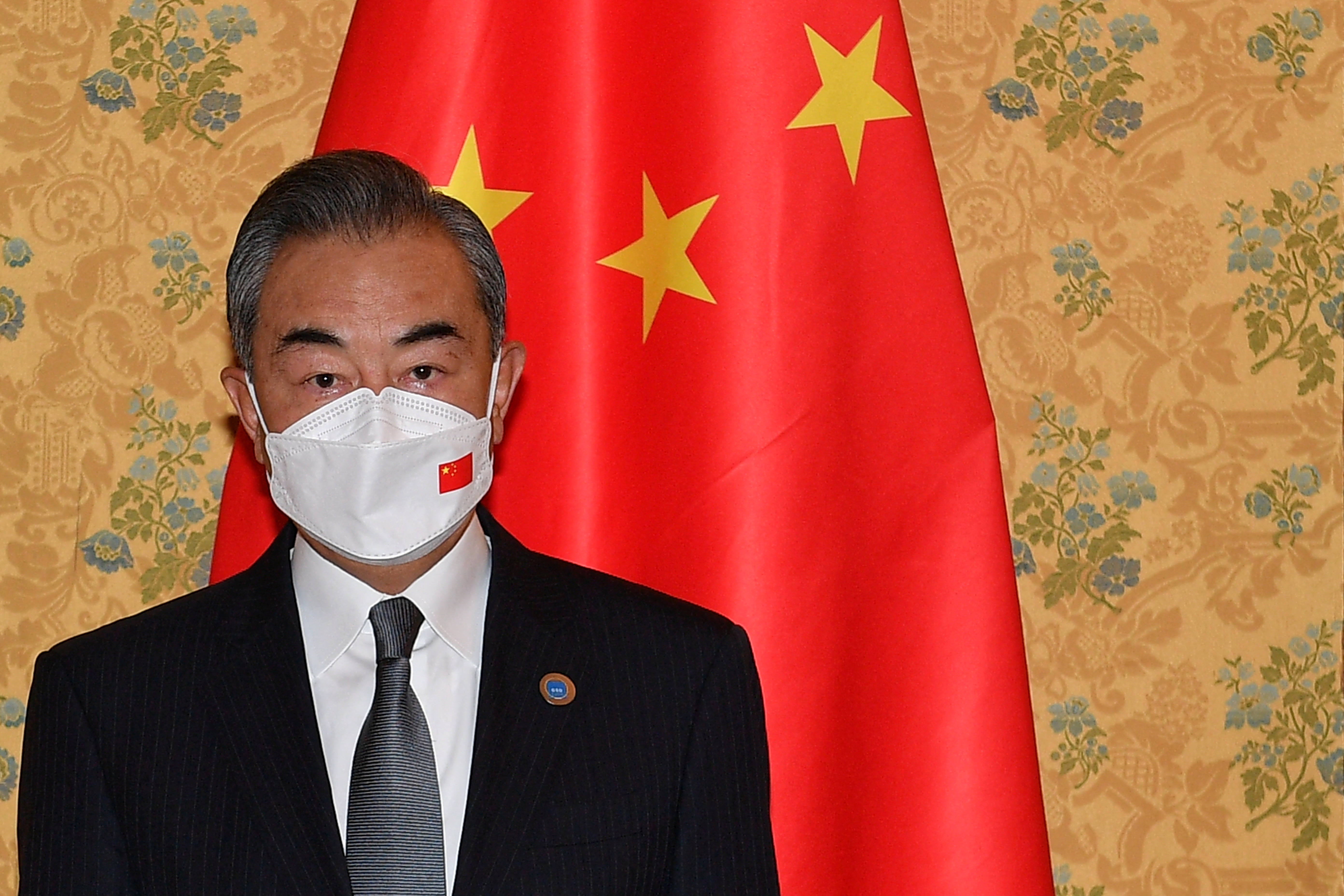


1/3
China's State Councilor and Foreign Minister Wang Yi waves as he leaves a news conference in Tokyo, Japan, November 24, 2020. REUTERS/Issei Kato/Pool/File Photo
Register now for FREE unlimited access to Reuters.com
BEIJING, Dec 30 (Reuters) - The United States is at risk of paying an "unbearable price" due to its actions over Taiwan, Wang Yi, state councillor and foreign minister, said in an interview with state media on Thursday.
China claims democratically governed Taiwan as its own territory and in the past two years has stepped up military and diplomatic pressure to assert its sovereignty claim, fuelling anger in Taipei and concern in Washington.
By "encouraging 'Taiwan independence' forces" the United States "not only puts Taiwan into an extremely dangerous situation but also exposes the United States to an unbearable price", Wang said.
Taiwan has emerged as a key factor in strained relations between China and the United States, the island's most important international backer and arms supplier despite the absence of formal diplomatic ties.
Taiwan says it is an independent country and vows to defend its freedom and democracy. China regularly describes the island as the most sensitive issue in its ties with the United States.
"Taiwan has no other way forward other than reunification with the mainland," said Wang.
While the United States recognises only one China, it is required by law to provide Taiwan with the means to defend itself and has long followed a policy of "strategic ambiguity" on whether it would intervene militarily to protect Taiwan in the event of a Chinese attack.
/cloudfront-us-east-2.images.arcpublishing.com/reuters/JKQJO35NPNJQVIWEYU3ZPQVEVU.jpg)
 www.reuters.com
www.reuters.com



1/3
China's State Councilor and Foreign Minister Wang Yi waves as he leaves a news conference in Tokyo, Japan, November 24, 2020. REUTERS/Issei Kato/Pool/File Photo
Register now for FREE unlimited access to Reuters.com
BEIJING, Dec 30 (Reuters) - The United States is at risk of paying an "unbearable price" due to its actions over Taiwan, Wang Yi, state councillor and foreign minister, said in an interview with state media on Thursday.
China claims democratically governed Taiwan as its own territory and in the past two years has stepped up military and diplomatic pressure to assert its sovereignty claim, fuelling anger in Taipei and concern in Washington.
By "encouraging 'Taiwan independence' forces" the United States "not only puts Taiwan into an extremely dangerous situation but also exposes the United States to an unbearable price", Wang said.
Taiwan has emerged as a key factor in strained relations between China and the United States, the island's most important international backer and arms supplier despite the absence of formal diplomatic ties.
Taiwan says it is an independent country and vows to defend its freedom and democracy. China regularly describes the island as the most sensitive issue in its ties with the United States.
"Taiwan has no other way forward other than reunification with the mainland," said Wang.
While the United States recognises only one China, it is required by law to provide Taiwan with the means to defend itself and has long followed a policy of "strategic ambiguity" on whether it would intervene militarily to protect Taiwan in the event of a Chinese attack.
/cloudfront-us-east-2.images.arcpublishing.com/reuters/JKQJO35NPNJQVIWEYU3ZPQVEVU.jpg)
U.S. at risk of paying 'unbearable price' over Taiwan - senior Chinese diplomat
The United States is at risk of paying an "unbearable price" due to its actions over Taiwan, Wang Yi, state councillor and foreign minister, said in an interview with state media on Thursday.
jward
passin' thru
hmm
Indo-Pacific News - Watching the CCP-China Threat
@IndoPac_Info
10h
#China replaces ‘soldiers with robots’ in Tibet as soldiers fleeing in harsh winters. It’s an indirect admission that the PLA cannot match the mettle of the Indian Army at high altitude, freezing weather.
View: https://twitter.com/IndoPac_Info/status/1476793112408170497?s=20
Indo-Pacific News - Watching the CCP-China Threat
@IndoPac_Info
10h
#China replaces ‘soldiers with robots’ in Tibet as soldiers fleeing in harsh winters. It’s an indirect admission that the PLA cannot match the mettle of the Indian Army at high altitude, freezing weather.
View: https://twitter.com/IndoPac_Info/status/1476793112408170497?s=20
jward
passin' thru
South Korea 'effectively' reaches agreement with US to end Korean war | TheHill
Jordan Williams
3 minutes
Jordan Williams
3 minutes
Top Headlines for December 31, 2021
0 seconds of 36 secondsVolume 0%
The United States and South Korea have “effectively” reached an agreement on a draft declaration that would formally end the Korean War, South Korea’s top diplomat said Wednesday.
An armistice was signed in July 1953 to end a war that began in 1950 when North Korean troops invaded South Korea. A formal peace treaty ending the war was never signed.
North Korea has been unresponsive to talks on formally ending the war, Yonhap noted.
South Korean Foreign Minister Chung Eui-yong told reporters on Wednesday that his country and the U.S. have “already shared the understanding” on the importance of ending the war, according to South Korean Yonhap News Agency.
"Regarding the end-of-war declaration, South Korea and the U.S. have already shared the understanding on its importance, and the two sides have effectively reached an agreement on its draft text,” Chung said.
In September, North Korea’s Vice Foreign Minister Ri Thae Song said Pyongyang would not agree to an official declaration unless the U.S. stopped its “hostile policy” towards the nation.
“The U.S. withdrawal of its double-standards and hostile policy is the top priority in stabilizing the situation of the Korean peninsula and ensuring peace on it,” he said at the time.
Asked about Chung’s comments, a State Department spokesperson said, “the United States remains committed to achieving lasting peace on the Korean Peninsula through dialogue and diplomacy with the DPRK,” referring to North Korea’s official name as the Democratic People’s Republic of Korea.
“To this end, we will continue to seek engagement with the DPRK as part of a calibrated, practical approach in order to make tangible progress that increases the security of the United States, our allies, and our deployed forces,” the spokesperson added.

The Hill 1625 K Street, NW Suite 900 Washington DC 20006 | 202-628-8500 tel | 202-628-8503 fax
The contents of this site are © 1998 - 2021 Nexstar Media Inc. | All Rights Reserved.

South Korea ‘effectively’ reaches agreement with US to end Korean war
The United States and South Korea have “effectively” reached an agreement on a draft declaration that would formally end the Korean War, South Korea’s top diplomat said Wednesday.An armistice was s…
jward
passin' thru
South Korea’s Taiwan Conundrum
Sungmin Cho December 31, 2021

What would South Korea do if China attacked Taiwan? Many people in Washington, Taipei, and Tokyo are wondering. South Korea’s position remains much more ambivalent than Japan’s. Seoul is understandably more worried about the possibility of retaliation from China, akin to Beijing’s fury over the basing of a U.S. defensive missile system in South Korea several years ago. Seoul also has a unique concern that Beijing would turn even more non-cooperative in the future process of Korean unification, if it ever occurs, as a result of South Korean involvement in a war over Taiwan. However, there is a variety of scenarios for a Taiwan contingency that will impact South Korea’s security policies, especially the one involving a two-pronged war in both the Taiwan Strait and the Korean Peninsula. Seoul should more actively engage in strategic dialogue with Washington on Taiwan issues. In turn, Washington should better appreciate Seoul’s concerns and the possible range of South Korea’s role in the Taiwan Strait. Both parties are urged to include a Taiwan contingency as part of the agenda for the bilateral alliance.
So, What Does South Korea Think?
As the possibility of war across the Taiwan Strait looms large, the analytic community in Washington has begun to ask questions about South Korea’s position. Experts have called for Washington to reinforce security cooperation with allies and like-minded countries to deter China’s invasion of Taiwan. They especially emphasize that Japan’s backing is indispensable. In turn, Tokyo has shown an unprecedented level of support for Japan’s involvement in a Taiwan contingency. During the U.S.-Japanese summit in April 2021, President Joe Biden and Prime Minister Yoshihide Suga demonstrated a united front on the Taiwan matter. Deputy Prime Minister Aso Taro also remarked that a Taiwan contingency is linked to Japan’s survival. As Tokyo clarifies its position, a growing attention is paid to South Korea.
The United States has military and political interests in South Korea’s position for the possibility of U.S. Forces Korea’s involvement in a Taiwan contingency and South Korean military forces’s potential support. General Paul LaCamera, the commander of U.S. Forces Korea, stated during the confirmation hearing in May that he would seek to integrate U.S. forces based in South Korea into “operational plans supporting U.S. interests and objectives in the region [emphasis mine].” Any U.S. military operation from the peninsula to intervene in order to defend or retake Taiwan would require close coordination with the South Korean government. This observation begs a set of questions regarding South Korea’s internal view of the Taiwan issue. Why does South Korea seem to prefer ambiguity? How does China view South Korea’s involvement in the Taiwan contingency? How do members of South Korea’s policy community assess the possibility of a war over Taiwan and what South Korea ought to do?
Why Take a Cautious Approach?
During the summit in May 2021, Presidents Biden and Moon Jae-in agreed on the importance of “preserving peace and stability across the Taiwan Straits.” It was the first time that the Taiwan issue was ever included in a joint statement between South Korea and the United States. During the press conference, Moon reiterated that South Korea would work more closely with Washington on this issue. In the domestic briefing on the outcome of the summit, however, South Korean Foreign Minister Chung Eui-yong remarked, “We are fully aware of the unique relations between China and Taiwan. Our government’s stance has not changed. We’d like to reiterate that regional peace and stability is the common wish shared by everyone in the region.” Chung practically toned down the significance of the inclusion of Taiwan in the joint summit statement. As such, South Korea’s commitment to the defense of Taiwan largely remains ambiguous.
The possibility that China might attack Taiwan emerged as a thorny issue in the alliance for the first time during the Roh administration. Due to the increasing demands of military commitments in the Middle East, the Bush administration developed the concept of “strategic flexibility” and applied it to U.S. Forces Korea. Washington intended to rapidly move select U.S. military assets out of the Korean Peninsula to wherever these forces were needed. South Korean policymakers worried that these forces might be dispatched to Taiwan in the event of military conflict. That could threaten to entrap South Korea in a war between the United States and China. President Roh Moo-hyun publicly expressed his strong opposition against such a scenario. On Jan. 19, 2006, however, the South Korean government agreed to acknowledge the “strategic flexibility” of U.S. Forces Korea under the condition of consultation. In the joint statement, Foreign Minister Ban Ki-moon affirmed that South Korea respected the “necessity for strategic flexibility” while Secretary of State Condoleezza Rice affirmed that “the U.S. respects the [Republic of Korea] position that it shall not be involved in a regional conflict in Northeast Asia against the will of the Korean people.”
No doubt, South Korea’s cautious approach is related to China’s potential retaliation. During a bilateral summit in May, China’s Global Times editorial warned that Seoul’s discussion of Taiwan with Washington is equal to South Korea drinking poison under U.S. coercion. After the summit, the spokesman of the Chinese Ministry of Foreign Affairs also warned that the “relevant countries” should not “play with fire.” Chinese analysts interpreted the inclusion of the Taiwan issue in the joint statement as Washington’s ploy to expand the role of the U.S.-South Korean alliance to “contain China.” A report published by the China Institutes of Contemporary International Relations, for example, argues that the Biden administration agreed to scrap the ballistic missile range limits for South Korea precisely to balance China’s missile capabilities. The authors claim that China should take necessary measures to raise the cost of South Korea’s cooperation with the United States on Taiwan. With China’s economic retaliation over the U.S. deployment of the Terminal High Altitude Area Defense system in 2017 still in fresh memory, it is not surprising that Seoul needs to take into account China’s likely retaliation when formulating its position on Taiwan.
From a longer-term perspective, Seoul also needs to consider Beijing’s policy toward Korean unification. After the end of the Vietnam War, China and Korea remain the only divided countries in the Asia-Pacific region. Chinese officials and scholars emphasize that the unification of Korea is an international issue, whereas Chinese-Taiwanese unification is an internal affair. The two Koreas joined the United Nations as two sovereign states in 1991. Despite the difference in legal status, Chinese experts tend to positively perceive that Korean unification, if it happens first, would stimulate the Chinese people’s aspiration for national unification. They even expect that Beijing may learn some lessons from the Korean experiences of integrating two different systems. In short, Chinese analysts see a linkage between Korean unification and Chinese unification. This implies that China will surely accuse South Korea of obstructing China’s national unification if the country gets involved in a Taiwan contingency. Then, Beijing will become even more non-cooperative in the process of Korean unification in the future.
China’s cooperation is crucial to maintaining stability on the Korean Peninsula if the unification of the two Koreas ever occurs in the future. From the U.S. perspective, securing North Korea’s nuclear infrastructure and arsenal would be the top priority in the event of Korean unification. As I argued elsewhere, Washington and Seoul can coordinate efforts to shape Beijing’s policy toward Korean unification once they have a comprehensive understanding of China’s cost-benefit calculus in association with Korean unification. However, if South Korea is involved in contingency planning for Taiwan affairs, such a move would surely diminish Beijing’s willingness to cooperate for Korean unification. The linkage of unification issues is therefore a unique concern to South Korea that other U.S. allies do not have to worry about.
A Dangerous Linkage
The challenge is that the contingency in the Taiwan Strait may have a direct impact on South Korea’s national security as well. South Korea’s analytic community appears to have mixed assessments on the possibility of war across the Taiwan Strait. South Korean scholars notice that the Chinese leaders’ aggressive remarks on Taiwan have visibly increased under General Secretary Xi Jinping’s watch. But they also interpret that such a rhetoric is developed for domestic consumption: Xi attempts to strengthen popular support by appealing to the Chinese people’s aspiration for national unification. Even if Xi has a genuine desire to pursue unification by force, the disparity with U.S. military forces still remains large, which will become even larger with the addition of U.S. allies like Japan, Australia, and the United Kingdom. Xi therefore has to take into account the political, economic, and diplomatic consequences before making a decision on China’s invasion of Taiwan. Therefore, South Korean scholars seem to conclude that China is not likely to invade Taiwan anytime soon and will focus on maintaining the status quo instead.
What South Korea needs to worry about, however, is not the low possibility of a rapid and all-out invasion, but the likelihood of limited attack or low-intensity provocation in slow motion. For example, the unclassified tabletop exercise — funded by Japan’s Sasakawa Peace Foundation and joined by experienced military experts from Japan, South Korea, Taiwan, and the United States in 2020 — started with a hypothetical situation that China occupies two Taiwan-controlled features in the South China Sea. The permanent garrisons on the islands of Taiping (Itu Aba) and the Dongsha (Pratas) are small and lightly armed. The Chinese military can quickly occupy them, justifying the actions with its “One China” policy. Since the occupation does not involve any American casualties with the number of Taiwanese casualties kept low, it will be hard for Washington to make a rapid decision for military intervention. While holding hostage the Taiwanese people on the islands, Beijing can pressure Taipei and Washington to refrain from taking any actions to retake the islands. The 2021 report published by the Center for a New American Security also reached a similar conclusion that China’s limited attacks will put the United States in a very difficult position to react. Both the Sasakawa exercise and the Center for a New American Security report urge Washington to discuss with U.S. allies about their potential assistance in such scenarios, which means that Seoul needs to be ready to have such a conversation.
The worst-case scenario for South Korea would be that the Taiwan contingency expands to a crisis on the Korean Peninsula. If the tension rapidly escalates to the verge of military conflict with the United States in the Taiwan Strait, China would certainly want to prevent the U.S. forces based in Japan and Korea respectively from repositioning themselves to intervene in and around Taiwan. Therefore, if Pyongyang intends to do so, Beijing will not oppose North Korea’s concurrent provocations to pin down U.S. Forces Korea and U.S. Forces Japan from moving to the Taiwan Strait. From Pyongyang’s perspective as well, the contingency in Taiwan Strait means that the U.S. focus is distracted from the Korean Peninsula, which creates an opportunity for major provocation such as nuclear or long-range missile tests. By doing so, Pyongyang can pressure Seoul and Washington to make concessions on the denuclearization negotiation. As U.S. Navy officer Ki-suh Jung persuasively argues, China and North Korea, as treaty allies, may well discuss, plan, and execute a two-pronged attack to split the U.S. forces. With or without such a conspiracy, Pyongyang can send a signal to Beijing for simultaneous attacks at any phase of crisis. Indeed, in October 2021, North Korean Vice Foreign Minister Pak Myong-ho threatened that “The huge forces of the U.S. and its satellite states, which are being concentrated near Taiwan,” can be “committed to a military operation targeting [North Korea] at any time,” and that “The U.S. should bear in mind that its reckless interference in internal affairs…would only invite tragic consequences.”
A Test of the Alliance
When North Korea invaded South Korea on June 25, 1950, American leaders rapidly decided to support South Korea’s defense. It should not be forgotten that President Harry Truman also directed the U.S. Seventh Fleet to the Taiwan Strait to prevent conflicts between China and Taiwan. The United States could easily deter China’s invasion of Taiwan in 1950, but this may not be the case anymore in 2021. The debate over when, whether, and how China might attack Taiwan — and what such an attack might lead to — has taken on a new sense of urgency in the last two years. As such, Seoul needs to communicate more actively with Washington on Taiwan-related issues, including how to respond to China’s possible retaliations. In the case of all-out war, South Korea would be surely expected to fight with the U.S. forces as a treaty ally. In the case that a conflict in the Taiwan Strait expands to the Korean Peninsula with North Korea’s provocation in support of China, South Korea and the United States need to discuss whether and how to distribute U.S. forces assigned to Korea and South Korean forces between the two front lines. And in the case of low-intensity provocations or limited attack, Seoul needs to explain and seek mutual understanding with Washington if it is unwilling to be involved militarily. Then they can explore other ways for South Korea to make contributions for the stability of the region.
The Senate hearing of the U.S. Forces Korea commander in May was revealing about the growing expectation of South Korea’s role in Northeast Asia. As the 10th-largest economy with the sixth most powerful military, South Korea is well expected to make contributions for peace and stability in the region. That is why Gen. LaCamera said during the hearing that, “given…the international reach of the South Korean military, opportunities are emerging for alliance cooperation beyond the Korean Peninsula.” Too much expectation, however, may end up with a deeper disappointment if not managed properly. Seoul needs to take the Taiwan issue more seriously and review its policy options. It should communicate with Washington more actively to explain its concerns and possible range of policy options. Washington also needs to better understand South Korea’s view to have a productive dialogue. Regardless of a real possibility of a Taiwan contingency, the trust level of the U.S.-South Korean alliance is already being tested.
jward
passin' thru
 China Releases Image Of Japanese Carrier Sailing Right Alongside Its Own Carrier
China Releases Image Of Japanese Carrier Sailing Right Alongside Its Own CarrierJapan's use of its aircraft carrier to closely shadow China's own is highly unusual.
By Joseph Trevithick December 30, 2021
The Chinese government has released video footage and pictures, seen at the top of this story and below, showing Japan's aircraft carrier Izumo sailing remarkably close to the People's Liberation Army Navy's own flattop Liaoning and its escorts during recent exercises in the Pacific. This comes after Japanese officials announced plans to set up a military hotline with their counterparts in China to help de-escalate potential alterations in the future.
WATCH: Chinese aircraft carrier Liaoning conducts training in Western Pacific. pic.twitter.com/Lp3aK9ECMH
— Ryan Chan 陳家翹 (@ryankakiuchan) December 30, 2021
The office of the Joint Staff of the Japan Self-Defense Forces (JSDF) first announced that it had observed Liaoning, along with a Type 052D destroyer, a Type 054A frigate, and a Type 901 replenishment ship, transiting from the East China Sea into the western Pacific Ocean southeast of Okinawa on Dec. 15. The Chinese flotilla then moved farther southeast and conducted a series of drills, including the launch and recovery of J-15 fighter jets from the Liaoning, as well as flights by Z-9 and Z-18 helicopters. The People's Liberation Army Navy (PLAN) vessels subsequently returned to the East China Sea on Dec. 25.
Aircraft carriers in Western Pacific. pic.twitter.com/YVNqWvFhX1
— Duan Dang (@duandang) December 23, 2021
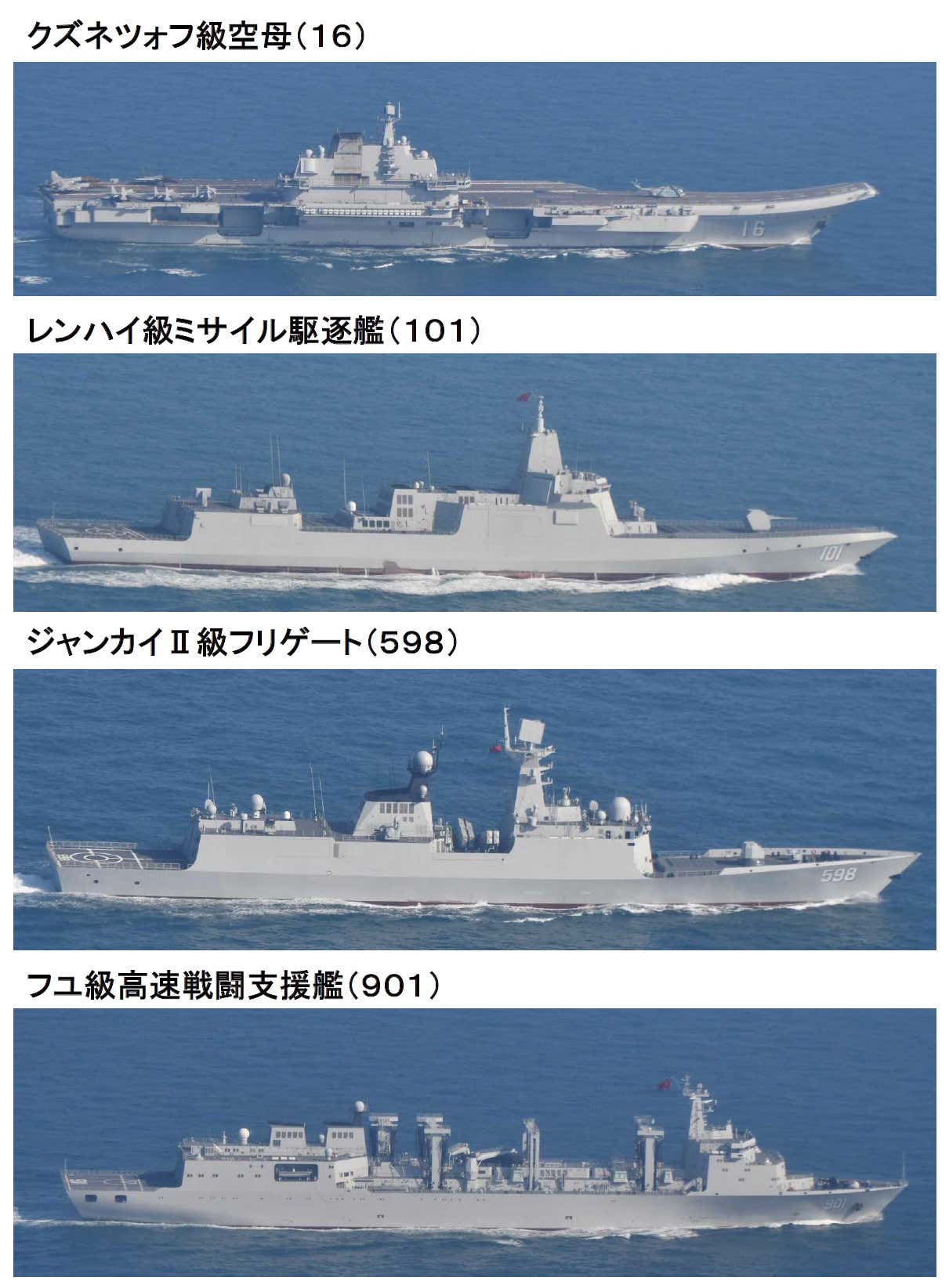
Japanese MoD
Pictures the Japanese government released of the Chinese ships after they transited from the East China Sea into the Pacific. From top to bottom: the aircraft carrier Liaoning, the Type 054A frigate, the Type 052D destroyer, and the Type 901 replenishment ship.
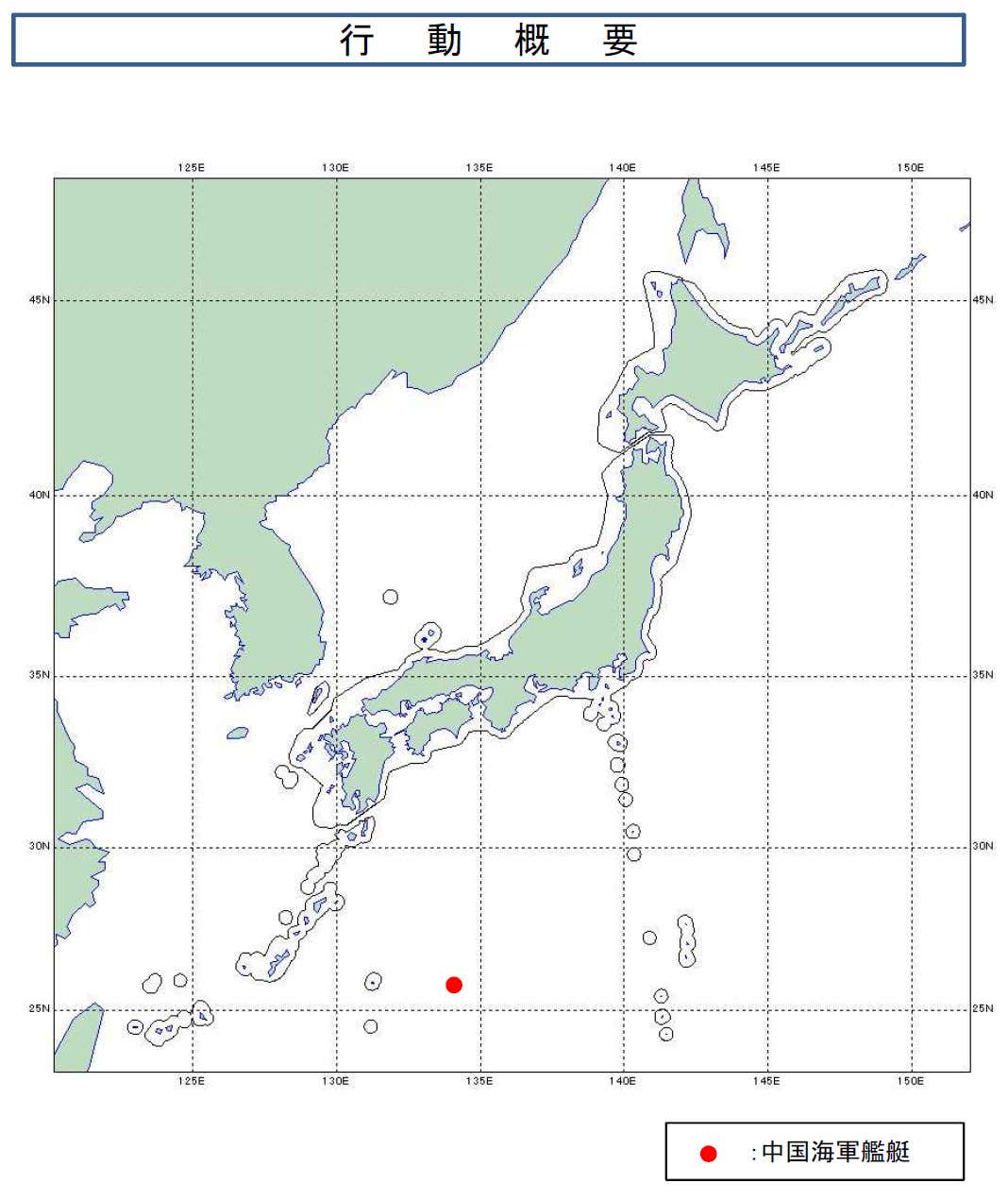
Japanese MoD
A map Japanese officials released with a red dot showing the general area where Chinese naval forces conducted their exercises earlier in December.
Japanese authorities had previously said that Izumo, together with the destroyer Akizuki, had monitored the Chinese activities. JSDF P-1 and P-3 maritime patrol planes had also helped keep an eye on the PLAN exercises, and Japanese fighter jets were scrambled at times in response to Chinese J-15s flying from Liaoning. Footage showing a Japanese F-15J Eagle fighter jet intercepting a Chinese J-15, shot from the latter aircraft's cockpit during these recent drills, has been released, as well.
Wow ... a Japanese F-15J (?) photographed from within a J-15’s cockpit. https://t.co/ymVxEtPWhy
— @Rupprecht_A (@RupprechtDeino) December 30, 2021
In general, one country's naval vessels shadowing those of another in international waters, especially when foreign warships come relatively close to a nation's territorial waters, happens on a regular basis around the world. At present, there is no indication one way or another that either Chinese or Japanese forces acted in dangerous or otherwise unprofessional ways during their encounters earlier this month.
At the same time, it is highly unusual to employ an aircraft carrier in this role and to have it operate so close to the other navy's ships. Japan, like other countries, more typically employs smaller vessels for shadowing missions. The JSDF seems to have clearly intended, at least in part, to send a signal to its Chinese counterparts about its capabilities and willingness to employ them with these relatively intimate interactions in the western Pacific.
While it is not clear how close the Japanese carrier ever came to any of the PLAN vessels, the distances do appear to be relatively short for such large warships. This degree of proximity would help explain how Japanese forces were able to take the close-up shots of these Chinese counterparts operating in the Pacific that had been included in previous JSDF Joint Staff press releases.
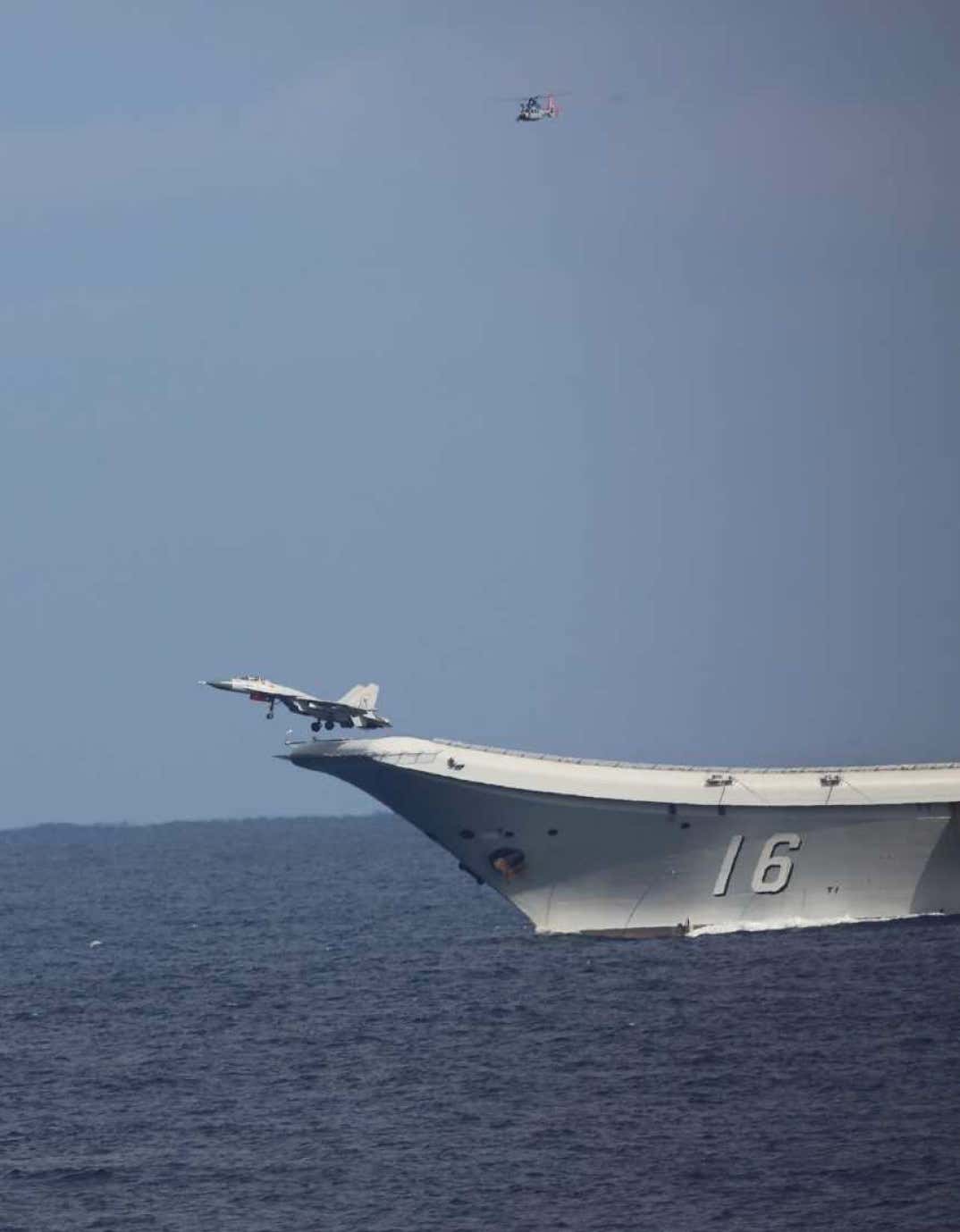
Japanese MoD
A picture Japanese officials previously released showing a J-15 fighter jet taking off from Liaoning while a Z-9 helicopter acts as a plane guard. Based on the sharpness of its focus and its perspective, along with what we know now of the proximity between the two ships, this picture may well have been shot from the deck of Izumo.
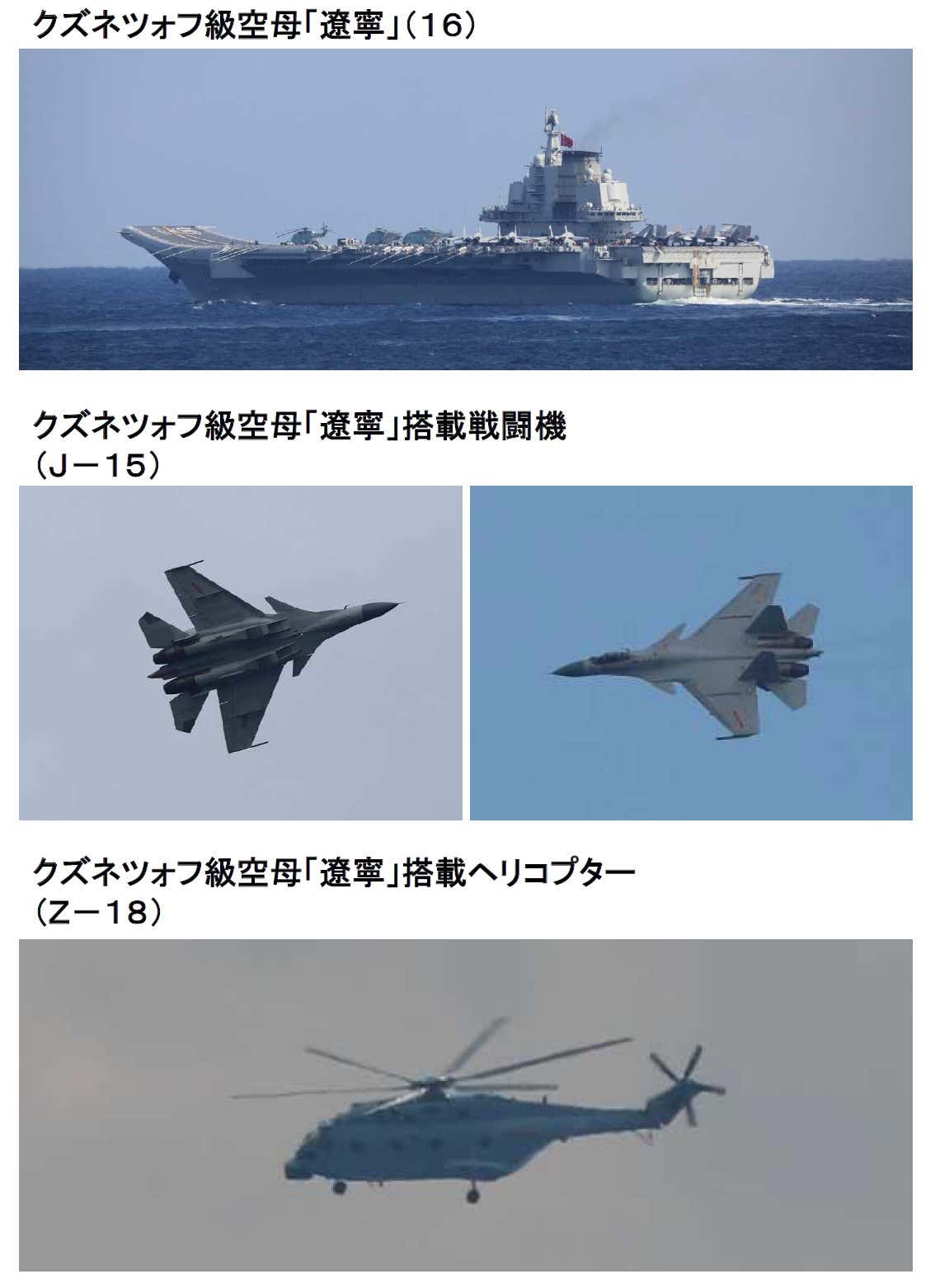
Japanese MoD
Other pictures the Japanese government previously released of Liaoning and elements of its air wing during recent exercises in the Pacific.
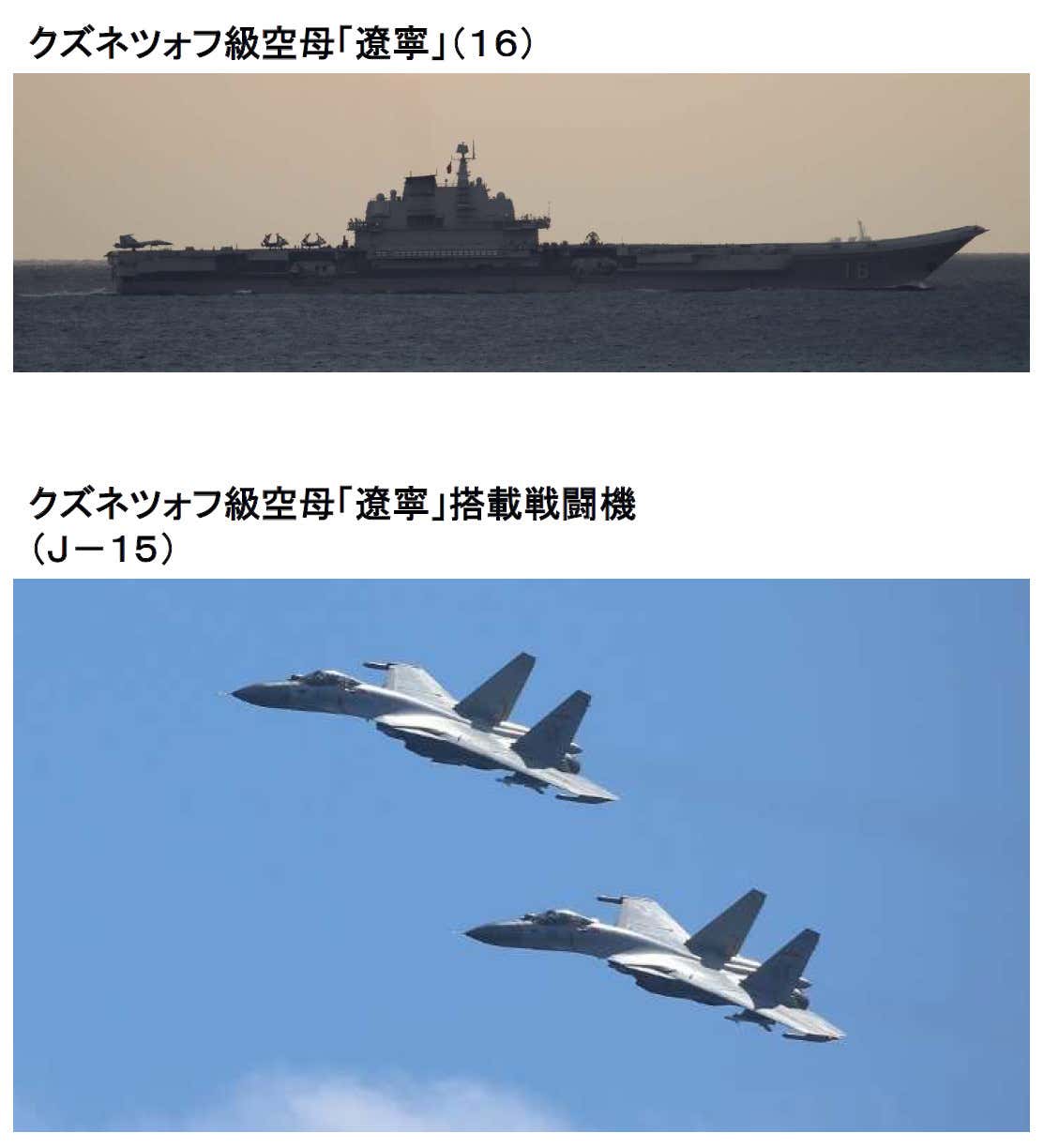
Japanese MoD
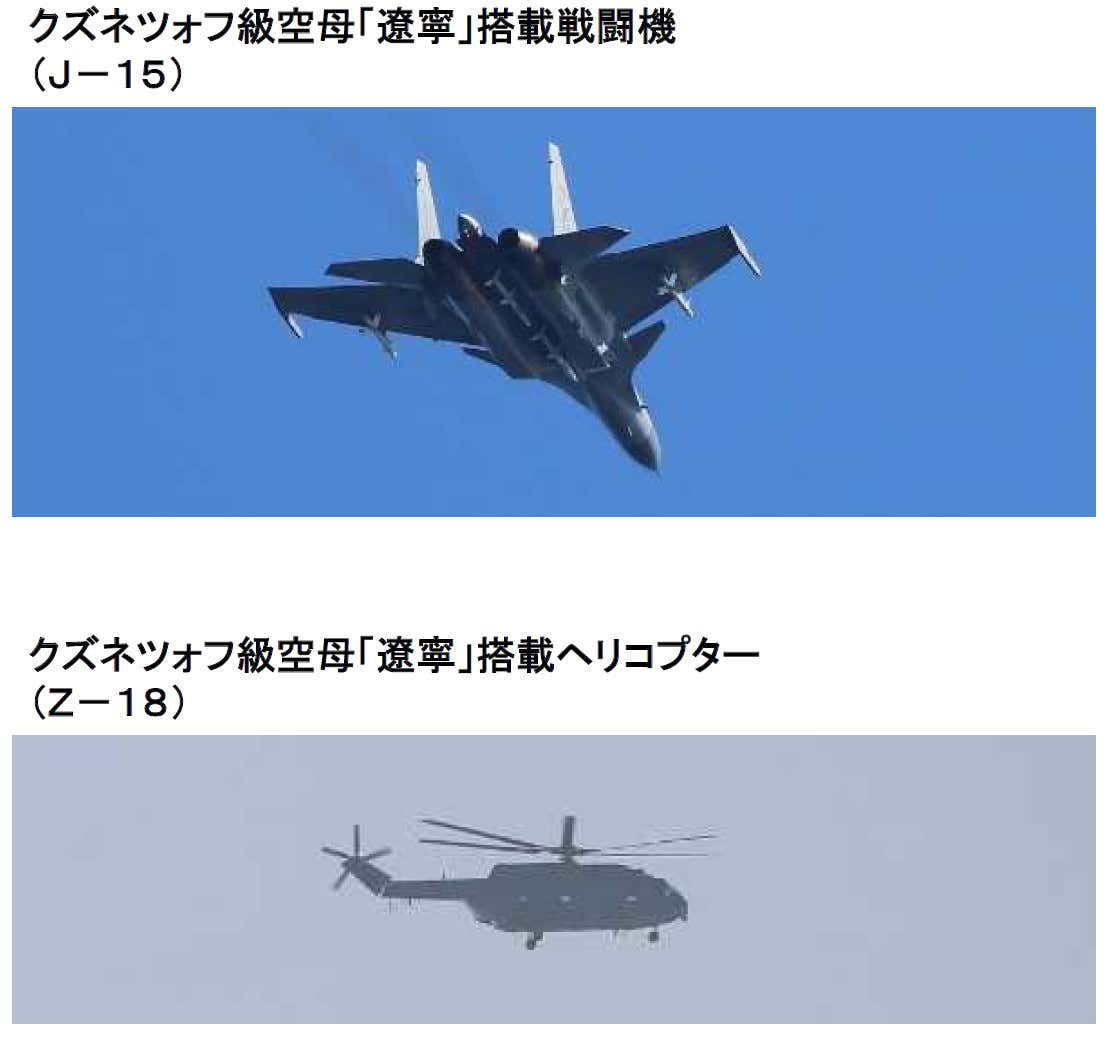
Japanese MoD
The presence of the Chinese ships in the Pacific south of Japan reflects the PLAN's ever-increasing operational tempo, as well as its increasing ability to project significant naval power beyond China's immediate periphery. In October, another group of PLAN warships joined naval vessels from Russia on a joint patrol that almost saw them circumnavigate Japan's Home Islands, a significant demonstration of China's current maritime capabilities.
The Japan Maritime Self-Defense Force has itself increased the scale and scope of its activities in recent years, including taking part in a growing number of multi-national naval and other kinds of drills in the Pacific. Just this year, Izumo hosted U.S. Marine Corps F-35Bs in an exercise that saw fighters fly from a Japanese carrier for the first time since World War II.
RT 6.46
All of this also comes amid a period of very high friction between Chinese and Japanese authorities. In particular, the government in Japan under Prime Minister Fumio Kishida has decided to take a much more outspoken position in support of the government on Taiwan. Japanese officials have indicated that they would support a U.S.-led military response to any Chinese intervention on that island and have been critical of Beijing's coercive behavior toward authorities in Taipei.
This is a major shift in Japanese policy that has drawn the ire of officials in Beijing, who view Taiwan as a rogue province. Kishida has also been openly critical of China's crackdowns on pro-democracy advocates and others in Hong Kong and on ethnic Uighurs in its western Xinjiang province. Japan and China continue to have a long-standing and fierce dispute over control of a chain of uninhabited islands that lie between Taiwan and Okinawa, as well.
For its part, the regime in Beijing has been increasingly critical of Japan's efforts to expand and modernize its military capabilities in recent years, as well as efforts to reform or even eliminate Article 9 of the Japanese Constitution that bans the country from using its forces for any purpose beyond self-defense. Izumo, which Japanese authorities asserted for years was a helicopter carrier incapable of carrying out anything that could be described as an offensive military mission, is one significant element of this debate. In 2018, officials in Japan admitted that Izumo and her sister ship Kaga had been designed from the outset to be readily convertible to support fixed-wing aircraft. Izumo is now expected to be fully converted into a true light aircraft carrier capable of accommodating an air wing that includes Japanese F-35B Joint Strike Fighters by 2024.
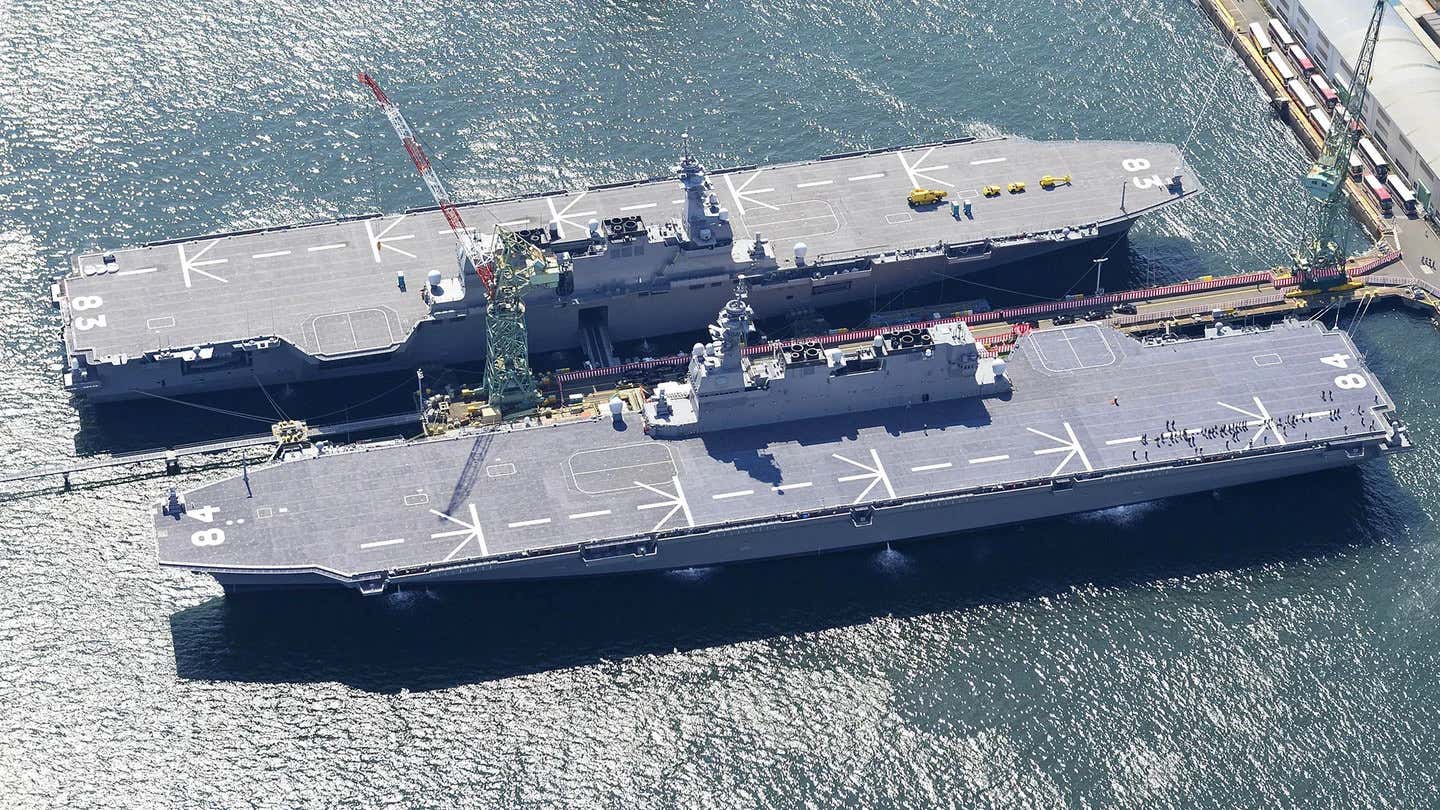
Kyodo via AP
Japan's two Izumo class aircraft carriers in port.
Amid these growing tensions, Japan's Ministry of Defense announced on Dec. 28 that it had agreed to establish a hotline with Chinese military officials specifically to provide a channel to defuse potential crises. The Chinese government did not directly confirm these plans, which emerged from a phone call between Japanese Defense Minister Nobuo Kishi and Chinese Defense Minister Wei Fenghe on Monday. The Chinese Defense Ministry did issue a statement attributed to Wei that said the two men had talked about ways to "prevent the escalation of conflicts and continuously improve the level of defense co-operation," along with other issues.
While it remains to be seen when this hotline might be formally established and how it might actually be utilized, the interactions between Izumo and Liaoning, as well as the latter's escorts, earlier this month highlight exactly the kind of situation where such a communications channel might come into play. Beyond that, Japan's very close monitoring of these Chinese drills in the Pacific simply underscores the growing potential for more serious altercations between the two countries' navies.
Contact the author: joe@thedrive.com
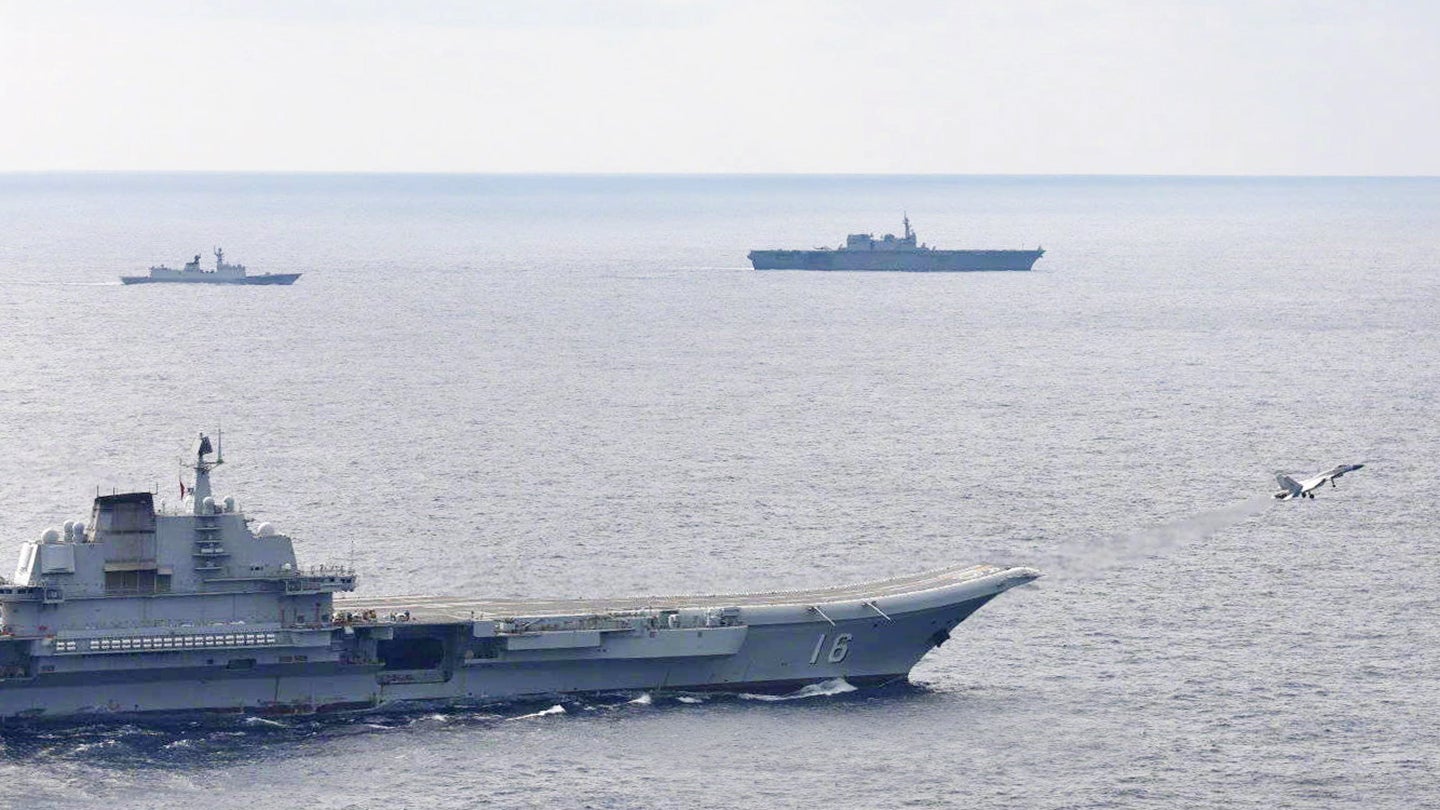
China Releases Image Of Japanese Carrier Sailing Right Alongside Its Own Carrier
Japan's use of its aircraft carrier to closely shadow China's own is highly unusual.
Last edited:
jward
passin' thru
Apex
@Apex_WW
1m
South Korean crosses armed border in rare defection to North
View: https://twitter.com/Apex_WW/status/1477472956079091714?s=20
@Apex_WW
1m
South Korean crosses armed border in rare defection to North
View: https://twitter.com/Apex_WW/status/1477472956079091714?s=20
jward
passin' thru
Indo-Pacific News - Watching the CCP-China Threat
@IndoPac_Info
21m
#US on Sidelines as #China joins U.S. allies including #Japan & #Australia in a new Asia-Pacific trade agreement that launches Saturday The Regional Comprehensive Economic Partnership will eventually eliminate over 90% of tariffs on 15 member countries.
View: https://twitter.com/IndoPac_Info/status/1477482137800429573?s=20
@IndoPac_Info
21m
#US on Sidelines as #China joins U.S. allies including #Japan & #Australia in a new Asia-Pacific trade agreement that launches Saturday The Regional Comprehensive Economic Partnership will eventually eliminate over 90% of tariffs on 15 member countries.
View: https://twitter.com/IndoPac_Info/status/1477482137800429573?s=20
jward
passin' thru
Trump’s Grand Strategy on China
The former US president calls Chinese leader Xi Jinping a 'killer' over COVID-19 deaths
Former President Donald Trump recently outlined his diplomatic, economic, and military strategies on China.
On Dec. 19, Maria Bartiromo of Fox News got an exclusive interview with Trump. He dropped verbal bombs on China that got close to the real thing, including plans for a U.S. air base in Afghanistan and demands for $60 trillion in COVID-19 damages.
Trump is the most likely Republican presidential candidate in 2024 at a time when President Joe Biden suffers from historically low approval ratings. So what Trump thinks about China is of the greatest importance.
But mainstream media outlets only partially, if at all, covered what Trump had to say. Some tried to make him look soft on China, which could only be supported by out-of-context quotes that ignored the main points of his speech.
Provided here is a fuller account and analysis of the Trump-Bartiromo interview as it touched on China issues. In particular, this analysis looks at the interview for clues on Trump’s preferred grand strategy—including its diplomatic, economic, and military elements—on the issue of China.
America’s Low Point due to China and Allies
A recurring point during the Fox interview was that America is at a low point due to its biggest international adversaries.
“Our country has never been so disrespected as it is now by China, Russia, North Korea, and everybody else—Iran,” said Trump. “There’s never been a time like this. The Afghan withdrawal—I wanted to withdraw more than anybody, and I was doing it beautifully, with power and strength. The way he [Biden] just came in and surrendered—I think when China, when Russia, when these people are looking at what happened … I think it is the lowest point.”
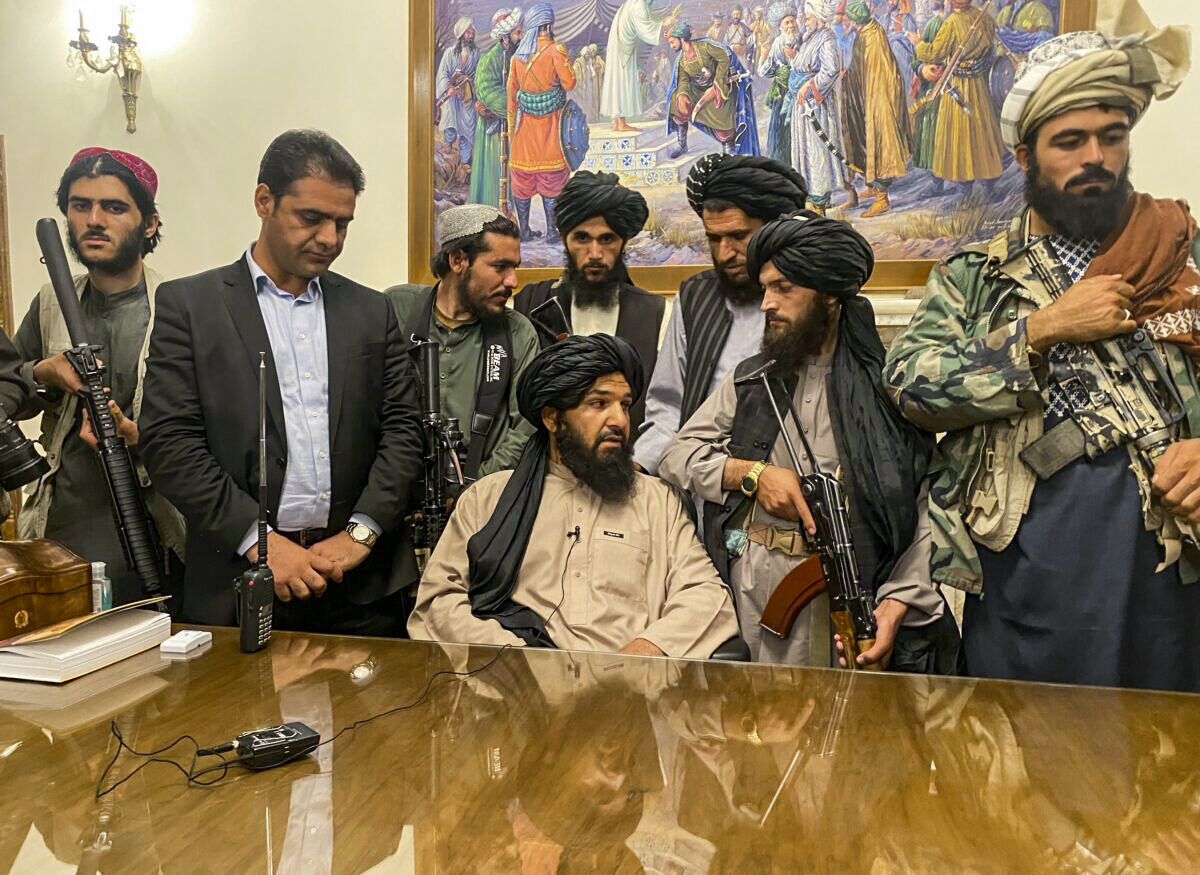 Taliban terrorists take control of the Afghan presidential palace after Afghan President Ashraf Ghani fled the country, in Kabul, Afghanistan, on Aug. 15, 2021. (Zabi Karimi/AP Photo)
Taliban terrorists take control of the Afghan presidential palace after Afghan President Ashraf Ghani fled the country, in Kabul, Afghanistan, on Aug. 15, 2021. (Zabi Karimi/AP Photo)
Trump’s Diplomatic Strategy on China
Trump’s diplomatic strategy with major adversaries like China is to first extend a friendly hand, to the point of flattery, and only later to resort to hard power strategies such as military containment or economic tariffs. This strategy was revealed in his initial friendly approach to Chinese Communist Party (CCP) General Secretary Xi Jinping, which included chocolate cake and an attempt to improve trade relations.
Trump’s perception of his positive relationship with Xi changed for the worse “once Covid came along, or the China virus as I call it, because it is a much more accurate term.”
When Trump said during the interview that “I had a great relationship with President Xi … I really believed he liked me, and I liked him,” Bartiromo broke in and said, “He’s a killer.”
Trump agreed. “He is a killer. But I had a great relationship with him. Once Covid came it was a different story. Because they have really, not only this country, they have really destroyed the world, the whole world, if you look at what’s going on.”
Sports Diplomacy
On the Olympics, Trump said that American athletes should compete in the Beijing 2022 Winter Games and “win every single medal.” He said of the proposed boycott by athletes, “I watched Jimmy Carter do it and it was terrible … it hurts the athletes.”
Much of the mainstream media reported Trump’s position on sending athletes to Beijing, but did not put it in context by quoting his next thought: “There are much more powerful things we can do than that [boycott]. … That’s not a powerful thing. It almost makes us look like sore losers.”
Here Trump is not likely to get much support from conservative China watchers. They tend to want tough talk on boycotting, or better yet, moving, the Games to a friendly democratic country like Japan or Canada.
Foreign Influence
Bartiromo pointed out that Biden has not, in the course of four meetings with Xi this year, brought up the origins of COVID-19. She asked why that might be.
Trump replied that Biden does not want to “because he’s afraid of him, and I think he’s afraid of the fact that they gave billions of dollars to his son.”
Bartiromo suggested, “So they have something on him.”
“Yeah, of course they do,” Trump replied.
“I asked friends of yours, the biggest people there are in terms of Wall Street: can you go into China and walk away with $1.5 billion dollars?” said Trump.
“These are … the guys with the big companies, that run the big companies, Wall Street firms. He said nobody does that, nobody. The most sophisticated guy on Wall Street can’t walk in and walk out in 10 minutes with $1.5 billion. And he [Hunter Biden] gets fees on all that money—tens of millions of dollars,” said Trump.
Hunter’s lawyers dispute the $1.5 billion figure. But it is now established that Hunter has engaged in very large business deals with China, from which his father may have financially benefited.
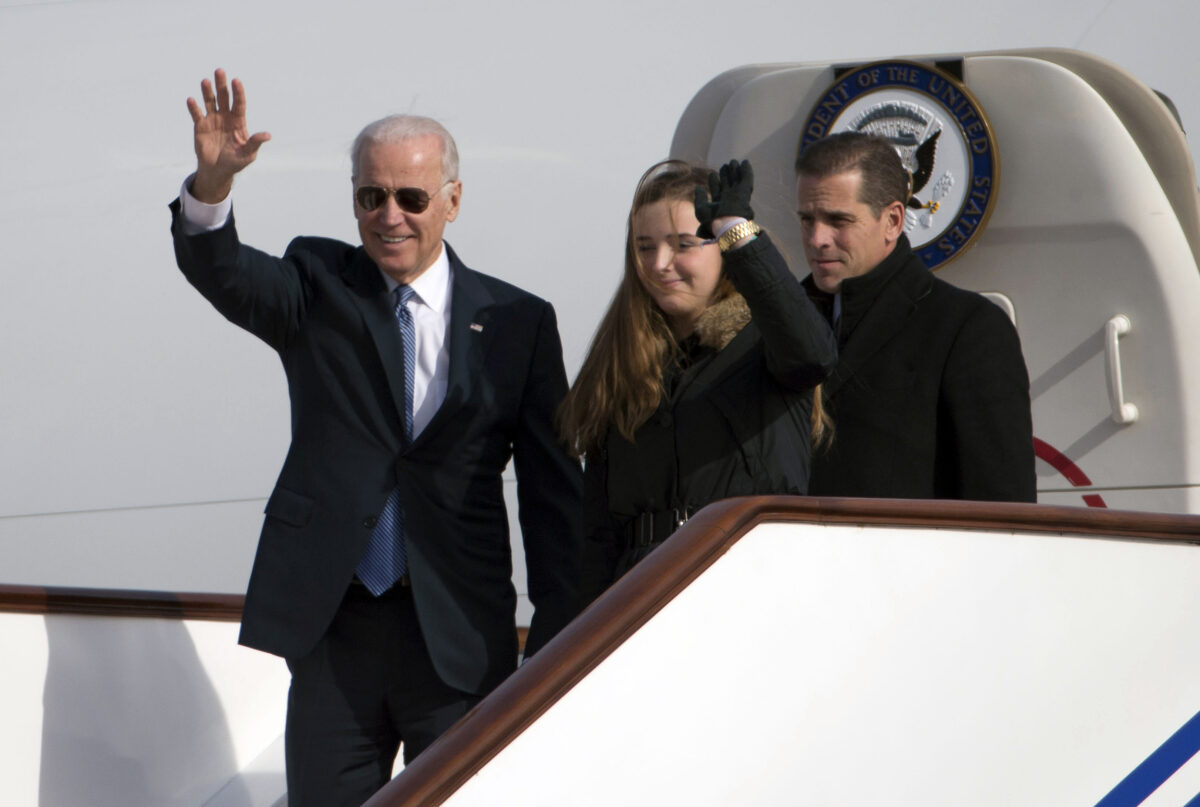 Then-Vice President Joe Biden waves as he walks out of Air Force Two with his granddaughter, Finnegan Biden (center) and son Hunter Biden (right) upon their arrival in Beijing on Dec. 4, 2013. (Ng Han Guan/AFP via Getty Images)
Then-Vice President Joe Biden waves as he walks out of Air Force Two with his granddaughter, Finnegan Biden (center) and son Hunter Biden (right) upon their arrival in Beijing on Dec. 4, 2013. (Ng Han Guan/AFP via Getty Images)
According to The Wall Street Journal: “The dealings got the younger Mr. Biden a discounted stake in a private-equity firm in China. … A Chinese energy tycoon gave Mr. Biden a 2.8-carat diamond, and entities linked to him wired nearly $5 million to Mr. Biden’s law firm, according to an investigation by Senate Republicans.”
In light of these facts, Trump’s diplomatic strategy on China will likely be to decrease the influence of foreign money in the United States, and to continue with attempts to personally appeal to Xi even as he twists the economic and military screws of hard power a few turns further to the right.
Trump’s Economic Strategy on China
During the Fox interview, Trump discussed how his China tariffs both increased funds in the U.S. Treasury, and incentivized companies to invest elsewhere.
“China economically has been ripping us off for many years,” Trump said. “I’ve been talking about it for a long time. Five hundred billion dollars a year [worth of ripoffs]. I’m the first one [to impose tariffs]—we’ve been taking in hundreds of billions of dollars [in tariffs] … from China.”
Trump pointed out that the tariff revenues and trade deals with China went to American farmers and manufacturers. “Our farmers are rich now because of the deal I made with China,” Trump said.
Trump returned to the issue of China tariffs later in his interview by saying that China’s annual $500 billion ripoff of America is “not sustainable.” He said that it could be opposed by “what I did with the taxes and tariffs on China.”
Trump said that America did not take in “ten cents” worth of tariffs prior to his administration. Biden used to argue against the tariffs, Trump said, but he has not canceled them because “it is so much money.”
Trump said that the tariffs caused companies to move back into the United States. “But now they stopped because they think he [Biden] is going to take the tariffs off, and that is a shame.”
COVID-19 Damages of $60 Trillion
The Trump-Bartiromo interview, which Fox edited, started with Trump stating about COVID-19: “I think the origins are so obvious. They came out of the Wuhan lab. And I think that if anyone thinks anything differently, they’re just kidding themselves.”
Trump said that people must ask whether China should pay reparations for COVID-19, which is eminently reasonable given arguments by Professor James Kraska, who holds dual appointments at the U.S. Naval War College and Harvard University, that China is legally responsible for up to “trillions” of dollars in damages.
The Epoch Times argued in May for at least $19 trillion in damages for 6.9 million deaths globally, including “economic damages from the lockdown, suffering to survivors, costs borne by society from hospitalization and new vaccines, future damages from the ongoing growth of the pandemic, or criminal penalties.”
During the Fox interview, Trump argued: “China doesn’t have the money to pay those reparations. I believe that worldwide, I’m not just talking about the United States, worldwide $60 trillion dollars of damages” are owed.
This could be an underestimate given all of the damages due to global economic dislocation and injuries.
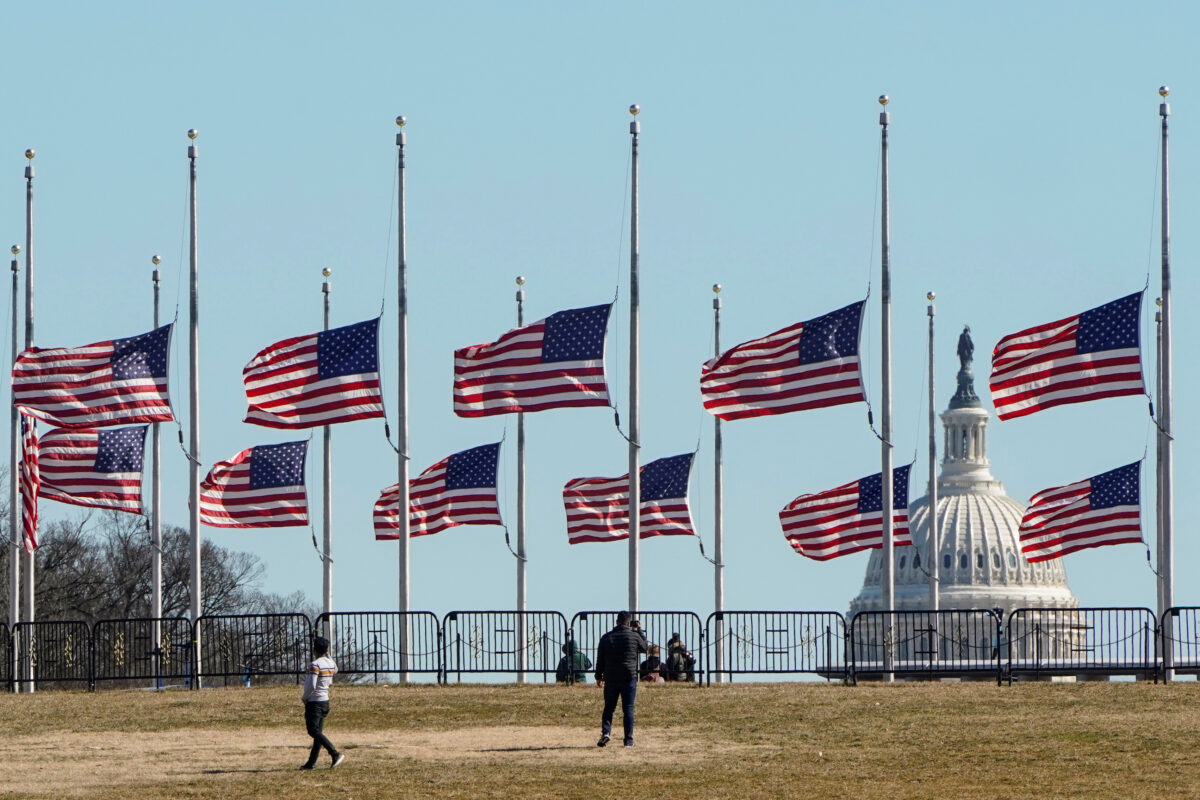 People walk past flags flying at half staff at the Washington Monument in memory of 500,000 deaths due to COVID-19 in Washington on Feb. 24, 2021. (Joshua Roberts/Reuters)
People walk past flags flying at half staff at the Washington Monument in memory of 500,000 deaths due to COVID-19 in Washington on Feb. 24, 2021. (Joshua Roberts/Reuters)
Trump said that China must “do something to make up for what they have done. What they have done to the world is so horrible.”
On Anthony Fauci, the director of the National Institute of Allergy and Infectious Diseases and the chief medical adviser to the president, Trump said that “he wanted to keep our country open to China, and I closed it. He wanted to keep our country open to Europe, and I closed it.”
Trump’s economic strategy on China will likely be to maintain tariffs, push for compensation over COVID-19 damages, and keep the U.S. economy open even as it closes to countries that pose an existential risk to the international system and American democracy.
Trump’s Military Strategy on China
One of the most interesting comments by Trump was when Bartiromo asked him, “Do you think that the Chinese will take over the Bagram Air Base?” His answer revealed a military strategy of containing China, and a forward-leaning posture against China’s nuclear weapons development. The “sovereignty” of Afghanistan, which is leaning toward an alliance with China, would have to be deprioritized relative to the superpower conflict between Washington and Beijing.
Trump replied to Bartiromo that there were six military air bases in Afghanistan. “I was going to bomb five and keep Bagram,” Trump said. Bagram air base, just 25 miles north of the capital city of Kabul, is the biggest air base in the country.
“But the reason I was going to keep it [Bagram] wasn’t for Afghanistan,” Trump said. “It was because of China. It’s one hour away from where they make their nuclear weapons. It has the largest runways and the most powerful runways for heavy [bombers?]—they [the runways] are very powerful and thick, in some cases eight feet of concrete.”
Trump pointed out that the United States spent billions of dollars building Bagram.
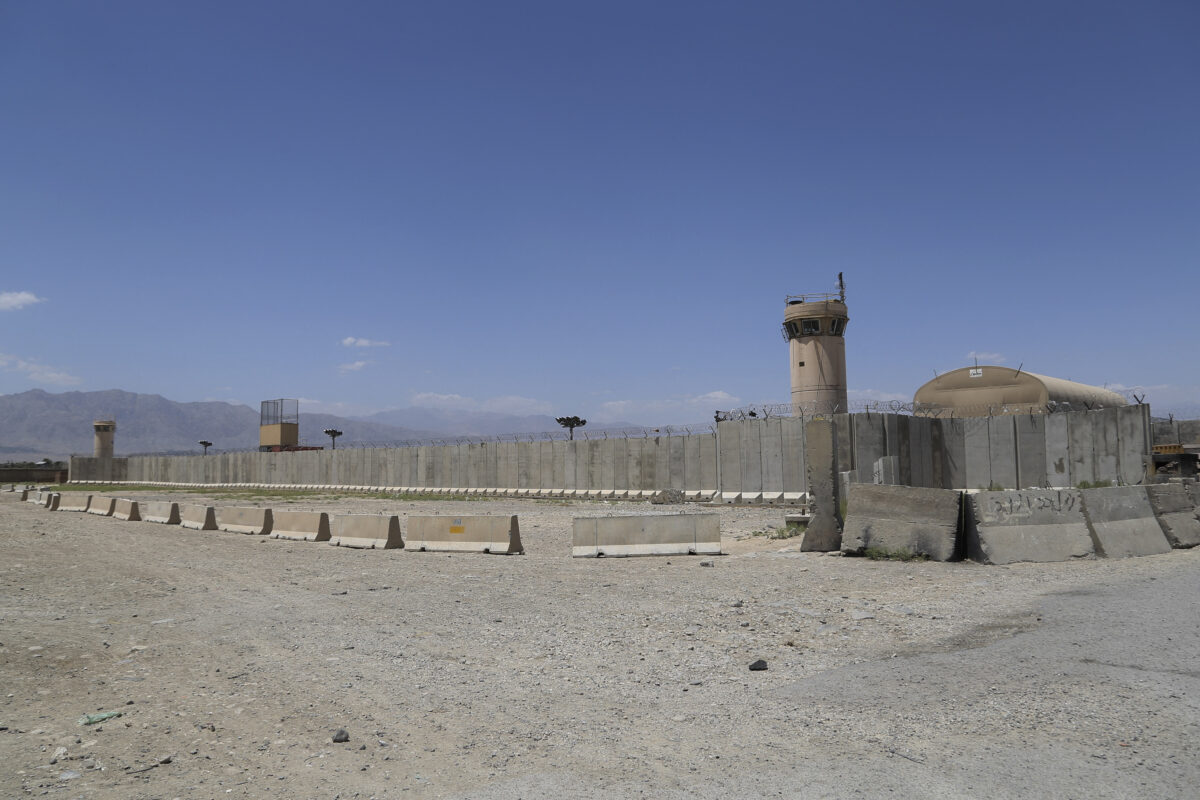 A view of Bagram Air Base after all U.S. and NATO troops left, some 43 miles north of Kabul, Afghanistan, on July 2, 2021. (Zakeria Hashimi/AFP via Getty Images)
A view of Bagram Air Base after all U.S. and NATO troops left, some 43 miles north of Kabul, Afghanistan, on July 2, 2021. (Zakeria Hashimi/AFP via Getty Images)
Bartiromo suggested to Trump that when he invited Xi to Mar-a-Lago in Palm Beach, China was already the biggest threat.
Trump answered, “Not only China, but China from an economic standpoint is massive. Russia’s not massive from that standpoint but their military power, and China’s a great military power [too].”
Trump said later in the interview that during his presidency, China and Russia were less aggressive. Bombers did not fly over Taiwan, and unlike during the Obama administration, Russia was not able to take territory from Ukraine.
This is largely true, and likely due to Trump’s prioritization of American military spending and economic competitiveness—two forms of hard power—as a counterweight against China’s territorial aggression.
In Ukraine, for example, Trump provided lethal military assistance to the Ukrainian military, including Javelin anti-tank missiles, that the Obama administration refused to supply. This, despite Trump being called pro-Russia by the mainstream press at a time when bringing Moscow in as an ally against Beijing would have been particularly useful.
The Ukraine and Afghanistan cases—both bordering major adversaries Russia and China—provide a clue as to Trump’s military strategy against America’s biggest adversaries. That strategy is containment from a position of strength, including through forward-deployed forces—for example, in Eastern Europe, Japan, South Korea, and Afghanistan—as well as the provision of increased lethal military assistance to “the enemies of our enemies,” including Taiwan.
Trump’s Grand Strategy on China
In the Fox interview, Trump effectively delivered a big picture to the public of the national security threats to America from China, Russia, North Korea, and Iran, in that order.
Trump discussed a grand strategy to defend America from China, including military, economic, and diplomatic sub-strategies. He addressed the issue of foreign influence through business relations and elite capture.
Trump indicated a forward-leaning approach to China that would rightly demand $60 trillion in global reparations, and contain China and Russia militarily from a position of strength that includes forward deployment of U.S. military forces, such as at Bagram air base in Afghanistan.
Views expressed in this article are the opinions of the author and do not necessarily reflect the views of The Epoch Times.
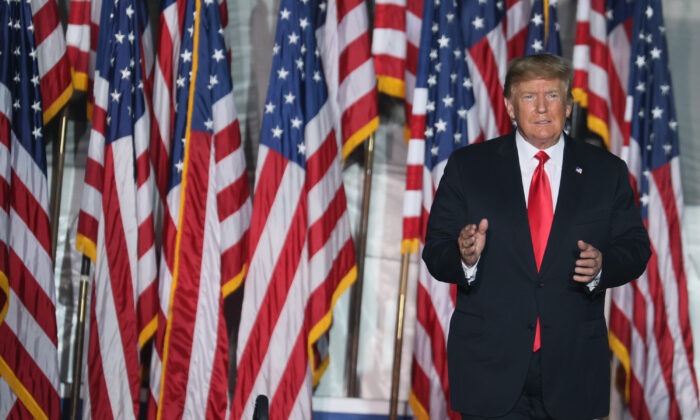
 www.theepochtimes.com
www.theepochtimes.com
The former US president calls Chinese leader Xi Jinping a 'killer' over COVID-19 deaths
Former President Donald Trump recently outlined his diplomatic, economic, and military strategies on China.
On Dec. 19, Maria Bartiromo of Fox News got an exclusive interview with Trump. He dropped verbal bombs on China that got close to the real thing, including plans for a U.S. air base in Afghanistan and demands for $60 trillion in COVID-19 damages.
Trump is the most likely Republican presidential candidate in 2024 at a time when President Joe Biden suffers from historically low approval ratings. So what Trump thinks about China is of the greatest importance.
But mainstream media outlets only partially, if at all, covered what Trump had to say. Some tried to make him look soft on China, which could only be supported by out-of-context quotes that ignored the main points of his speech.
Provided here is a fuller account and analysis of the Trump-Bartiromo interview as it touched on China issues. In particular, this analysis looks at the interview for clues on Trump’s preferred grand strategy—including its diplomatic, economic, and military elements—on the issue of China.
America’s Low Point due to China and Allies
A recurring point during the Fox interview was that America is at a low point due to its biggest international adversaries.
“Our country has never been so disrespected as it is now by China, Russia, North Korea, and everybody else—Iran,” said Trump. “There’s never been a time like this. The Afghan withdrawal—I wanted to withdraw more than anybody, and I was doing it beautifully, with power and strength. The way he [Biden] just came in and surrendered—I think when China, when Russia, when these people are looking at what happened … I think it is the lowest point.”
 Taliban terrorists take control of the Afghan presidential palace after Afghan President Ashraf Ghani fled the country, in Kabul, Afghanistan, on Aug. 15, 2021. (Zabi Karimi/AP Photo)
Taliban terrorists take control of the Afghan presidential palace after Afghan President Ashraf Ghani fled the country, in Kabul, Afghanistan, on Aug. 15, 2021. (Zabi Karimi/AP Photo) Trump’s Diplomatic Strategy on China
Trump’s diplomatic strategy with major adversaries like China is to first extend a friendly hand, to the point of flattery, and only later to resort to hard power strategies such as military containment or economic tariffs. This strategy was revealed in his initial friendly approach to Chinese Communist Party (CCP) General Secretary Xi Jinping, which included chocolate cake and an attempt to improve trade relations.
Trump’s perception of his positive relationship with Xi changed for the worse “once Covid came along, or the China virus as I call it, because it is a much more accurate term.”
When Trump said during the interview that “I had a great relationship with President Xi … I really believed he liked me, and I liked him,” Bartiromo broke in and said, “He’s a killer.”
Trump agreed. “He is a killer. But I had a great relationship with him. Once Covid came it was a different story. Because they have really, not only this country, they have really destroyed the world, the whole world, if you look at what’s going on.”
Sports Diplomacy
On the Olympics, Trump said that American athletes should compete in the Beijing 2022 Winter Games and “win every single medal.” He said of the proposed boycott by athletes, “I watched Jimmy Carter do it and it was terrible … it hurts the athletes.”
Much of the mainstream media reported Trump’s position on sending athletes to Beijing, but did not put it in context by quoting his next thought: “There are much more powerful things we can do than that [boycott]. … That’s not a powerful thing. It almost makes us look like sore losers.”
Here Trump is not likely to get much support from conservative China watchers. They tend to want tough talk on boycotting, or better yet, moving, the Games to a friendly democratic country like Japan or Canada.
Foreign Influence
Bartiromo pointed out that Biden has not, in the course of four meetings with Xi this year, brought up the origins of COVID-19. She asked why that might be.
Trump replied that Biden does not want to “because he’s afraid of him, and I think he’s afraid of the fact that they gave billions of dollars to his son.”
Bartiromo suggested, “So they have something on him.”
“Yeah, of course they do,” Trump replied.
“I asked friends of yours, the biggest people there are in terms of Wall Street: can you go into China and walk away with $1.5 billion dollars?” said Trump.
“These are … the guys with the big companies, that run the big companies, Wall Street firms. He said nobody does that, nobody. The most sophisticated guy on Wall Street can’t walk in and walk out in 10 minutes with $1.5 billion. And he [Hunter Biden] gets fees on all that money—tens of millions of dollars,” said Trump.
Hunter’s lawyers dispute the $1.5 billion figure. But it is now established that Hunter has engaged in very large business deals with China, from which his father may have financially benefited.
 Then-Vice President Joe Biden waves as he walks out of Air Force Two with his granddaughter, Finnegan Biden (center) and son Hunter Biden (right) upon their arrival in Beijing on Dec. 4, 2013. (Ng Han Guan/AFP via Getty Images)
Then-Vice President Joe Biden waves as he walks out of Air Force Two with his granddaughter, Finnegan Biden (center) and son Hunter Biden (right) upon their arrival in Beijing on Dec. 4, 2013. (Ng Han Guan/AFP via Getty Images)According to The Wall Street Journal: “The dealings got the younger Mr. Biden a discounted stake in a private-equity firm in China. … A Chinese energy tycoon gave Mr. Biden a 2.8-carat diamond, and entities linked to him wired nearly $5 million to Mr. Biden’s law firm, according to an investigation by Senate Republicans.”
In light of these facts, Trump’s diplomatic strategy on China will likely be to decrease the influence of foreign money in the United States, and to continue with attempts to personally appeal to Xi even as he twists the economic and military screws of hard power a few turns further to the right.
Trump’s Economic Strategy on China
During the Fox interview, Trump discussed how his China tariffs both increased funds in the U.S. Treasury, and incentivized companies to invest elsewhere.
“China economically has been ripping us off for many years,” Trump said. “I’ve been talking about it for a long time. Five hundred billion dollars a year [worth of ripoffs]. I’m the first one [to impose tariffs]—we’ve been taking in hundreds of billions of dollars [in tariffs] … from China.”
Trump pointed out that the tariff revenues and trade deals with China went to American farmers and manufacturers. “Our farmers are rich now because of the deal I made with China,” Trump said.
Trump returned to the issue of China tariffs later in his interview by saying that China’s annual $500 billion ripoff of America is “not sustainable.” He said that it could be opposed by “what I did with the taxes and tariffs on China.”
Trump said that America did not take in “ten cents” worth of tariffs prior to his administration. Biden used to argue against the tariffs, Trump said, but he has not canceled them because “it is so much money.”
Trump said that the tariffs caused companies to move back into the United States. “But now they stopped because they think he [Biden] is going to take the tariffs off, and that is a shame.”
COVID-19 Damages of $60 Trillion
The Trump-Bartiromo interview, which Fox edited, started with Trump stating about COVID-19: “I think the origins are so obvious. They came out of the Wuhan lab. And I think that if anyone thinks anything differently, they’re just kidding themselves.”
Trump said that people must ask whether China should pay reparations for COVID-19, which is eminently reasonable given arguments by Professor James Kraska, who holds dual appointments at the U.S. Naval War College and Harvard University, that China is legally responsible for up to “trillions” of dollars in damages.
The Epoch Times argued in May for at least $19 trillion in damages for 6.9 million deaths globally, including “economic damages from the lockdown, suffering to survivors, costs borne by society from hospitalization and new vaccines, future damages from the ongoing growth of the pandemic, or criminal penalties.”
During the Fox interview, Trump argued: “China doesn’t have the money to pay those reparations. I believe that worldwide, I’m not just talking about the United States, worldwide $60 trillion dollars of damages” are owed.
This could be an underestimate given all of the damages due to global economic dislocation and injuries.
 People walk past flags flying at half staff at the Washington Monument in memory of 500,000 deaths due to COVID-19 in Washington on Feb. 24, 2021. (Joshua Roberts/Reuters)
People walk past flags flying at half staff at the Washington Monument in memory of 500,000 deaths due to COVID-19 in Washington on Feb. 24, 2021. (Joshua Roberts/Reuters)Trump said that China must “do something to make up for what they have done. What they have done to the world is so horrible.”
On Anthony Fauci, the director of the National Institute of Allergy and Infectious Diseases and the chief medical adviser to the president, Trump said that “he wanted to keep our country open to China, and I closed it. He wanted to keep our country open to Europe, and I closed it.”
Trump’s economic strategy on China will likely be to maintain tariffs, push for compensation over COVID-19 damages, and keep the U.S. economy open even as it closes to countries that pose an existential risk to the international system and American democracy.
Trump’s Military Strategy on China
One of the most interesting comments by Trump was when Bartiromo asked him, “Do you think that the Chinese will take over the Bagram Air Base?” His answer revealed a military strategy of containing China, and a forward-leaning posture against China’s nuclear weapons development. The “sovereignty” of Afghanistan, which is leaning toward an alliance with China, would have to be deprioritized relative to the superpower conflict between Washington and Beijing.
Trump replied to Bartiromo that there were six military air bases in Afghanistan. “I was going to bomb five and keep Bagram,” Trump said. Bagram air base, just 25 miles north of the capital city of Kabul, is the biggest air base in the country.
“But the reason I was going to keep it [Bagram] wasn’t for Afghanistan,” Trump said. “It was because of China. It’s one hour away from where they make their nuclear weapons. It has the largest runways and the most powerful runways for heavy [bombers?]—they [the runways] are very powerful and thick, in some cases eight feet of concrete.”
Trump pointed out that the United States spent billions of dollars building Bagram.
 A view of Bagram Air Base after all U.S. and NATO troops left, some 43 miles north of Kabul, Afghanistan, on July 2, 2021. (Zakeria Hashimi/AFP via Getty Images)
A view of Bagram Air Base after all U.S. and NATO troops left, some 43 miles north of Kabul, Afghanistan, on July 2, 2021. (Zakeria Hashimi/AFP via Getty Images)Bartiromo suggested to Trump that when he invited Xi to Mar-a-Lago in Palm Beach, China was already the biggest threat.
Trump answered, “Not only China, but China from an economic standpoint is massive. Russia’s not massive from that standpoint but their military power, and China’s a great military power [too].”
Trump said later in the interview that during his presidency, China and Russia were less aggressive. Bombers did not fly over Taiwan, and unlike during the Obama administration, Russia was not able to take territory from Ukraine.
This is largely true, and likely due to Trump’s prioritization of American military spending and economic competitiveness—two forms of hard power—as a counterweight against China’s territorial aggression.
In Ukraine, for example, Trump provided lethal military assistance to the Ukrainian military, including Javelin anti-tank missiles, that the Obama administration refused to supply. This, despite Trump being called pro-Russia by the mainstream press at a time when bringing Moscow in as an ally against Beijing would have been particularly useful.
The Ukraine and Afghanistan cases—both bordering major adversaries Russia and China—provide a clue as to Trump’s military strategy against America’s biggest adversaries. That strategy is containment from a position of strength, including through forward-deployed forces—for example, in Eastern Europe, Japan, South Korea, and Afghanistan—as well as the provision of increased lethal military assistance to “the enemies of our enemies,” including Taiwan.
Trump’s Grand Strategy on China
In the Fox interview, Trump effectively delivered a big picture to the public of the national security threats to America from China, Russia, North Korea, and Iran, in that order.
Trump discussed a grand strategy to defend America from China, including military, economic, and diplomatic sub-strategies. He addressed the issue of foreign influence through business relations and elite capture.
Trump indicated a forward-leaning approach to China that would rightly demand $60 trillion in global reparations, and contain China and Russia militarily from a position of strength that includes forward deployment of U.S. military forces, such as at Bagram air base in Afghanistan.
Views expressed in this article are the opinions of the author and do not necessarily reflect the views of The Epoch Times.

Trump’s Grand Strategy on China
Japan Wants To Arm Its Submarines With Long-Range Cruise Missiles: Report
The missiles would offer land-attack and anti-ship capabilities and would be expected to serve as a deterrent to China and North Korea.
By Thomas Newdick December 30, 2021
Recent reports indicate that Japan is considering introducing a new long-range cruise missile capability to its existing submarine fleet, or future submarines, with a weapon that would have a range of over 620 miles and would be fielded from the latter half of the 2020s. The indigenous missile would provide the Japan Maritime Self-Defense Force, or JMSDF, with a new standoff capability to attack both enemy surface warships and land targets and is clearly seen as a potential counter to offset growing threats from China and North Korea.
A report in Japan’s Yomiuri Shimbun newspaper cites several unnamed government officials who confirm that Tokyo is looking at the possibility of equipping current and/or future JMSDF submarines with long-range cruise missiles. These would be derived from the Type 12 subsonic anti-ship missile that’s already in service with the Japan Ground Self-Defense Force, or JGSDF, and which has a range of around 124 miles in its current form. At this stage, both vertical launch system (VLS) and torpedo-tube-launched options are being examined for the new missile. As it stands, the JMSDF does not have any submarine-based VLS in service. There is also currently no confirmation of the size of magazine capacity being considered for the missile-armed submarines.

JGSDF
Test-firing of a Japan Ground Self-Defense Forces Type 12 anti-ship missile.
The Yomiuri Shimbun report stresses the potential for JMSDF submarines armed with the new cruise missiles to attack ground targets, in particular “enemy missile launch bases for the purpose of self-defense.” However, an accompanying graphic shows a submerged submarine using the same weapon to target a hostile surface combatant, as well. Indeed, the article suggests that the anti-ship version of the missile would actually be introduced first, “to counterattack enemy ships from outside the missile range of the opponent,” before the same weapon is further adapted for “attacking enemy bases in the future.” Ultimately, it would seem likely that a single missile would be furnished for both anti-ship and land-attack roles, as is the case with the Tomahawk Block IV, or the Norwegian-designed Joint Stike Missile (JSM), which Japan has procured for its F-35 stealth jets.
The emphasis on “self-defense” reflects the need for the Japanese military to at least frame capabilities such as these within the context of the country’s constitution, which rules out offensive action. However, the reality around this provision is fast degrading, with significant recent developments including acceptance of fixed-wing-capable aircraft carriers.
A precise timeline for the development of the new long-range cruise missile has not been revealed, although planned service entry toward the end of this decade seems ambitious, especially considering the VLS containers would have to be retrofitted to existing boats, space permitting, or otherwise installed in still-to-be-launched submarines. It is worth noting that South Korea is currently understood to be working on building Dosan Ahn Changho class submarines with progressively increased VLS cells, starting with six and working up to 10, which will accommodate cruise missiles or ballistic missiles. This kind of step-by-step approach might be an option for Japan, too, as would opting for torpedo tube-launched missiles on older boats and VLS in new-construction hulls.
The JMSDF’s submarines are already equipped with Harpoon anti-ship missiles that are launched from standard torpedo tubes, but they have a much shorter range than is anticipated for the new weapon and no land-attack capability. The latest UGM-84L Harpoon Block II in JMSDF service can reach targets out to around 80 miles.
The report states that Prime Minister Fumio Kishida aims to include the “capacity to attack enemy bases” in the country’s next National Security Strategy, which is due to be published late next year, and which will set out Tokyo’s medium to long-term guidelines for defense and foreign policies. Submarine-launched missiles would be one way of achieving that goal. With the JMSDF operating a fleet of 22 conventionally powered submarines, and with at least two more to be added in the future, there are potentially plenty of hulls that could be adapted. However, an air-launched or ship-based land-attack cruise missile would also seem to fit this requirement.
On the other hand, work is already underway to extend the range of the truck-launched Type 12 anti-ship missile as well as to adapt it for potential air launch by Japan Air Self-Defense Force, or JASDF, F-15J fighter jets, as part of an upgrade for these aircraft.

BOEING
An artist’s impression of an upgraded Japanese F-15J carrying an AGM-158 Joint Air-to-Surface Standoff Missile (JASSM) on its centerline. This is one option for a long-range missile that could be added as part of the F-15J upgrade.
Initial work on an extended-range Type 12 began back in the 2018 fiscal year, but, in December last year, it was reported that Tokyo had decided to embark on a related redesign of the missile, adding larger flying surfaces and a powerplant optimized for high-altitude flight, as well as additional fuel. That would increase the range from the current 124 miles to 560 miles, and, later, up to 930 miles. Even with the initial range extension, the new weapon would be in broadly the same category that’s required for the new cruise missile. Importantly, the revised Type 12 would also be capable of hitting ground targets and is also planned to incorporate radar cross-section reduction measures, making it harder to detect. At the time, there was no mention that this extended-range Type 12 was envisaged for submarine launch as well.
However, work on these revisions to the Type 12 was expected to be carried out between fiscal years 2019 and 2023, which would also fit with the timescale required for the submarine-launched cruise missile.
The Type 12 ground-launched anti-ship missile:
A dual-role long-range cruise missile would be of considerable value to the JMSDF as it contends with a rapidly growing fleet of Chinese surface warships. Activity by People’s Liberation Army Navy (PLAN) warships in the waters around Japan and in the South China Sea and the East China Sea — the latter home to a long-running dispute over ownership of an uninhabited island chain — has increased in recent years and now includes aircraft carrier battle groups.
At the same time, the land-attack configuration of the new weapon would allow Japan to strike against critical ground targets, such as the proliferating ballistic missile capabilities in both China and North Korea. The latter country has, on multiple occasions, launched ballistic missiles capable of reaching Japan into waters off that country. Other critical military and leadership infrastructure, as well as airbases and air-defense sites, would be likely targets for the JSMDF’s long-range cruise missiles in times of conflict.
Should either China or North Korea attempt to attack Japan, a submarine-based land-attack cruise missile capability provides a much more survivable means of delivering a counterstrike, even if considerable numbers of aircraft and surface vessels have already been hit in the enemy’s first strike. The effectiveness would be enhanced by not only the relatively large size of the JMSDF’s submarine fleet, but also the fact that it operates some of the most advanced conventionally powered boats in service anywhere in the world, and among the quietest, including a propulsion arrangement based around lithium-ion batteries in the newest boats.

Japanese Ministry of Defense
Japan’s most advanced submarine, the Taigei is launched in October 2020 in the city of Kobe.
However, with the modifications to the Type 12 in mind, it seems work on producing a long-range cruise missile may already be fairly well advanced. There are also unconfirmed reports that the lead boat in the Taigei class may be planned for use as a trials submarine, to assess the viability of VLS or tube-launched cruise missiles. Reportedly, a hull section matching the dimensions of the Taigei class has been noted at the Mitsubishi Heavy Industries dockyard in Kobe with an enlarged upper part that may relate to tests of a VLS installation.
Japan has also looked in the past at an off-the-shelf purchase of Tomahawk cruise missiles from the United States, which we reported on back in 2017. The plan was to use these missiles as standoff retaliatory strike weapons against North Korean missile launchers and launch facilities. While this parallels at least part of the mission expected of the long-range cruise missile, Japan’s Tomahawk plans envisaged acquiring a surface-warship-launched version of the missile, rather than a sub-launched one. Although there has been no serious move since then to buy Tomahawks, the Block IV version of the missile appears to meet Japanese requirements perfectly.
As well as adding an all-new land-attack mission to the submarine fleet, introducing a weapon of this type with the ability to strike well beyond Japan’s territorial boundaries would again signal the continued shift away from the traditional purely ‘defensive’ nature of its military. The same missile could also very likely be easily adapted for launch from VLS cells onboard JMSDF surface warships, too. Whatever form the future long-range cruise missile takes, it’s now clear that the country’s strategic posture is increasingly calling for these kinds of long-range strike capabilities as part of the submarine force and the wider armed forces.

Japan Wants To Arm Its Submarines With Long-Range Cruise Missiles: Report
The missiles would offer land-attack and anti-ship capabilities and would be expected to serve as a deterrent to China and North Korea.www.thedrive.com
Well that took a bit longer than I thought it would.....
jward
passin' thru
Restoring America
Joel Gehrke
5-6 minutes
Chinese Communist Party officials have unveiled an “action plan for cooperation” with Latin American countries that amounts to a “comprehensive” plan to cultivate influence and threaten American interests, following a new ministerial with the nearest neighbors of the United States.
“The Chinese don’t say, ‘We want to take over Latin America,’ but they clearly set out a multidimensional engagement strategy, which, if successful, would significantly expand their leverage and produce enormous intelligence concerns for the United States,” U.S. Army War College research professor Evan Ellis, a former member of the State Department policy planning staff, told the Washington Examiner.
Chinese officials outlined their ambitions following a ministerial with the Community of Latin American and Caribbean States. This intergovernmental forum was launched in 2011 under the auspices of the late Venezuelan President Hugo Chavez, who wanted a venue to rival the Organization of American States and challenge U.S. influence in Latin America, and it now stands to furnish Chinese General Secretary Xi Jinping with a platform to gather a coalition of leftist and authoritarian leaders congenial to Beijing’s interests.
“The Chinese Communist Party and government are actively looking to strengthen their ties throughout the Western Hemisphere, in particular with anti-American elements,” Florida Sen. Marco Rubio, a senior Senate Intelligence Select Committee Republican, said in a statement to the Washington Examiner. “Beijing is seeking to surpass the United States in every sector, and we must take this threat seriously.”
China’s exploitation of ideological fault lines in Latin America was thrown into sharp relief earlier this month, when Nicaraguan President Daniel Ortega, just weeks after the OAS General Assembly rebuked him for overseeing elections that “were not free, fair, or transparent and have no democratic legitimacy,” opted to close the Taiwanese Embassy in favor of a new relationship with Beijing.
“The Ortega-Murillo regime has announced it has severed diplomatic relations and ended official contact with Taiwan, but the sham election on Nov. 7 did not provide it with any mandate to remove Nicaragua from the family of American democracies,” State Department spokesman Ned Price said in a Dec. 9 response. “Without the mandate that comes with a free and fair election, Ortega's actions cannot reflect the will of the Nicaraguan people, who continue to struggle for democracy and the ability to exercise their human rights and fundamental freedoms.”
Rubio, who also leads the GOP side of the Senate foreign relations subcommittee for the Western Hemisphere, was unsatisfied with that response and President Joe Biden’s broader approach to Latin America.
“The Ortega-Murillo regime sees the CCP as a better ideological ally than the U.S. because Ortega’s long list of crimes and human rights violations are of no concern to the genocidal regime in Beijing,” he wrote in an op-ed published Tuesday. “Ortega also wants continued Chinese funding for the construction of an Atlantic-to-Pacific canal through Nicaragua, which People’s Liberation Army warships can then use to access the Caribbean.”
Nicaraguan Foreign Minister Denis Moncada has expressed interest , according to Chinese state media, in joining China’s Belt and Road Initiative, the overseas infrastructure investment that U.S. officials regard as a predatory lending scheme to buy an empire . Some economic projects in the region already have caught the attention of U.S. national security officials, especially as then-Secretary of State Mike Pompeo’s global campaign to warn allies that Chinese telecommunications infrastructure represented an espionage threat.
“The region is ripe for investment, for engagement, with a partner of China's size in different sectors,” Heritage Foundation research assistant Mateo Haydar said. “And [China is] capitalizing on that in ways that I think we're failing to recognize and at a speed that I think we’re failing to respond to.”
Chinese officials offered a more elaborate preview of their ambitions for the region just a few days before Nicaragua cut ties with Taipei. The China-CELAC ministerial on Dec. 3 culminated in the adoption of a plan not only to tighten economic ties but to enhance “political and security cooperation” while deepening China’s involvement in high-tech spheres — from cyberspace and artificial intelligence to “space science, satellite data sharing, satellite applications, construction of ground infrastructure,” and even nuclear energy.
“There are absolutely ambitions for China to become the dominant influence in Latin America,” Haydar added. “The challenge is comprehensive, and there's absolutely a security and military interest there. ... That threat is growing, and it’s a different kind of threat than what we saw with the Soviet threat.”

 www.washingtonexaminer.com
www.washingtonexaminer.com
Joel Gehrke
5-6 minutes
Chinese Communist Party officials have unveiled an “action plan for cooperation” with Latin American countries that amounts to a “comprehensive” plan to cultivate influence and threaten American interests, following a new ministerial with the nearest neighbors of the United States.
“The Chinese don’t say, ‘We want to take over Latin America,’ but they clearly set out a multidimensional engagement strategy, which, if successful, would significantly expand their leverage and produce enormous intelligence concerns for the United States,” U.S. Army War College research professor Evan Ellis, a former member of the State Department policy planning staff, told the Washington Examiner.
Chinese officials outlined their ambitions following a ministerial with the Community of Latin American and Caribbean States. This intergovernmental forum was launched in 2011 under the auspices of the late Venezuelan President Hugo Chavez, who wanted a venue to rival the Organization of American States and challenge U.S. influence in Latin America, and it now stands to furnish Chinese General Secretary Xi Jinping with a platform to gather a coalition of leftist and authoritarian leaders congenial to Beijing’s interests.
“The Chinese Communist Party and government are actively looking to strengthen their ties throughout the Western Hemisphere, in particular with anti-American elements,” Florida Sen. Marco Rubio, a senior Senate Intelligence Select Committee Republican, said in a statement to the Washington Examiner. “Beijing is seeking to surpass the United States in every sector, and we must take this threat seriously.”
China’s exploitation of ideological fault lines in Latin America was thrown into sharp relief earlier this month, when Nicaraguan President Daniel Ortega, just weeks after the OAS General Assembly rebuked him for overseeing elections that “were not free, fair, or transparent and have no democratic legitimacy,” opted to close the Taiwanese Embassy in favor of a new relationship with Beijing.
“The Ortega-Murillo regime has announced it has severed diplomatic relations and ended official contact with Taiwan, but the sham election on Nov. 7 did not provide it with any mandate to remove Nicaragua from the family of American democracies,” State Department spokesman Ned Price said in a Dec. 9 response. “Without the mandate that comes with a free and fair election, Ortega's actions cannot reflect the will of the Nicaraguan people, who continue to struggle for democracy and the ability to exercise their human rights and fundamental freedoms.”
Rubio, who also leads the GOP side of the Senate foreign relations subcommittee for the Western Hemisphere, was unsatisfied with that response and President Joe Biden’s broader approach to Latin America.
“The Ortega-Murillo regime sees the CCP as a better ideological ally than the U.S. because Ortega’s long list of crimes and human rights violations are of no concern to the genocidal regime in Beijing,” he wrote in an op-ed published Tuesday. “Ortega also wants continued Chinese funding for the construction of an Atlantic-to-Pacific canal through Nicaragua, which People’s Liberation Army warships can then use to access the Caribbean.”
Nicaraguan Foreign Minister Denis Moncada has expressed interest , according to Chinese state media, in joining China’s Belt and Road Initiative, the overseas infrastructure investment that U.S. officials regard as a predatory lending scheme to buy an empire . Some economic projects in the region already have caught the attention of U.S. national security officials, especially as then-Secretary of State Mike Pompeo’s global campaign to warn allies that Chinese telecommunications infrastructure represented an espionage threat.
“The region is ripe for investment, for engagement, with a partner of China's size in different sectors,” Heritage Foundation research assistant Mateo Haydar said. “And [China is] capitalizing on that in ways that I think we're failing to recognize and at a speed that I think we’re failing to respond to.”
Chinese officials offered a more elaborate preview of their ambitions for the region just a few days before Nicaragua cut ties with Taipei. The China-CELAC ministerial on Dec. 3 culminated in the adoption of a plan not only to tighten economic ties but to enhance “political and security cooperation” while deepening China’s involvement in high-tech spheres — from cyberspace and artificial intelligence to “space science, satellite data sharing, satellite applications, construction of ground infrastructure,” and even nuclear energy.
“There are absolutely ambitions for China to become the dominant influence in Latin America,” Haydar added. “The challenge is comprehensive, and there's absolutely a security and military interest there. ... That threat is growing, and it’s a different kind of threat than what we saw with the Soviet threat.”

China unveils plan to 'take over' Latin America
Chinese Communist Party officials have unveiled an “action plan for cooperation” with Latin American countries that amounts to a “comprehensive” plan to influence the region and threaten U.S. interests, following a new summit with the nearest neighbors of the United States.
AlfaMan
Has No Life - Lives on TB
South Korean crosses DMZ in rare defection to North Korea
South Korean crosses DMZ in rare defection to North Korea
Published6 hours ago
Share
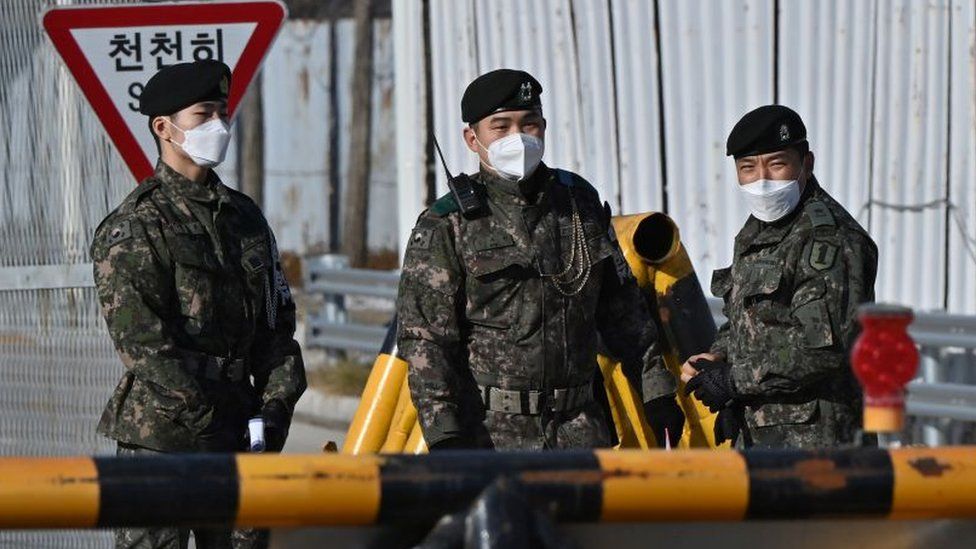 IMAGE SOURCE,GETTY IMAGES
IMAGE SOURCE,GETTY IMAGES
Image caption,
South Korean troops searched for the person in the DMZ but were unable to find them
A South Korean citizen has crossed the heavily fortified border into North Korea in an apparent defection, South Korea's military says.
The person was able to evade detection for several hours despite a search operation by South Korean troops.
Military chiefs in Seoul said they did not know if the person was still alive, but had sent a message to the North asking for them to be protected.
North Korea has implemented a shoot-on-sight policy during the pandemic.
The person was detected in the Demilitarised Zone (DMZ), which separates the two Koreas, at a point on the east coast at about 21:20 local time (12:20 GMT) on Saturday, South Korea's Joint Chiefs of Staff (JCS) said.
Defence officials in Seoul had pledged to overhaul the border defence system after similar breaches in the past.
In September 2020 North Korean troops shot and burned a South Korean fisheries official who went missing at sea. The incident sparked uproar. Pyongyang blamed the anti-virus rule and apologised.
North Korea's leader Kim Jong-un had earlier declared a national emergency and sealed off a town after a North Korean defector who Mr Kim said had Covid symptoms crossed into the North from the South.
North Korea's pandemic-related lockdowns and restrictions on movement within the country have also reduced the number of defections from the North to the South.
The border between North and South Korea is one of the most heavily fortified areas in the world. It is filled with landmines, surrounded by electric and barbed wire fencing and surveillance cameras and armed guards are supposed to be on alert 24 hours a day.
South Korean crosses DMZ in rare defection to North Korea
Published6 hours ago
Share

Image caption,
South Korean troops searched for the person in the DMZ but were unable to find them
A South Korean citizen has crossed the heavily fortified border into North Korea in an apparent defection, South Korea's military says.
The person was able to evade detection for several hours despite a search operation by South Korean troops.
Military chiefs in Seoul said they did not know if the person was still alive, but had sent a message to the North asking for them to be protected.
North Korea has implemented a shoot-on-sight policy during the pandemic.
The person was detected in the Demilitarised Zone (DMZ), which separates the two Koreas, at a point on the east coast at about 21:20 local time (12:20 GMT) on Saturday, South Korea's Joint Chiefs of Staff (JCS) said.
Defence officials in Seoul had pledged to overhaul the border defence system after similar breaches in the past.
In September 2020 North Korean troops shot and burned a South Korean fisheries official who went missing at sea. The incident sparked uproar. Pyongyang blamed the anti-virus rule and apologised.
North Korea's leader Kim Jong-un had earlier declared a national emergency and sealed off a town after a North Korean defector who Mr Kim said had Covid symptoms crossed into the North from the South.
North Korea's pandemic-related lockdowns and restrictions on movement within the country have also reduced the number of defections from the North to the South.
The border between North and South Korea is one of the most heavily fortified areas in the world. It is filled with landmines, surrounded by electric and barbed wire fencing and surveillance cameras and armed guards are supposed to be on alert 24 hours a day.
jward
passin' thru
DogeApex
@Apex_WW
1m
South Korean crosses armed border in rare defection to North
View: https://twitter.com/Apex_WW/status/1477472956079091714?s=20
@IntelDoge
26m
North Korea yet to respond to South Korean messages regarding this circumstance.
Starting to wonder if this isn't a case of an agent returning to the DPRK. ROK didn't notice the defection for 3+ hours, plausible that the person that crossed the border knew what they were doing and knew how to evade such detection measures?
DPRK being silent on this is weird, but the North ignoring the South is nothing new so I'm trying not to look into that a ton, but it does make me a little more suspicious.
Since this involves more than just Taiwan I'm posting it in this thread..... HC
Posted for fair use.....
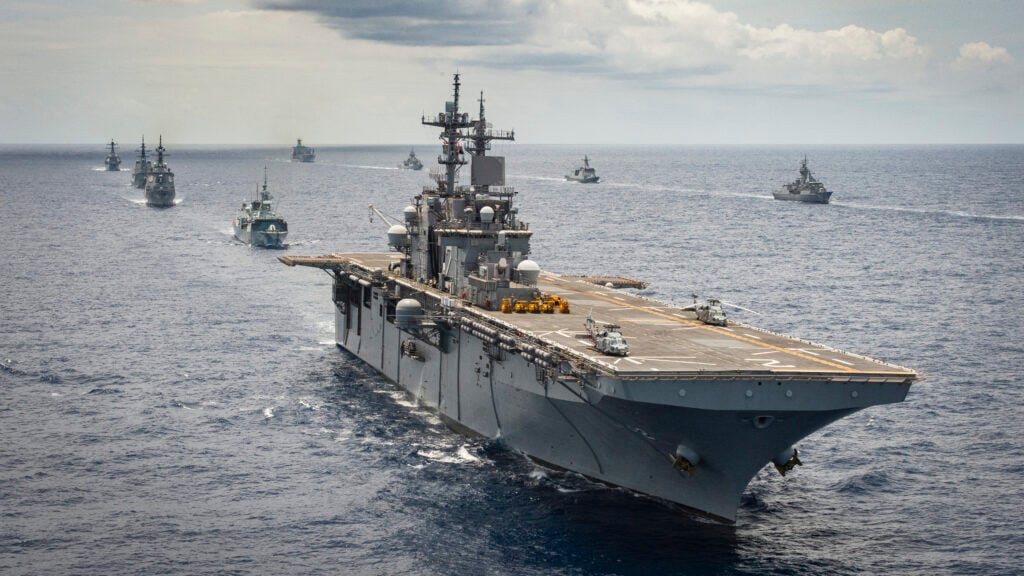
 breakingdefense.com
breakingdefense.com
Managing China, whether through threats or talk: 2022 Preview
Expect the political battle over the island nations like Fiji or the Solomons to be a big part of Chinese-American geopolitics in the new year.
By COLIN CLARK
on December 30, 2021 at 11:44 AM
MELBOURNE: There are few left in the Indo-Pacific outside of the People’s Republic who believe China is a benevolent power intent on complying with and enhancing international law and bolstering its neighbors.
The trend seems pretty clear: Beijing will deploy money, lots of verbal threats and weapons to get its neighbors to do what it thinks they should do, all while bolstering China’s domestic economic situation.
How are the governments of the South China Sea and the Pacific behaving in the face of this conduct? We’ve seen Australia bind itself much more closely to the United States by enhancing ties through the AUKUS agreement. Two newspapers reported this week that Japan and the US have agreed to a plan to deal with a “Taiwan emergency.” While neither government has confirmed the reports, the stories appear to be well sourced and are in reputable news outlets.
[This article is one of many in a series in which Breaking Defense reporters look back on the most significant (and entertaining) news stories of 2021 and look forward to what 2022 may hold.]
In the smaller states of the Pacific — much more vulnerable to blunt tools of influence than the Philippines, Vietnam, South Korea or Japan — the battle is more visible. Take Fiji, for example. In 2020, two Chinese diplomats reportedly attacked and seriously injured a Taiwanese delegate at the Grand Pacific Hotel, site of a celebration of Taiwan’s national day. The government in Fiji did not take action, something seen as a kowtow to Beijing. In next year’s likely elections, Fiji’s former leader Sitiveni Rabuka may well take a different approach to current Prime Minister Frank Bainimaramar, and push back against China’s tentacular offers of cash and aid.
While Fiji may move away from Beijing, elsewhere in the region the PRC continues to find success. Riots erupted last month in the capital of the Solomons after its prime minister declared he would seek diplomatic relations with Beijing. On Christmas Eve, the island state declared Beijing will send a half-dozen officers to train the Solomons police in riot control and provide non-lethal assistance.
The question becomes how will America, along with its allies and partners, manage this fundamental conflict between China and other states in the region. The Five Eyes countries seem solidly opposed to China’s efforts to change the liberal international order, embodied by the Treaty of Westphalia, the Geneva Conventions, the Nuremberg Convention and the United Nations. China has long argued it doesn’t have to accept the boundaries of international law because it did not shape them or because they are not congruent with Chinese law.
China’s position on the South China Sea seems to make US and allied diplomacy and military force the likeliest means to successfully influence the PRC. Although there have been several credible predictions that China may actually go to war against Taiwan within the decade, the US, Japan, Australia and other countries are taking actions to make clear to China that the cost of military action would be beyond the PRC’s ability to sustain.
An intriguing signal lies in the just-passed National Defense Authorization Act, which urges the Biden Administration to invite Taiwan to take part in the next RIMPAC, the huge multinational exercise which in the past has included forces from Australia, Brunei, Canada, France, Japan, New Zealand, the Philippines, South Korea, Singapore and the United States. As recently as 2018, China itself had been invited to RIMPAC, but was disinvited that year because of its conduct in the South China Sea.
The Biden Administration and Congress seem intent on vigorously managing China’s pressure on Taiwan and on the liberal international order. Australia, Japan and other allies seem intent on taking similar actions. Does that mean a greater emphasis on threats or on talks? That may depend more on China’s actions than on Washington’s planning.
Posted for fair use.....

Managing China, whether through threats or talk: 2022 Preview - Breaking Defense
Expect the political battle over the island nations like Fiji or the Solomons to be a big part of Chinese-American geopolitics in the new year.
Managing China, whether through threats or talk: 2022 Preview
Expect the political battle over the island nations like Fiji or the Solomons to be a big part of Chinese-American geopolitics in the new year.
By COLIN CLARK
on December 30, 2021 at 11:44 AM
MELBOURNE: There are few left in the Indo-Pacific outside of the People’s Republic who believe China is a benevolent power intent on complying with and enhancing international law and bolstering its neighbors.
The trend seems pretty clear: Beijing will deploy money, lots of verbal threats and weapons to get its neighbors to do what it thinks they should do, all while bolstering China’s domestic economic situation.
How are the governments of the South China Sea and the Pacific behaving in the face of this conduct? We’ve seen Australia bind itself much more closely to the United States by enhancing ties through the AUKUS agreement. Two newspapers reported this week that Japan and the US have agreed to a plan to deal with a “Taiwan emergency.” While neither government has confirmed the reports, the stories appear to be well sourced and are in reputable news outlets.
[This article is one of many in a series in which Breaking Defense reporters look back on the most significant (and entertaining) news stories of 2021 and look forward to what 2022 may hold.]
In the smaller states of the Pacific — much more vulnerable to blunt tools of influence than the Philippines, Vietnam, South Korea or Japan — the battle is more visible. Take Fiji, for example. In 2020, two Chinese diplomats reportedly attacked and seriously injured a Taiwanese delegate at the Grand Pacific Hotel, site of a celebration of Taiwan’s national day. The government in Fiji did not take action, something seen as a kowtow to Beijing. In next year’s likely elections, Fiji’s former leader Sitiveni Rabuka may well take a different approach to current Prime Minister Frank Bainimaramar, and push back against China’s tentacular offers of cash and aid.
While Fiji may move away from Beijing, elsewhere in the region the PRC continues to find success. Riots erupted last month in the capital of the Solomons after its prime minister declared he would seek diplomatic relations with Beijing. On Christmas Eve, the island state declared Beijing will send a half-dozen officers to train the Solomons police in riot control and provide non-lethal assistance.
The question becomes how will America, along with its allies and partners, manage this fundamental conflict between China and other states in the region. The Five Eyes countries seem solidly opposed to China’s efforts to change the liberal international order, embodied by the Treaty of Westphalia, the Geneva Conventions, the Nuremberg Convention and the United Nations. China has long argued it doesn’t have to accept the boundaries of international law because it did not shape them or because they are not congruent with Chinese law.
China’s position on the South China Sea seems to make US and allied diplomacy and military force the likeliest means to successfully influence the PRC. Although there have been several credible predictions that China may actually go to war against Taiwan within the decade, the US, Japan, Australia and other countries are taking actions to make clear to China that the cost of military action would be beyond the PRC’s ability to sustain.
An intriguing signal lies in the just-passed National Defense Authorization Act, which urges the Biden Administration to invite Taiwan to take part in the next RIMPAC, the huge multinational exercise which in the past has included forces from Australia, Brunei, Canada, France, Japan, New Zealand, the Philippines, South Korea, Singapore and the United States. As recently as 2018, China itself had been invited to RIMPAC, but was disinvited that year because of its conduct in the South China Sea.
The Biden Administration and Congress seem intent on vigorously managing China’s pressure on Taiwan and on the liberal international order. Australia, Japan and other allies seem intent on taking similar actions. Does that mean a greater emphasis on threats or on talks? That may depend more on China’s actions than on Washington’s planning.
jward
passin' thru
Global: MilitaryInfo
@Global_Mil_Info
22m
#BREAKING: North Korea has launched an unidentified projectile towards the East Sea according to JCS.
@Global_Mil_Info
22m
#BREAKING: North Korea has launched an unidentified projectile towards the East Sea according to JCS.
Global: MilitaryInfo
@Global_Mil_Info
22m
#BREAKING: North Korea has launched an unidentified projectile towards the East Sea according to JCS.
Posted for fair use.....

North Korea Says It Tested a Hypersonic Missile (Published 2022)
It was the latest in a series of tests the North has conducted this fall.
North Korea Launches Ballistic Missile, the South Says
The North last conducted a test in October, when it fired a newly developed submarine-launched ballistic missile.
By Choe Sang-Hun
Jan. 4, 2022, 8:33 p.m. ET
SEOUL — North Korea launched a ballistic missile off its east coast on Wednesday, the South Korean military said, days after the North’s leader, Kim Jong-un, said his country should focus on bolstering food production in the new year while continuing to strengthen its military power.
South Korea’s military said its analysts and U.S. officials were studying the trajectory and other flight data of the North Korean missile to learn more.
When North Korea last conducted a missile test, on Oct. 19, it tested a newly developed submarine-launched ballistic missile off its east coast in violation of multiple U.N. Security Council resolutions banning the country from developing or testing ballistic missiles or nuclear devices.
“It’s truly regrettable that North Korea has repeatedly launched missiles since last year,” Prime Minister Fumio Kishida of Japan said on Wednesday. “The Japanese government will strengthen warning and surveillance more than ever.”
North Korea has not tested any long-range missiles of the kind that could directly threaten the continental United States since it conducted three intercontinental ballistic missiles in 2017. But since Mr. Kim’s diplomacy with President Donald J. Trump collapsed in 2019, the country has resumed testing mostly short-range missiles, including ones launched from trains rolled out of tunnels.
These tests indicated that the North was developing more sophisticated ways of delivering nuclear and other warheads to South Korea, Japan and American bases, according to defense analysts. Some of the missiles it has tested since 2019 used solid fuel and made midair maneuvers, making them harder to intercept, defense analysts said.

Image
In October, the North tested a submarine-launched ballistic missile in violation of multiple U.N. Security Council resolutions, according to this photograph provided by North Korea’s state media.Credit...Korean Central News Agency, via Reuters
After the I.C.B.M. tests in 2017, Mr. Kim claimed that his country had the ability to launch a nuclear strike against the continental United States. Then he met Mr. Trump three times between 2018 and 2019 to push the United States to ease sanctions imposed under U.N. Security Council resolutions.
The Kim-Trump diplomacy collapsed without an agreement on rolling back the North’s nuclear weapons program or lifting international sanctions imposed on the country. Since then, North Korea has said it would not engage in dialogue again with Washington unless the United States changes its “hostile policy,” including joint military exercises with South Korean and international sanctions.
During a five-day Workers’ Party meeting that ended on Dec. 31 in Pyongyang, the North Korean capital, Mr. Kim said his country should focus on alleviating the country’s chronic food shortages — a problem that he inherited from Kim Jong-il, his father and predecessor, who died 10 years ago, and has yet to fix.
But he also said conditions demanded that “bolstering the state defense capability be further powerfully propelled without a moment’s delay.”
The North’s state media reports on the party meeting did not mention any diplomatic overtures toward the United States or South Korea, indicating that the country would continue to stick to its “self-reliant” policy.
North Korea remains extremely wary of any contact with the outside world during the coronavirus pandemic.
Motoko Rich contributed reporting from Tokyo.
jward
passin' thru
hmm.
Apex
@Apex_WW
2h
RTRS: Australia and Japan are set to sign a treaty to beef up defense and security cooperation at a virtual summit on Thursday
Apex
@Apex_WW
2h
RTRS: Australia and Japan are set to sign a treaty to beef up defense and security cooperation at a virtual summit on Thursday
jward
passin' thru
hmm.
Shashank Joshi
@shashj
9h
“One key recommendation is for the U.S. and Taiwan to threaten to destroy facilities of Taiwan Semiconductor Manufacturing Co. -- the world's most important chipmaker and China's most important supplier -- if Beijing invades.”
View: https://twitter.com/shashj/status/1478473534250926080?s=20
Shashank Joshi
@shashj
9h
“One key recommendation is for the U.S. and Taiwan to threaten to destroy facilities of Taiwan Semiconductor Manufacturing Co. -- the world's most important chipmaker and China's most important supplier -- if Beijing invades.”
View: https://twitter.com/shashj/status/1478473534250926080?s=20
Thus shot yourself in the foot to outgun your enemy?
Military Intelligence at it's finest.
Military Intelligence at it's finest.

hmm.
Shashank Joshi
@shashj
9h
“One key recommendation is for the U.S. and Taiwan to threaten to destroy facilities of Taiwan Semiconductor Manufacturing Co. -- the world's most important chipmaker and China's most important supplier -- if Beijing invades.”
View: https://twitter.com/shashj/status/1478473534250926080?s=20
Heliobas Disciple
TB Fanatic
North Korea Launches Ballistic Missile, the South Says
The North last conducted a test in October, when it fired a newly developed submarine-launched ballistic missile.
By Choe Sang-Hun
Jan. 4, 2022, 8:33 p.m. ET
SEOUL — North Korea launched a ballistic missile off its east coast on Wednesday, the South Korean military said, days after the North’s leader, Kim Jong-un, said his country should focus on bolstering food production in the new year while continuing to strengthen its military power.
South Korea’s military said its analysts and U.S. officials were studying the trajectory and other flight data of the North Korean missile to learn more.
When North Korea last conducted a missile test, on Oct. 19, it tested a newly developed submarine-launched ballistic missile off its east coast in violation of multiple U.N. Security Council resolutions banning the country from developing or testing ballistic missiles or nuclear devices.
“It’s truly regrettable that North Korea has repeatedly launched missiles since last year,” Prime Minister Fumio Kishida of Japan said on Wednesday. “The Japanese government will strengthen warning and surveillance more than ever.”
North Korea has not tested any long-range missiles of the kind that could directly threaten the continental United States since it conducted three intercontinental ballistic missiles in 2017. But since Mr. Kim’s diplomacy with President Donald J. Trump collapsed in 2019, the country has resumed testing mostly short-range missiles, including ones launched from trains rolled out of tunnels.
These tests indicated that the North was developing more sophisticated ways of delivering nuclear and other warheads to South Korea, Japan and American bases, according to defense analysts. Some of the missiles it has tested since 2019 used solid fuel and made midair maneuvers, making them harder to intercept, defense analysts said.

Image
In October, the North tested a submarine-launched ballistic missile in violation of multiple U.N. Security Council resolutions, according to this photograph provided by North Korea’s state media.Credit...Korean Central News Agency, via Reuters
After the I.C.B.M. tests in 2017, Mr. Kim claimed that his country had the ability to launch a nuclear strike against the continental United States. Then he met Mr. Trump three times between 2018 and 2019 to push the United States to ease sanctions imposed under U.N. Security Council resolutions.
The Kim-Trump diplomacy collapsed without an agreement on rolling back the North’s nuclear weapons program or lifting international sanctions imposed on the country. Since then, North Korea has said it would not engage in dialogue again with Washington unless the United States changes its “hostile policy,” including joint military exercises with South Korean and international sanctions.
During a five-day Workers’ Party meeting that ended on Dec. 31 in Pyongyang, the North Korean capital, Mr. Kim said his country should focus on alleviating the country’s chronic food shortages — a problem that he inherited from Kim Jong-il, his father and predecessor, who died 10 years ago, and has yet to fix.
But he also said conditions demanded that “bolstering the state defense capability be further powerfully propelled without a moment’s delay.”
The North’s state media reports on the party meeting did not mention any diplomatic overtures toward the United States or South Korea, indicating that the country would continue to stick to its “self-reliant” policy.
North Korea remains extremely wary of any contact with the outside world during the coronavirus pandemic.
Motoko Rich contributed reporting from Tokyo.
Posted for fair use.....

North Korea Says It Tested a Hypersonic Missile (Published 2022)
It was the latest in a series of tests the North has conducted this fall.www.nytimes.com

North Korea says it tested hypersonic missile
North Korea has successfully tested a hypersonic missile, state media reported Thursday, in the first major weapons test by the nuclear-armed nation this
North Korea says it test-fired hypersonic missile: state media
January 5, 2022 2 hours ago
AFP

Image: North Korea’s Hypersonic Missile
North Korea has successfully tested a hypersonic missile, state media reported Thursday, in the first major weapons test by the nuclear-armed nation this year.
This was the second reported North Korean test of a hypersonic gliding missile to date — following one in September last year — as Pyongyang looks to add the sophisticated weapon to its arsenal despite international sanctions and condemnation.
Hypersonic missiles move far faster and are more agile than standard ones, making them much harder for missile defence systems — on which the United States is spending billions — to intercept.
The missile fired on Wednesday carried a “hypersonic gliding warhead” that “precisely hit a target 700 km away”, the official Korean Central News Agency (KCNA) reported, without specifying the launcher used for the test.
The launch “reconfirmed the flight control and stability of the missile in the active-flight stage and assessed the performance of the new lateral movement technique applied to the detached hypersonic gliding warhead”, KCNA said.
The test also verified the “fuel ampoule system under winter weather conditions”, it added.
Seoul and Tokyo on Wednesday had detected the launch of a suspected ballistic missile from North Korea that fell in the sea east of the Korean peninsula.
Hypersonic missiles are generally defined as travelling more than five times the speed of sound, or Mach 5.
The KCNA report did not mention the speed at which the missile travelled, and assessments of its performance from other nations have yet to be released.
Hypersonic missiles are among the “top priority” tasks in North Korea’s current five-year plan, state media said last year.
After the test of the Hwasong-8 in 2021, the South Korean military said it appeared to be in the early stages of development.
Depending on their design, hypersonic missiles can carry conventional and nuclear warheads, and have the potential to alter the strategic balance.
Russia is generally seen as the world leader in the technology, and the United States is also spending billions on it. China has tested hypersonic glide vehicles as well, according to the US Congressional Research Service.
Some experts caution that hypersonic weapons may have only limited advantages, while others warn that if North Korea fully develops the technology, it would pose a serious threat.
– US condemnation –
The United States had condemned the launch prior to the KCNA report, urging Pyongyang to sit down for talks.
“This launch is in violation of multiple UN Security Council resolutions and poses a threat to the DPRK’s neighbours and the international community,” a State Department spokesperson said, referring to North Korea by its official name.
Dialogue between Washington and Pyongyang remains stalled, following the collapse of talks between North Korean leader Kim Jong Un and then US president Donald Trump in 2019.
Under Trump’s successor Joe Biden, the United States has repeatedly declared its willingness to meet North Korean representatives, while saying it will seek denuclearisation.
But Pyongyang has so far dismissed the offer, accusing Washington of pursuing “hostile” policies.
In the decade since Kim took power, North Korea has made rapid progress in its military technology, at the cost of international sanctions.
Its first weapons test of 2022 followed a year of major arms tests despite severe economic hardship during the coronavirus pandemic.
The worsening economic situation has not blunted those programmes, and North Korea has continued to pursue weapons development, a UN report said in October.
Concerns have grown about a full-blown food crisis in North Korea, and a United Nations human rights expert warned in October that the most vulnerable were “at risk of starvation”.
jward
passin' thru

Global: MilitaryInfo
@Global_Mil_Info
2m
North Korea still has plenty of military advancements to check-off for 2022, per the Eighth Party Congress Guidelines:
- super-large hydrogen bombs.
- multiple-warhead missiles.
- military reconnaissance satellites.
- solid-fueled ICBMs & 15000km ICBMs.
jward
passin' thru
Apex
@Apex_WW
U.S. officials: Despite North Korea claiming it test-fired a hypersonic missile in recent launch, it likely fired a ballistic missile instead
8:01 PM · Jan 5, 2022·Twitter for iPhone
@Apex_WW
U.S. officials: Despite North Korea claiming it test-fired a hypersonic missile in recent launch, it likely fired a ballistic missile instead
8:01 PM · Jan 5, 2022·Twitter for iPhone
northern watch
TB Fanatic
Australia, Japan to sign 'historic' defense, security pact
Australia and Japan will sign a treaty on Thursday to increase defense and security cooperation in a move that has been hailed as “historic” but which might anger China
By The Associated Press
4 January 2022, 23:25
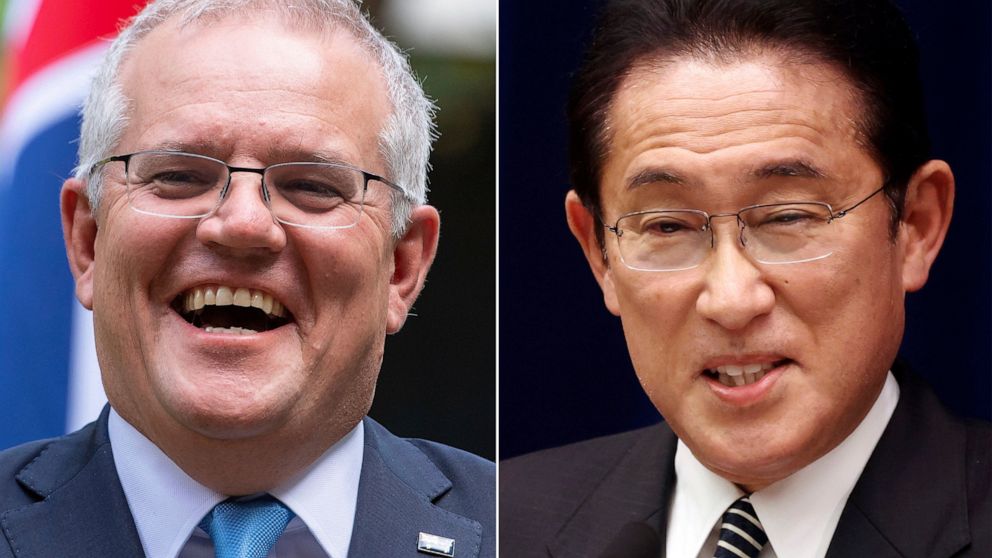
 The Associated Press
The Associated Press
FILE - This combination of photos shows Australian Prime Minister Scott Morrison in London on June 15, 2021 and Japanese Prime Minister Fumio Kishida in Tokyo on Dec. 21, 2021. Australia and Japan will sign a treaty on Thursday, Jan. 6, 2022 to increase defense and security co-operation in a move that has been hailed as "historic" but which might anger China. Morrison and Kishida will meet in a virtual summit to sign the agreement, which Morrison said "will underpin greater and more complex practical engagement between the Australian Defense Force and the Japanese Self-Defense Forces." (Pool Photo via AP, File)
SYDNEY -- Australia and Japan will sign a treaty on Thursday to increase defense and security cooperation in a move that has been hailed as “historic” but which might anger China.
Prime ministers Scott Morrison of Australia and Fumio Kishida of Japan will meet in a virtual summit to sign the agreement, which Morrison said “will underpin greater and more complex practical engagement between the Australian Defense Force and the Japanese Self-Defense Forces."
“Australia and Japan are the closest of friends,” Morrison added. “Our special strategic partnership is stronger than it has ever been, reflecting our shared values, our commitment to democracy and human rights and our common interests in a free, open and resilient Indo-Pacific region.”
In September, Australia signed the so-called Aukus trilateral security pact with the United States and Britain under which those two countries pledged to help Australia acquire nuclear-powered submarines.
The deal upset China, which said that Aukus “seriously undermined regional peace and stability, intensified the arms race and undermined international non-proliferation efforts.”
In a statement on Wednesday, Morrison described the latest treaty with Japan as historic and said “it will, for the first time, provide a clear framework for enhanced interoperability and cooperation between our two forces."
“This treaty will be a statement of our two nations’ commitment to work together in meeting the shared strategic security challenges we face and to contribute to a secure and stable Indo-Pacific," Morrison said.
The U.S. and Australia, along with India and Japan, are also members of a strategic dialogue known as “the Quad," and Morrison said Wednesday that Australia would contribute “an expanding agenda” for that as well.
Australia, Japan to sign 'historic' defense, security pact - ABC News (go.com)
Australia and Japan will sign a treaty on Thursday to increase defense and security cooperation in a move that has been hailed as “historic” but which might anger China
By The Associated Press
4 January 2022, 23:25

FILE - This combination of photos shows Australian Prime Minister Scott Morrison in London on June 15, 2021 and Japanese Prime Minister Fumio Kishida in Tokyo on Dec. 21, 2021. Australia and Japan will sign a treaty on Thursday, Jan. 6, 2022 to increase defense and security co-operation in a move that has been hailed as "historic" but which might anger China. Morrison and Kishida will meet in a virtual summit to sign the agreement, which Morrison said "will underpin greater and more complex practical engagement between the Australian Defense Force and the Japanese Self-Defense Forces." (Pool Photo via AP, File)
SYDNEY -- Australia and Japan will sign a treaty on Thursday to increase defense and security cooperation in a move that has been hailed as “historic” but which might anger China.
Prime ministers Scott Morrison of Australia and Fumio Kishida of Japan will meet in a virtual summit to sign the agreement, which Morrison said “will underpin greater and more complex practical engagement between the Australian Defense Force and the Japanese Self-Defense Forces."
“Australia and Japan are the closest of friends,” Morrison added. “Our special strategic partnership is stronger than it has ever been, reflecting our shared values, our commitment to democracy and human rights and our common interests in a free, open and resilient Indo-Pacific region.”
In September, Australia signed the so-called Aukus trilateral security pact with the United States and Britain under which those two countries pledged to help Australia acquire nuclear-powered submarines.
The deal upset China, which said that Aukus “seriously undermined regional peace and stability, intensified the arms race and undermined international non-proliferation efforts.”
In a statement on Wednesday, Morrison described the latest treaty with Japan as historic and said “it will, for the first time, provide a clear framework for enhanced interoperability and cooperation between our two forces."
“This treaty will be a statement of our two nations’ commitment to work together in meeting the shared strategic security challenges we face and to contribute to a secure and stable Indo-Pacific," Morrison said.
The U.S. and Australia, along with India and Japan, are also members of a strategic dialogue known as “the Quad," and Morrison said Wednesday that Australia would contribute “an expanding agenda” for that as well.
Australia, Japan to sign 'historic' defense, security pact - ABC News (go.com)
jward
passin' thru
S. Korea, U.S., Japan postpone three-way defense ministerial talks
All News 12:11 January 06, 2022
SEOUL, Jan. 6 (Yonhap) -- South Korea, the United States and Japan have postponed their trilateral defense ministerial talks that they had considered holding this month, Seoul's defense ministry said Thursday.
Japanese media outlets reported earlier that the three countries have decided to delay the talks set to take place next Thursday in Hawaii due to the spread of the omicron variant.
"There were not any discussions yet as to when to rearrange the talks," Col. Moon Hong-sik, the ministry's deputy spokesperson, told a regular press briefing. "We have decided to have related consultations at an appropriate time."
Earlier this week, U.S. Defense Secretary Lloyd Austin said that he tested positive for COVID-19.
The three countries had considered arranging the defense talks as Washington is striving to rally its allies and partner countries to counter China's assertiveness amid an intensifying great-power rivalry.
The three countries last held a trilateral defense ministerial meeting on the margins of security talks involving the Association of Southeast Asian Nations in Bangkok in November 2019.
This photo, released by North Korea's official Korean Central News Agency on Jan. 6, 2022, shows what the North claims to be a new hypersonic missile being launched the previous day, three months after it first showcased the new weapons system. The report came after South Korea's military said the North fired what appeared to be a ballistic missile toward the East Sea from the northern province of Jagang. (For Use Only in the Republic of Korea. No Redistribution) (Yonhap)
colin@yna.co.kr
(END)
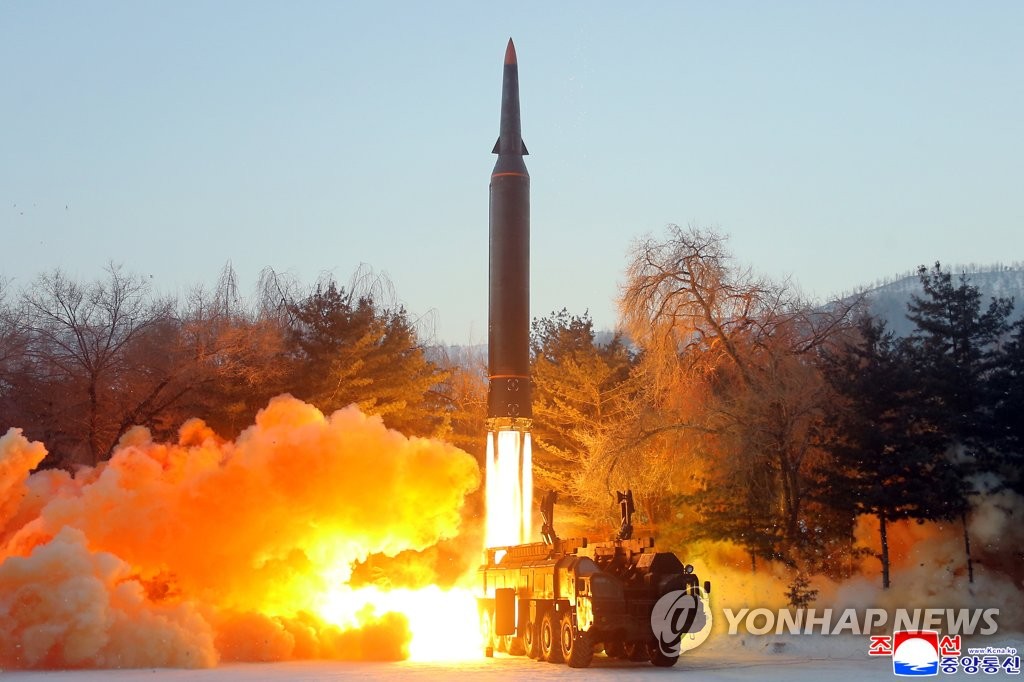
 en.yna.co.kr
en.yna.co.kr
All News 12:11 January 06, 2022
SEOUL, Jan. 6 (Yonhap) -- South Korea, the United States and Japan have postponed their trilateral defense ministerial talks that they had considered holding this month, Seoul's defense ministry said Thursday.
Japanese media outlets reported earlier that the three countries have decided to delay the talks set to take place next Thursday in Hawaii due to the spread of the omicron variant.
"There were not any discussions yet as to when to rearrange the talks," Col. Moon Hong-sik, the ministry's deputy spokesperson, told a regular press briefing. "We have decided to have related consultations at an appropriate time."
Earlier this week, U.S. Defense Secretary Lloyd Austin said that he tested positive for COVID-19.
The three countries had considered arranging the defense talks as Washington is striving to rally its allies and partner countries to counter China's assertiveness amid an intensifying great-power rivalry.
The three countries last held a trilateral defense ministerial meeting on the margins of security talks involving the Association of Southeast Asian Nations in Bangkok in November 2019.
This photo, released by North Korea's official Korean Central News Agency on Jan. 6, 2022, shows what the North claims to be a new hypersonic missile being launched the previous day, three months after it first showcased the new weapons system. The report came after South Korea's military said the North fired what appeared to be a ballistic missile toward the East Sea from the northern province of Jagang. (For Use Only in the Republic of Korea. No Redistribution) (Yonhap)
colin@yna.co.kr
(END)

S. Korea, U.S., Japan postpone three-way defense ministerial talks | Yonhap News Agency
SEOUL, Jan. 6 (Yonhap) -- South Korea, the United States and Japan have postponed their tr...
jward
passin' thru
Dr. Jeff chimes in- interesting thread at link if such things are of interest..a few highlights below:
Dr. Jeffrey Lewis
@ArmsControlWonk
A short thread on North Korea's "hypersonic" missile test. It's a MaRV.

All long-range missiles are hypersonic! The range of a ballistic missile is, to a first approximation, a function of the velocity of a missile at burnout. Any ballistic missile that travels more than a few hundred kilometers will be traveling faster than Mach 5 (1.75 km/s).
View: https://twitter.com/ArmsControlWonk/status/1479152467455713292?s=20
What North Korea tested was a hypersonic glider. The system flew 700 km. The warhead separated at some point and glided for a few hundred kilometers, including a 120 km cross-range glide. I mocked up some trajectories; they're only sort of to scale.
View: https://twitter.com/ArmsControlWonk/status/1479152473977798656?s=20
While "hypersonic" is the buzzword of the moment, there is a growing interest creating reentry vehicles that can execute extreme maneuvers. The US has published about these capabilities. And so has South Korea.
View: https://twitter.com/ArmsControlWonk/status/1479152509444935689?s=20
While the US and ROK papers are describing much fancier maneuvers than the simple turn made by the DPRK glider, I still can think of uses for a 120 km cross-range maneuver on a 700 km trajectory.
View: https://twitter.com/ArmsControlWonk/status/1479152517615345669?s=20
Dr. Jeffrey Lewis
@ArmsControlWonk
A short thread on North Korea's "hypersonic" missile test. It's a MaRV.

All long-range missiles are hypersonic! The range of a ballistic missile is, to a first approximation, a function of the velocity of a missile at burnout. Any ballistic missile that travels more than a few hundred kilometers will be traveling faster than Mach 5 (1.75 km/s).
View: https://twitter.com/ArmsControlWonk/status/1479152467455713292?s=20
What North Korea tested was a hypersonic glider. The system flew 700 km. The warhead separated at some point and glided for a few hundred kilometers, including a 120 km cross-range glide. I mocked up some trajectories; they're only sort of to scale.
View: https://twitter.com/ArmsControlWonk/status/1479152473977798656?s=20
While "hypersonic" is the buzzword of the moment, there is a growing interest creating reentry vehicles that can execute extreme maneuvers. The US has published about these capabilities. And so has South Korea.
View: https://twitter.com/ArmsControlWonk/status/1479152509444935689?s=20
While the US and ROK papers are describing much fancier maneuvers than the simple turn made by the DPRK glider, I still can think of uses for a 120 km cross-range maneuver on a 700 km trajectory.
View: https://twitter.com/ArmsControlWonk/status/1479152517615345669?s=20
danielboon
TB Fanatic
EndGameWW3
@EndGameWW3
·
22m
Mystery Surrounds FAA Order To Halt All West Coast Air Traffic After North Korean Missile Launch
@EndGameWW3
·
22m
Mystery Surrounds FAA Order To Halt All West Coast Air Traffic After North Korean Missile Launch
FAA Briefly Grounds Flights After Suspected NKorea Missile Launch
A brief, full ground stop at all West Coast airports was ordered by the FAA on Monday after a suspected ballistic missile launch by North Korea.
FAA Briefly Grounds Flights After Suspected NKorea Missile Launch
(Dreamstime)
By Jeffrey Rodack | Tuesday, 11 January 2022 07:58 AM
A brief full ground stop at all West Coast airports was ordered by the FAA on Monday after a suspected ballistic missile launch by North Korea, Newsweek is reporting.
Sabrina LoPiccolo, spokeswoman for the San Diego International Airport, told Newsweek that the airport was instructed of a ground stop at about 2:30 p.m. Pacific Time.
There was no reason was given for the stop, which lasted about five to seven minutes, she said.
"We really don't have any more details," she said.
And KCRA-TV reported flights were briefly grounded at Sacramento International Airport and San Francisco International Airport. An on-duty manager at San Francisco Airport said it was a nationwide issue.
According to Newsweek, an FAA ground stop is an order that directs flights scheduled to land at specific airports to stay at their departure point.
Ground stops ordered for an airport or region and can be due to weather, equipment outages, or extreme events.
The FAA did not disclose any other details on the ground stop and did not respond to a request for comment from Newsweek on Monday evening.
North Korea had launched what appeared to be a ballistic missile into its eastern sea, its second weapons launch in a week, the militaries of South Korea and Japan said, The Associated Press reported.
Japan's Prime Minister’s Office and Defense Ministry said the North Korean weapon was possibly a ballistic missile.
The firing of the missile came after North Korea launched a ballistic missile into the sea six days earlier.
Zagdid
Veteran Member

Taiwan’s most advanced fighter jet crashes, with pilot unaccounted for
The F-16V, commissioned last month to boost defence in the face of threats from Beijing, ‘rapidly slanted into the sea’ during training mission, air force says.
Taiwan’s most advanced fighter jet crashes, with pilot unaccounted for
Lawrence Chung
Published: 7:12pm, 11 Jan, 2022
- F-16V jet ‘rapidly slanted into the sea’ off west coast during training mission, air force says
- The plane is one of the F-16s upgraded under a deal with Lockheed Martin and commissioned last month to boost defence in the face of threats from Beijing
The crash, by an F-16V – Taiwan’s most advanced fighter jet – dealt a blow to the self-ruled island’s military, which has hoped to use the warplanes to counter growing pressure from China’s People’s Liberation Army (PLA).
China has been sending warplanes to Taiwan’s air defence identification zone almost daily, which is seen as designed not only to ramp up pressure on the island but also to exhaust its air force and pilots.
The plane lost contact with its airbase in southwestern Taiwan in the afternoon and the pilot had yet to be located, the island’s air force said on Tuesday. Eyewitnesses had reported seeing a plane crash into the sea.
“The single-seated F-16V (serial number 6650) operated by Captain Chen Yi took off from its home base in Chiayi at 2.55pm for a routine training mission and was missing near the Shuaixi firing target zone at 3.23pm,” the air force said in a statement.
Air force officials said the pilot was taking part in firing training at the target zone before losing contact.
“The pilot was practising simulated air-to-ground blasting, and visibility at that time was fine,” Inspector General Liu Hui-chien told a press conference at which he gave the air force’s initial assessment.
“When he proceeded to the part which required him to fire at a 20-degree angle, his plane rapidly slanted into the sea.”
Liu said the pilot of a consort plane reported no sign of the officer being ejected from his aircraft before it crashed, and it was not yet known what had caused it.
The aircraft had been upgraded to the “V” version only in November, with new weapons systems and electronics, Liu said, adding that all combat training for the F-16 fleet had been suspended. All F-16 jets have been grounded for inspection.
A spokesman for Taiwan’s presidential office said that search and rescue missions had been carried out.
He said that President Tsai Ing-wen, who is head commander of the island’s forces, had ordered rescuers to do all they could to search for the plane and pilot.
According to the island’s National Rescue Command Centre, the air force control tower radar last spotted the fighter jet over the sea off Dongshih, on Taiwan’s west coast.
“Eyewitnesses reported a warplane plunging into the sea [near Dongshih],” the centre said. “The defence ministry has sent two helicopters there for the rescue mission.”
The Taiwanese coastguard and police had also joined the search for the plane, it said.
This was the first crash by an F-16V and the eighth major accident involving an F-16 jet since 1998. In six of those, the pilot has been killed or unaccounted for.
The missing plane on Tuesday was one of two dozen F-16Vs commissioned by the air force last month to boost defence in the face of growing military threats from Beijing.
It was one of the 141 F-16A/B jets that had been upgraded to the more advanced F-16V under a NT$110 billion (US$4 billion) contract that the Taiwanese air force and plane builder Aerospace Industrial Development Corporation (AIDC) signed with Lockheed Martin.
AIDC and Lockheed Martin have so far completed the upgrading of 64 jets, according to the air force.
In addition to the retrofitting, the air force has ordered 66 new F-16Vs to bolster Taiwan’s ability to repel the PLA, including its J-20 stealth fighter. Delivery of the jets, in a deal worth US$8 billion, is expected to start next year.
Chieh Chung, a national security researcher at the National Policy Foundation – a think tank of Taiwan’s main opposition party the Kuomintang – said F-16Vs had more sophisticated engines and fuel tanks than the previous F-16As/Bs, allowing them to carry more fuel and fly farther. Its radar offered improved precision-strike capability, he said.
northern watch
TB Fanatic
jward
passin' thru
(7th LD) N. Korea's improved ballistic missile traveled at Mach 10: JCS
All News 16:23 January 11, 2022
(ATTN: UPDATES with more details in paras 5-8)
By Song Sang-ho
SEOUL, Jan. 11 (Yonhap) -- North Korea's ballistic missile launched Tuesday flew at a top speed of Mach 10, South Korea's military said, taking note of "improvement" compared with what it claimed to be a hypersonic missile test six days ago.
The Joint Chiefs of Staff (JCS) said the North fired the missile from its northern province of Jagang into the East Sea, and that it flew more than 700 kilometers at a maximum altitude of 60 km and at a top speed of Mach 10, 10 times the speed of sound.
The launch was detected at 7:27 a.m, the JCS said. It followed the test-firing of the North's self-proclaimed hypersonic missile, which the JCS said traveled less than 700 km at a top speed of Mach 6.
"We assess that it has improved compared with the ballistic missile launched on Jan. 5," the JCS said in a text message, calling the regime's continued launches of ballistic missiles a "clear" violation of U.N. Security Council resolutions.
The resolutions prohibit the North from conducting any launches using ballistic missile technology.
The JCS' statement drew a contrast from its earlier downplaying of the North's hypersonic missile claims as "exaggeration" and its assessment that the North has yet to secure technologies for the high-tech weapon.
Experts, however, pointed out the speed of Mach 10 is not a definitive element for the categorization of hypersonic missiles, as ordinary medium-range ones typically fly at Mach 9 to 10 during boost phases after liftoff.
"For more details, South Korea and the U.S. need a detailed analysis," a JCS official said on condition of anonymity.
The South Korean military also urged the North to immediately halt its missile launches.
"(The launches) pose a significant threat to peace and security not only on the Korean Peninsula but also in the world, and are not helpful for the reduction of military tensions," it said.
The U.S. Indo-Pacific Command characterized the North's latest projectile as a "ballistic missile," which it said highlights the "destabilizing impact" of the North's illicit weapons program.
This undated file photo, released by North Korea's official Korean Central News Agency, shows a missile launch. (For Use Only in the Republic of Korea. No Redistribution) (Yonhap)
1 of 2
The South's presidential National Security Council soon convened an emergency meeting and expressed "strong regret."
The latest launch came as the UN Security Council held a closed-door session on Pyongyang's missile launch last week.
Shortly before the session, the U.S. and five other countries issued a joint statement calling on the North to refrain from "destabilizing" actions, abandon its ballistic missile programs and engage in "meaningful" dialogue toward denuclearization.
South Korea, meanwhile, voiced regret over another missile launch by the North and called on it to return to the dialogue table.
The Ministry of Unification reiterated improving inter-Korean relations to an "irrevocable level" is crucial to fundamentally resolving concerns stemming from such missile launches.
"North Korea should choose cooperation for peace over acts that go against efforts to build peace on the Korean Peninsula, such as the latest missile launches, at this critical moment to stabilize the political situation surrounding the peninsula," a unification ministry official told reporters.
Pyongyang's latest saber-rattling came as the North unveiled its ambitious push to develop an array of new formidable weapons during the eighth congress of the ruling Workers' Party a year ago.
During the congress, the North catalogued "important strategic tasks," such as developing tactical nuclear weapons, a hypersonic gliding flight warhead, a nuclear-powered submarine and a reconnaissance satellite, according to its state media.
At the close of the ruling party's Central Committee plenary late last month, North Korean leader Kim Jong-un redoubled calls to bolster defense capabilities "without a moment's delay," pointing to unstable international security conditions.
"(The latest launches) are an expression of the North's resolve to forge ahead with the missile activities in line with an institutionalized defense plan irrespective of the external environment," Park Won-gon, a professor of North Korea studies at Ewha Womans University, said.
The North's missile launch handed yet another dispiriting setback to the South's steadfast drive to resume nuclear diplomacy with the recalcitrant regime.
Nuclear negotiations between Washington and Pyongyang have been stalled since the no-deal Hanoi summit between the two countries in February 2019.
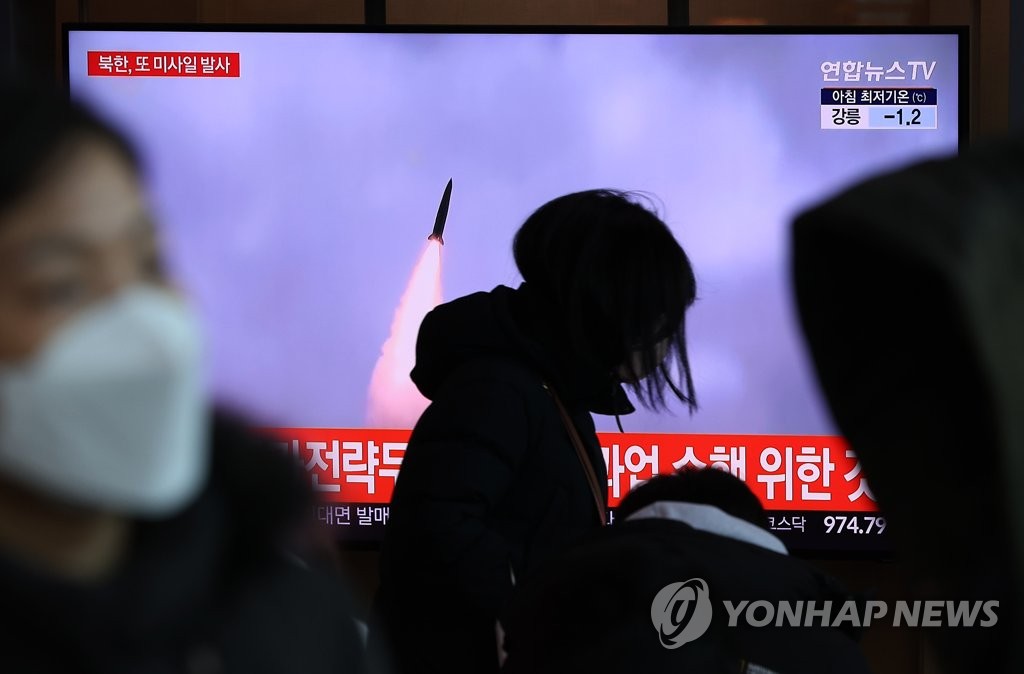
 en.yna.co.kr
en.yna.co.kr
All News 16:23 January 11, 2022
(ATTN: UPDATES with more details in paras 5-8)
By Song Sang-ho
SEOUL, Jan. 11 (Yonhap) -- North Korea's ballistic missile launched Tuesday flew at a top speed of Mach 10, South Korea's military said, taking note of "improvement" compared with what it claimed to be a hypersonic missile test six days ago.
The Joint Chiefs of Staff (JCS) said the North fired the missile from its northern province of Jagang into the East Sea, and that it flew more than 700 kilometers at a maximum altitude of 60 km and at a top speed of Mach 10, 10 times the speed of sound.
The launch was detected at 7:27 a.m, the JCS said. It followed the test-firing of the North's self-proclaimed hypersonic missile, which the JCS said traveled less than 700 km at a top speed of Mach 6.
"We assess that it has improved compared with the ballistic missile launched on Jan. 5," the JCS said in a text message, calling the regime's continued launches of ballistic missiles a "clear" violation of U.N. Security Council resolutions.
The resolutions prohibit the North from conducting any launches using ballistic missile technology.
The JCS' statement drew a contrast from its earlier downplaying of the North's hypersonic missile claims as "exaggeration" and its assessment that the North has yet to secure technologies for the high-tech weapon.
Experts, however, pointed out the speed of Mach 10 is not a definitive element for the categorization of hypersonic missiles, as ordinary medium-range ones typically fly at Mach 9 to 10 during boost phases after liftoff.
"For more details, South Korea and the U.S. need a detailed analysis," a JCS official said on condition of anonymity.
The South Korean military also urged the North to immediately halt its missile launches.
"(The launches) pose a significant threat to peace and security not only on the Korean Peninsula but also in the world, and are not helpful for the reduction of military tensions," it said.
The U.S. Indo-Pacific Command characterized the North's latest projectile as a "ballistic missile," which it said highlights the "destabilizing impact" of the North's illicit weapons program.
This undated file photo, released by North Korea's official Korean Central News Agency, shows a missile launch. (For Use Only in the Republic of Korea. No Redistribution) (Yonhap)
1 of 2
The South's presidential National Security Council soon convened an emergency meeting and expressed "strong regret."
The latest launch came as the UN Security Council held a closed-door session on Pyongyang's missile launch last week.
Shortly before the session, the U.S. and five other countries issued a joint statement calling on the North to refrain from "destabilizing" actions, abandon its ballistic missile programs and engage in "meaningful" dialogue toward denuclearization.
South Korea, meanwhile, voiced regret over another missile launch by the North and called on it to return to the dialogue table.
The Ministry of Unification reiterated improving inter-Korean relations to an "irrevocable level" is crucial to fundamentally resolving concerns stemming from such missile launches.
"North Korea should choose cooperation for peace over acts that go against efforts to build peace on the Korean Peninsula, such as the latest missile launches, at this critical moment to stabilize the political situation surrounding the peninsula," a unification ministry official told reporters.
Pyongyang's latest saber-rattling came as the North unveiled its ambitious push to develop an array of new formidable weapons during the eighth congress of the ruling Workers' Party a year ago.
During the congress, the North catalogued "important strategic tasks," such as developing tactical nuclear weapons, a hypersonic gliding flight warhead, a nuclear-powered submarine and a reconnaissance satellite, according to its state media.
At the close of the ruling party's Central Committee plenary late last month, North Korean leader Kim Jong-un redoubled calls to bolster defense capabilities "without a moment's delay," pointing to unstable international security conditions.
"(The latest launches) are an expression of the North's resolve to forge ahead with the missile activities in line with an institutionalized defense plan irrespective of the external environment," Park Won-gon, a professor of North Korea studies at Ewha Womans University, said.
The North's missile launch handed yet another dispiriting setback to the South's steadfast drive to resume nuclear diplomacy with the recalcitrant regime.
Nuclear negotiations between Washington and Pyongyang have been stalled since the no-deal Hanoi summit between the two countries in February 2019.

(7th LD) N. Korea's improved ballistic missile traveled at Mach 10: JCS | Yonhap News Agency
(ATTN: UPDATES with more details in paras 5-8)By Song Sang-ho SEOUL, Jan. 11 (Yonhap) --...
jward
passin' thru
US military tracking Russian spy vessel near Hawaii
by
Kevin Knodell
• The Honolulu Star-Advertiser • January 11, 2022
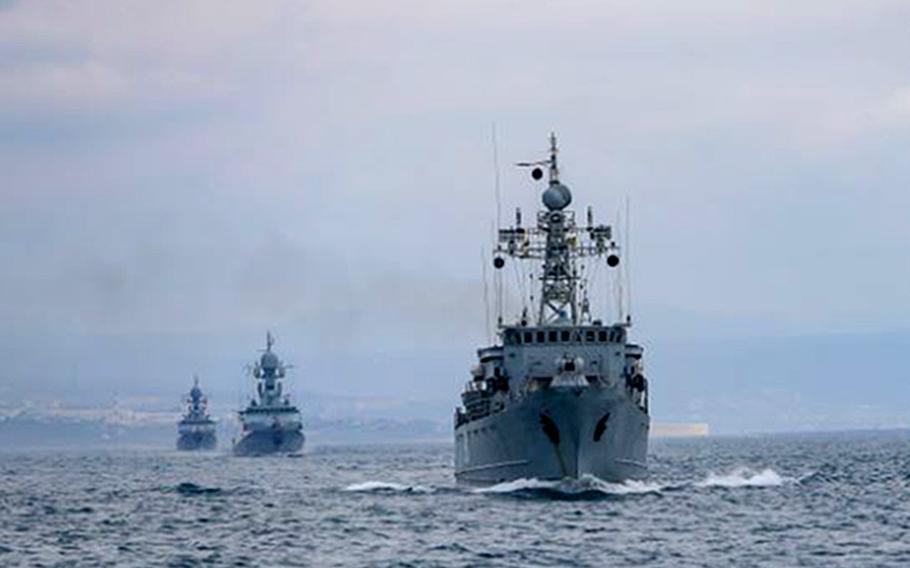
Ships of the Russian Black Sea Fleet train during an exercise in the sea in April 2021. The U.S. military is tracking a Russian spy ship in the Pacific Ocean near Hawaii. (Russian Defense Ministry)






(Tribune News Service) — The U.S. military is tracking a Russian spy ship in the Pacific Ocean near Hawaii, officials confirmed to the Star-Advertiser today.
The vessel has been in waters just outside of the Hawaii's exclusive economic zone while commanders have monitored movements since at least Friday.
"U.S. Indo-Pacific Command is monitoring the Russian vessel operating in international waters in the vicinity of Hawaii," INDOPACOM spokesman Maj. Rob Martins said. "As part of our normal daily operations, we closely track all vessels in the Indo-Pacific area of operations through maritime patrol aircraft, surface ships and joint capabilities. We operate in accordance with international law of the sea and in the air to ensure that all nations can do the same without fear or contest and in order to secure a free and open Indo-Pacific."
In May, the U.S. Pacific Fleet tracked the Vladivostok-based Russian spy ship the Kareliya, which was lingering about 15 miles to the west of Kauai. The island is home to the Pacific Missile Range Facility Barking Sands, which is used by the Navy and the Missile Defense Agency to test-fire missiles.
The Kareliya's presence prompted American commanders to delay a planned missile test.
That incident preceded the arrival of dozens of warships from Russia's Pacific Fleet in June that conducted what Russian officials described as the largest exercise its navy has conducted in the Pacific since the end of the Cold War.
American jets scrambled several times in response to Russian bombers flying close to Hawaii's airspace. And after the majority of the warships left at the end of the exercise, a spy ship stayed behind to monitor maneuvers by the American aircraft carrier USS Carl Vinson.
That exercise coincided with President Joe Biden's first meeting with Russian President Vladamir Putin since his inauguration. A Russian spy ship also lingered near Hawaii in 2016 to monitor the biennial U.S.-hosted Rim of The Pacific naval exercise.
The latest appearance of a Russian vessel this year comes as the Biden Administration works to diffuse tensions as the Russian military assembles a massive buildup on the border with Ukraine that many Ukrainians fear is the mobilization for an invasion. Russia previously invaded and annexed Ukraine's Crimea region in 2014.
The Pentagon currently considers the Pacific its top priority of operations and considers China to be its main rival in the region, but Russia is still a major player in the region.
The Kremlin maintains military ties and arms trading deals with several countries across Asia and maintains its own sizeable Pacific fleet. American fishermen sailing in the Northern Pacific near Alaska have reported increasing interactions with Russian military ships and aircraft.
Hawaii is a critical hub for U.S. military operations. INDOPACOM, which is headquartered at Camp Smith, oversees all operations across the Pacific Ocean, much of the Indian Ocean and parts of the Arctic region.
The U.S. military is increasingly recognizing connections between these regions as melting polar icecaps have begun to open new trade routes between Europe and the Pacific—along with potential undersea energy deposits that Russia and China are eager to secure.
by
Kevin Knodell
• The Honolulu Star-Advertiser • January 11, 2022

Ships of the Russian Black Sea Fleet train during an exercise in the sea in April 2021. The U.S. military is tracking a Russian spy ship in the Pacific Ocean near Hawaii. (Russian Defense Ministry)
(Tribune News Service) — The U.S. military is tracking a Russian spy ship in the Pacific Ocean near Hawaii, officials confirmed to the Star-Advertiser today.
The vessel has been in waters just outside of the Hawaii's exclusive economic zone while commanders have monitored movements since at least Friday.
"U.S. Indo-Pacific Command is monitoring the Russian vessel operating in international waters in the vicinity of Hawaii," INDOPACOM spokesman Maj. Rob Martins said. "As part of our normal daily operations, we closely track all vessels in the Indo-Pacific area of operations through maritime patrol aircraft, surface ships and joint capabilities. We operate in accordance with international law of the sea and in the air to ensure that all nations can do the same without fear or contest and in order to secure a free and open Indo-Pacific."
In May, the U.S. Pacific Fleet tracked the Vladivostok-based Russian spy ship the Kareliya, which was lingering about 15 miles to the west of Kauai. The island is home to the Pacific Missile Range Facility Barking Sands, which is used by the Navy and the Missile Defense Agency to test-fire missiles.
The Kareliya's presence prompted American commanders to delay a planned missile test.
That incident preceded the arrival of dozens of warships from Russia's Pacific Fleet in June that conducted what Russian officials described as the largest exercise its navy has conducted in the Pacific since the end of the Cold War.
American jets scrambled several times in response to Russian bombers flying close to Hawaii's airspace. And after the majority of the warships left at the end of the exercise, a spy ship stayed behind to monitor maneuvers by the American aircraft carrier USS Carl Vinson.
That exercise coincided with President Joe Biden's first meeting with Russian President Vladamir Putin since his inauguration. A Russian spy ship also lingered near Hawaii in 2016 to monitor the biennial U.S.-hosted Rim of The Pacific naval exercise.
The latest appearance of a Russian vessel this year comes as the Biden Administration works to diffuse tensions as the Russian military assembles a massive buildup on the border with Ukraine that many Ukrainians fear is the mobilization for an invasion. Russia previously invaded and annexed Ukraine's Crimea region in 2014.
The Pentagon currently considers the Pacific its top priority of operations and considers China to be its main rival in the region, but Russia is still a major player in the region.
The Kremlin maintains military ties and arms trading deals with several countries across Asia and maintains its own sizeable Pacific fleet. American fishermen sailing in the Northern Pacific near Alaska have reported increasing interactions with Russian military ships and aircraft.
Hawaii is a critical hub for U.S. military operations. INDOPACOM, which is headquartered at Camp Smith, oversees all operations across the Pacific Ocean, much of the Indian Ocean and parts of the Arctic region.
The U.S. military is increasingly recognizing connections between these regions as melting polar icecaps have begun to open new trade routes between Europe and the Pacific—along with potential undersea energy deposits that Russia and China are eager to secure.
jward
passin' thru
Focus Taiwan (CNA English News)
@Focus_Taiwan
Rescuers found debris belonging to a missing Air Force F-16V fighter on Wednesday morning but there were no signs of its pilot, according to the National Rescue Command Center (NRCC).
View: https://twitter.com/Focus_Taiwan/status/1481131353592987654?s=20
@Focus_Taiwan
Rescuers found debris belonging to a missing Air Force F-16V fighter on Wednesday morning but there were no signs of its pilot, according to the National Rescue Command Center (NRCC).
View: https://twitter.com/Focus_Taiwan/status/1481131353592987654?s=20

Taiwan’s most advanced fighter jet crashes, with pilot unaccounted for
The F-16V, commissioned last month to boost defence in the face of threats from Beijing, ‘rapidly slanted into the sea’ during training mission, air force says.www.scmp.com
Taiwan’s most advanced fighter jet crashes, with pilot unaccounted for
Lawrence Chung
Published: 7:12pm, 11 Jan, 2022
A Taiwanese Air Force fighter jet crashed during a combat training mission on Tuesday, with the pilot unaccounted for and an investigation under way.
- F-16V jet ‘rapidly slanted into the sea’ off west coast during training mission, air force says
- The plane is one of the F-16s upgraded under a deal with Lockheed Martin and commissioned last month to boost defence in the face of threats from Beijing
The crash, by an F-16V – Taiwan’s most advanced fighter jet – dealt a blow to the self-ruled island’s military, which has hoped to use the warplanes to counter growing pressure from China’s People’s Liberation Army (PLA).
China has been sending warplanes to Taiwan’s air defence identification zone almost daily, which is seen as designed not only to ramp up pressure on the island but also to exhaust its air force and pilots.
The plane lost contact with its airbase in southwestern Taiwan in the afternoon and the pilot had yet to be located, the island’s air force said on Tuesday. Eyewitnesses had reported seeing a plane crash into the sea.
“The single-seated F-16V (serial number 6650) operated by Captain Chen Yi took off from its home base in Chiayi at 2.55pm for a routine training mission and was missing near the Shuaixi firing target zone at 3.23pm,” the air force said in a statement.
Air force officials said the pilot was taking part in firing training at the target zone before losing contact.
“The pilot was practising simulated air-to-ground blasting, and visibility at that time was fine,” Inspector General Liu Hui-chien told a press conference at which he gave the air force’s initial assessment.
“When he proceeded to the part which required him to fire at a 20-degree angle, his plane rapidly slanted into the sea.”
Liu said the pilot of a consort plane reported no sign of the officer being ejected from his aircraft before it crashed, and it was not yet known what had caused it.
The aircraft had been upgraded to the “V” version only in November, with new weapons systems and electronics, Liu said, adding that all combat training for the F-16 fleet had been suspended. All F-16 jets have been grounded for inspection.
A spokesman for Taiwan’s presidential office said that search and rescue missions had been carried out.
He said that President Tsai Ing-wen, who is head commander of the island’s forces, had ordered rescuers to do all they could to search for the plane and pilot.
According to the island’s National Rescue Command Centre, the air force control tower radar last spotted the fighter jet over the sea off Dongshih, on Taiwan’s west coast.
“Eyewitnesses reported a warplane plunging into the sea [near Dongshih],” the centre said. “The defence ministry has sent two helicopters there for the rescue mission.”
The Taiwanese coastguard and police had also joined the search for the plane, it said.
This was the first crash by an F-16V and the eighth major accident involving an F-16 jet since 1998. In six of those, the pilot has been killed or unaccounted for.
The missing plane on Tuesday was one of two dozen F-16Vs commissioned by the air force last month to boost defence in the face of growing military threats from Beijing.
It was one of the 141 F-16A/B jets that had been upgraded to the more advanced F-16V under a NT$110 billion (US$4 billion) contract that the Taiwanese air force and plane builder Aerospace Industrial Development Corporation (AIDC) signed with Lockheed Martin.
AIDC and Lockheed Martin have so far completed the upgrading of 64 jets, according to the air force.
In addition to the retrofitting, the air force has ordered 66 new F-16Vs to bolster Taiwan’s ability to repel the PLA, including its J-20 stealth fighter. Delivery of the jets, in a deal worth US$8 billion, is expected to start next year.
Chieh Chung, a national security researcher at the National Policy Foundation – a think tank of Taiwan’s main opposition party the Kuomintang – said F-16Vs had more sophisticated engines and fuel tanks than the previous F-16As/Bs, allowing them to carry more fuel and fly farther. Its radar offered improved precision-strike capability, he said.
jward
passin' thru
consensus of expert opinion relay that the most recent test was NOT "Glidey McGlideface" :: shrugs n shakes head ::
Please note that the year should read 2022
Dr. Jeffrey Lewis
@ArmsControlWonk
Based on the poor quality images, I am inclined to agree with@nktpnd . The most recent DPRK test was of our friend Marv, from January, rather than the HGV ("Glidey McGlideface") from September.
View: https://twitter.com/ArmsControlWonk/status/1481024386127777792?s=20
Please note that the year should read 2022
Dr. Jeffrey Lewis
@ArmsControlWonk
Based on the poor quality images, I am inclined to agree with@nktpnd . The most recent DPRK test was of our friend Marv, from January, rather than the HGV ("Glidey McGlideface") from September.
View: https://twitter.com/ArmsControlWonk/status/1481024386127777792?s=20

